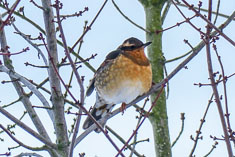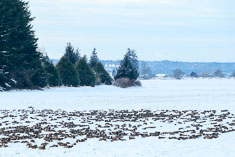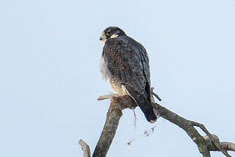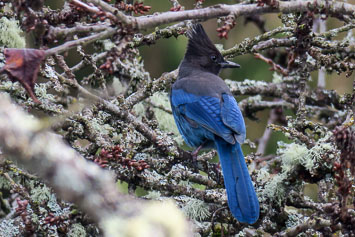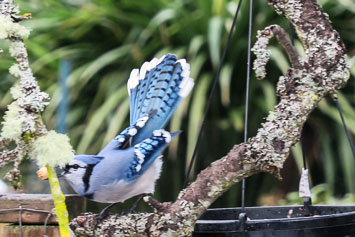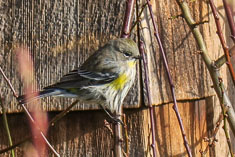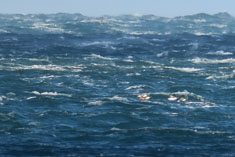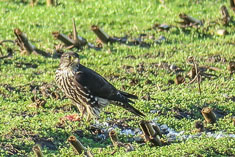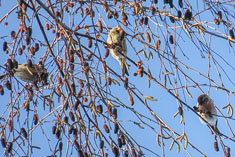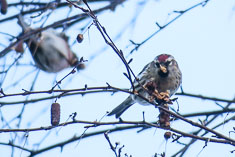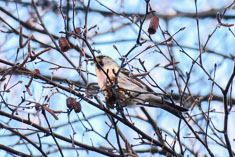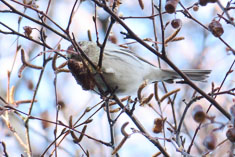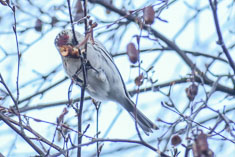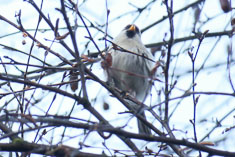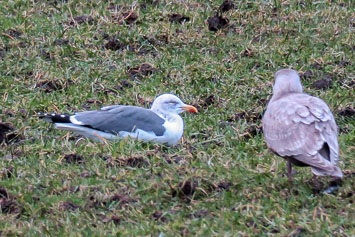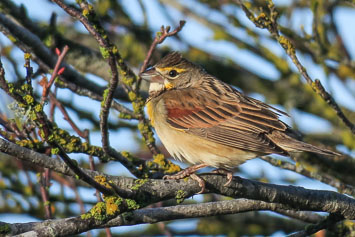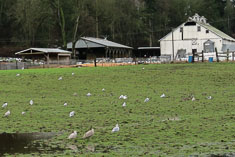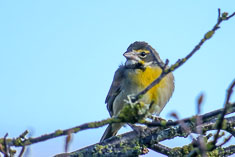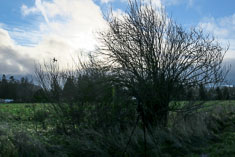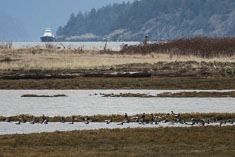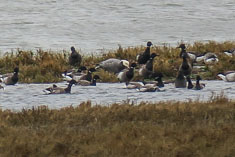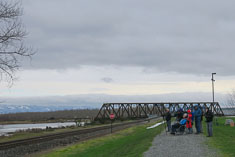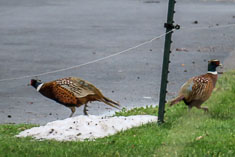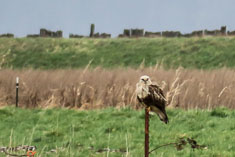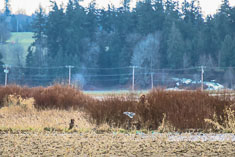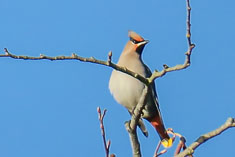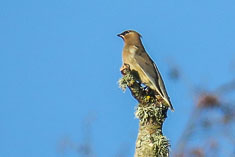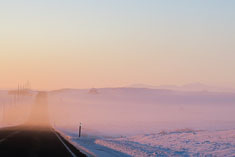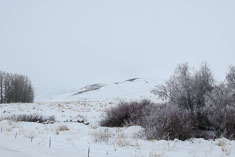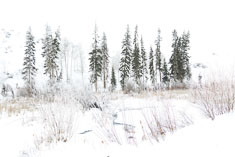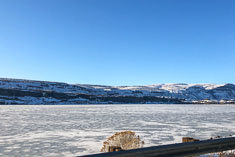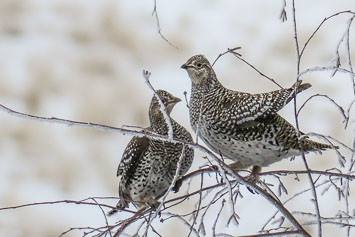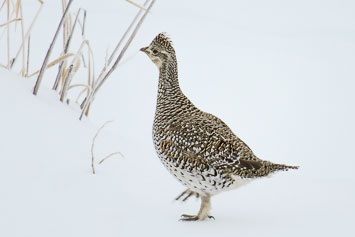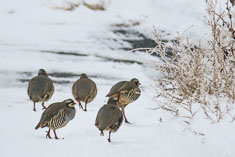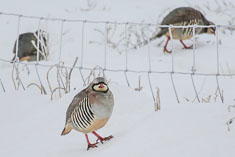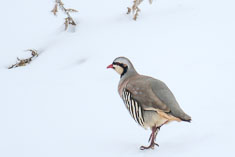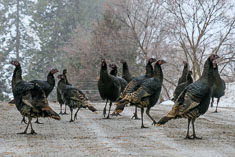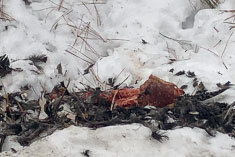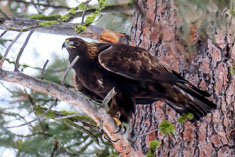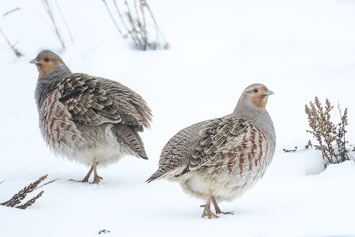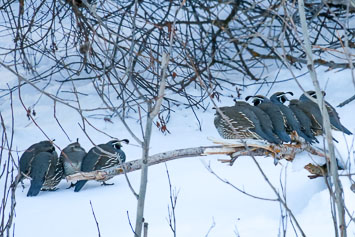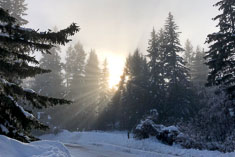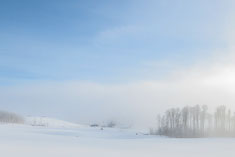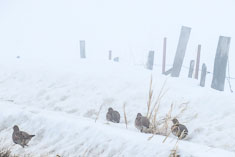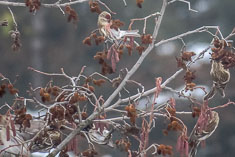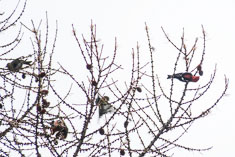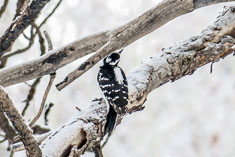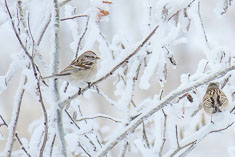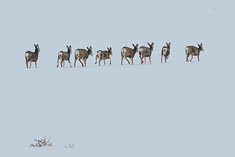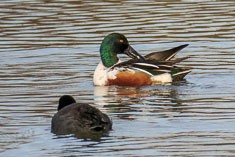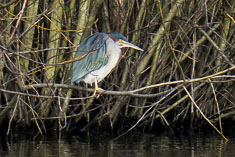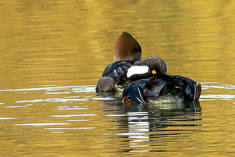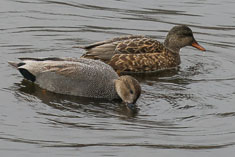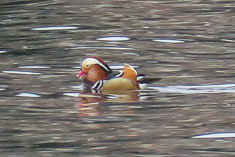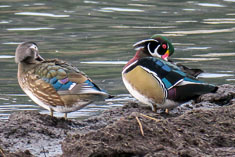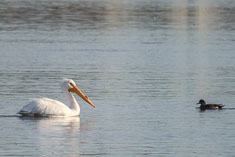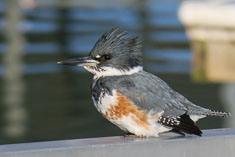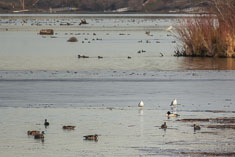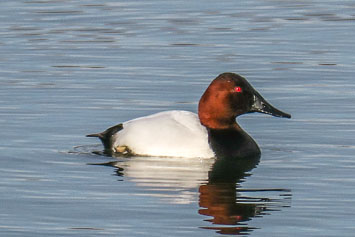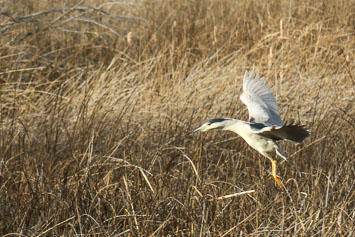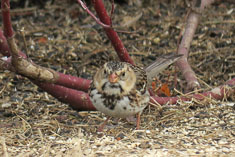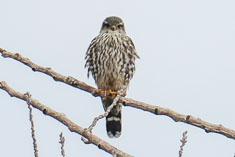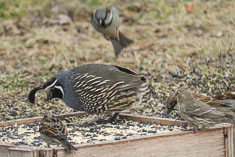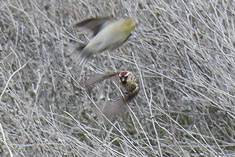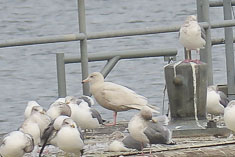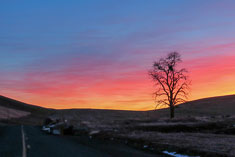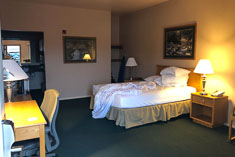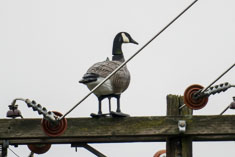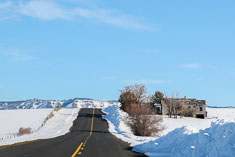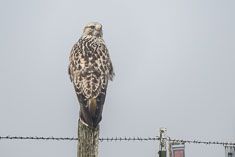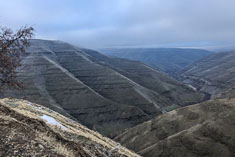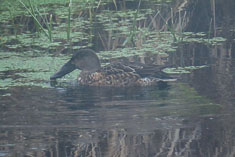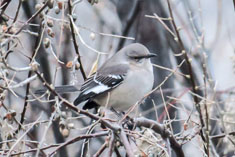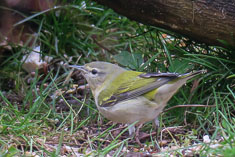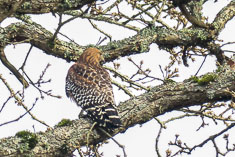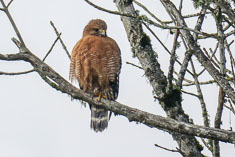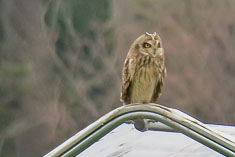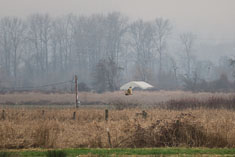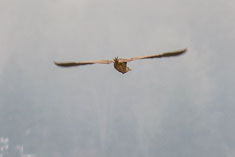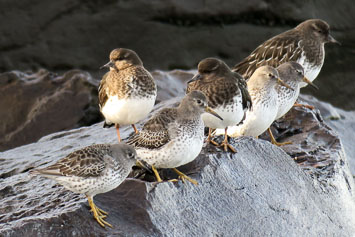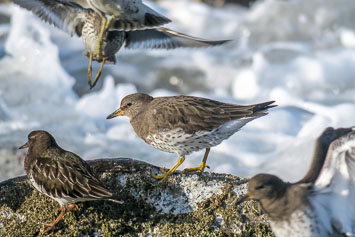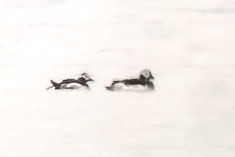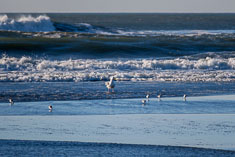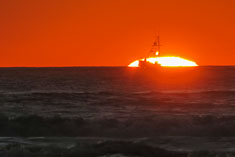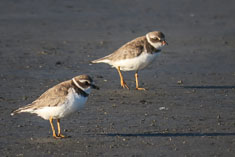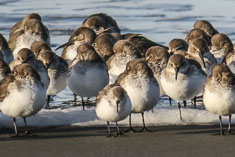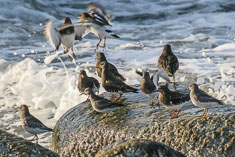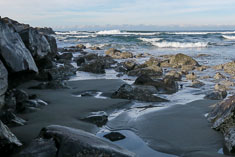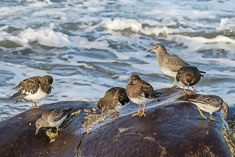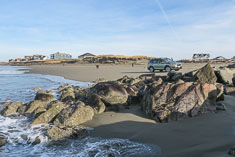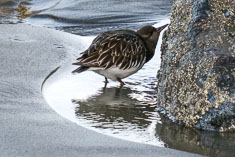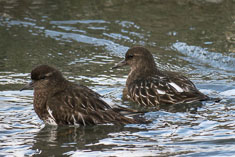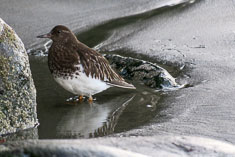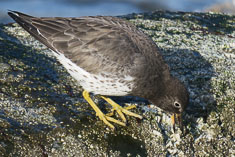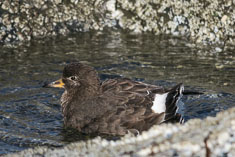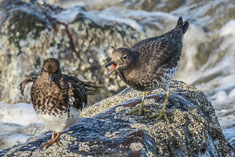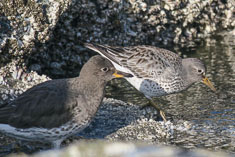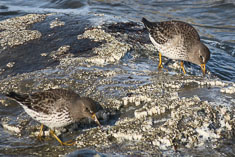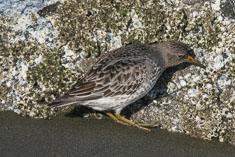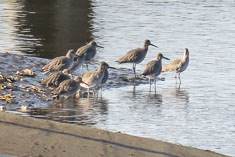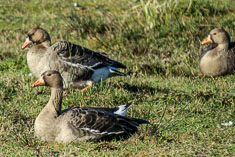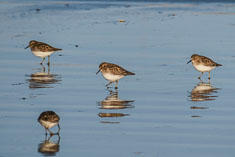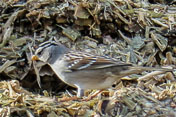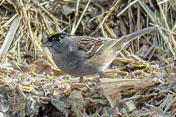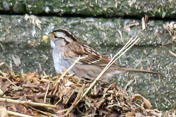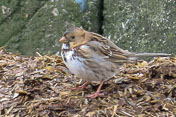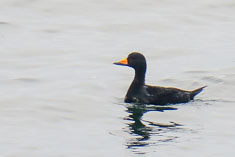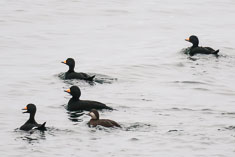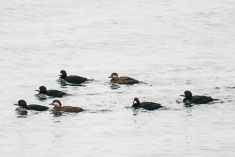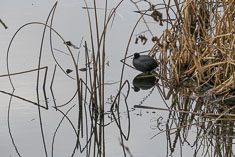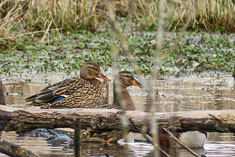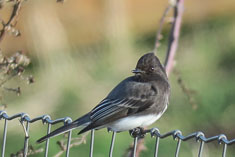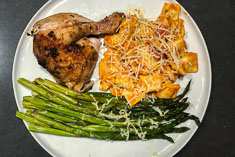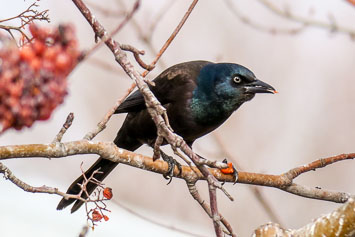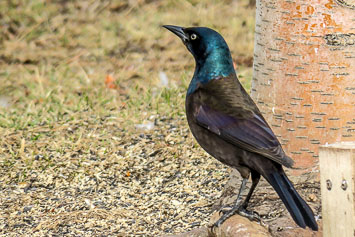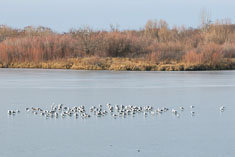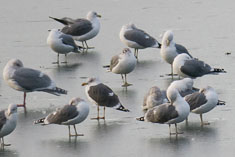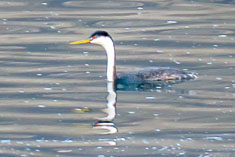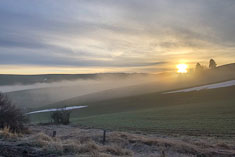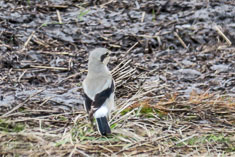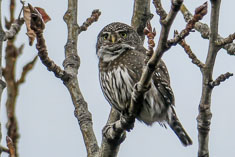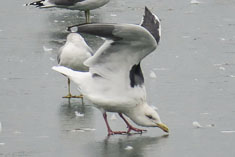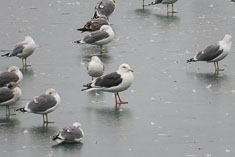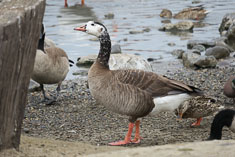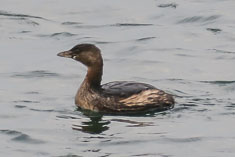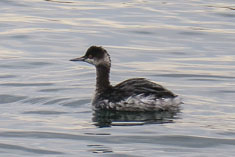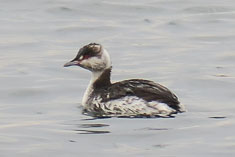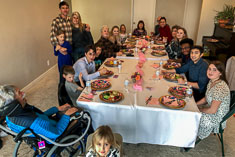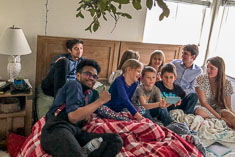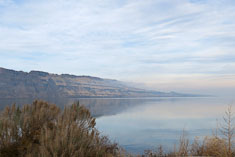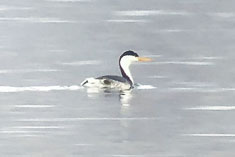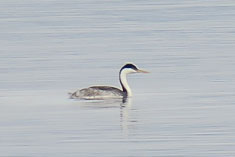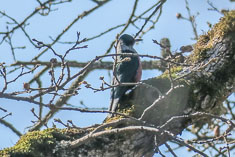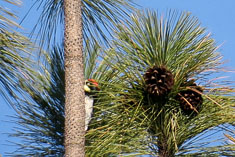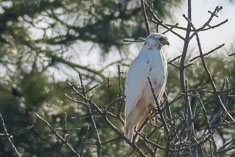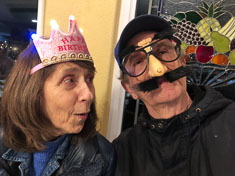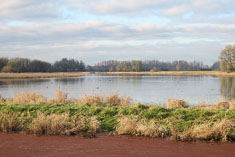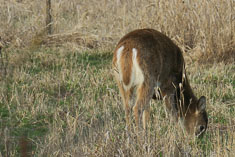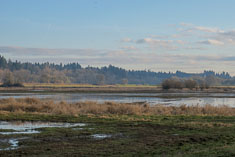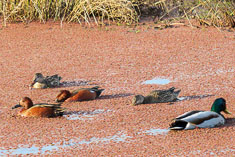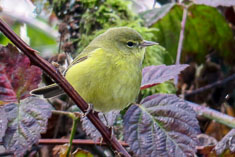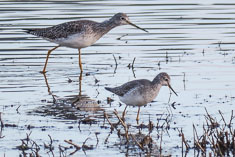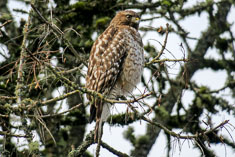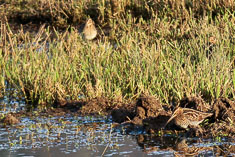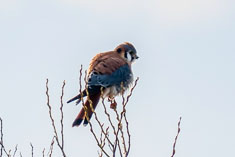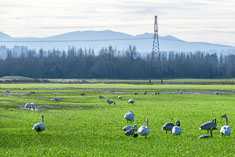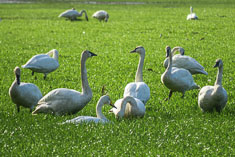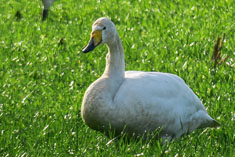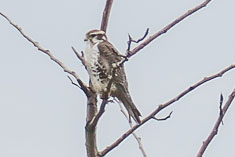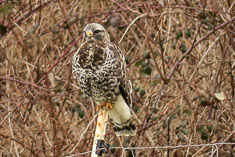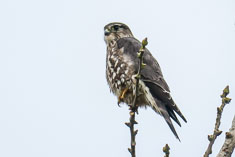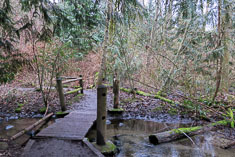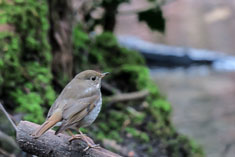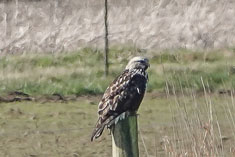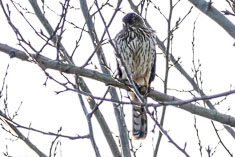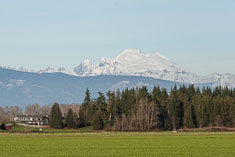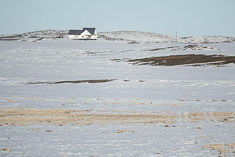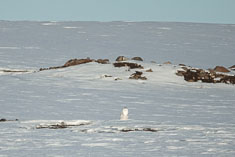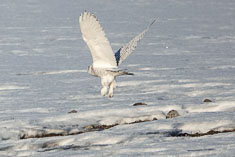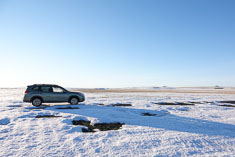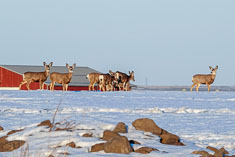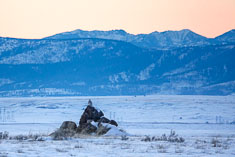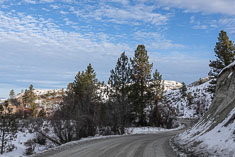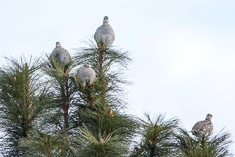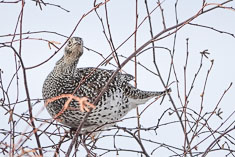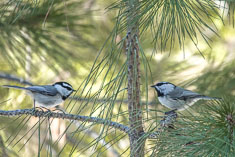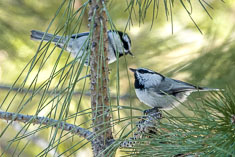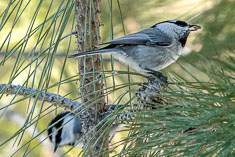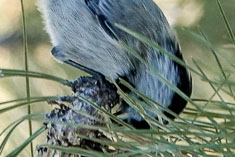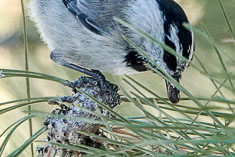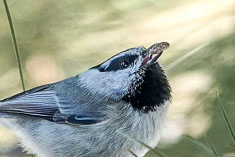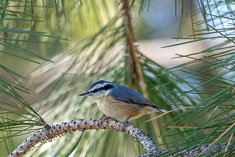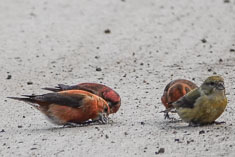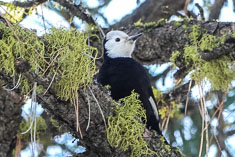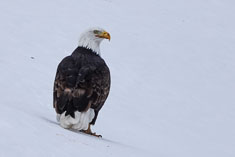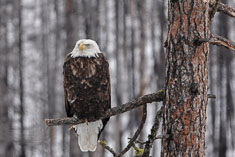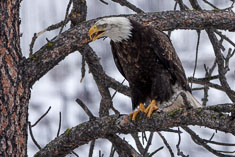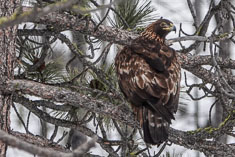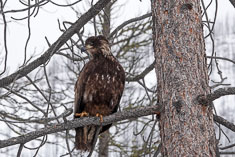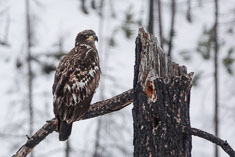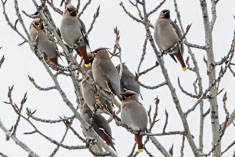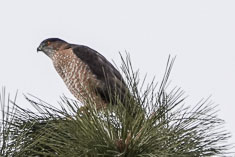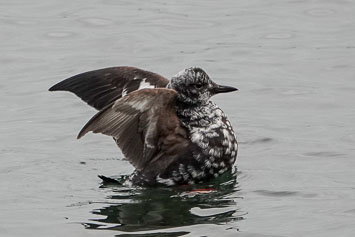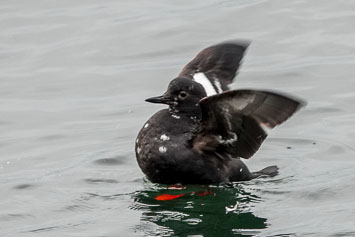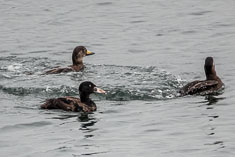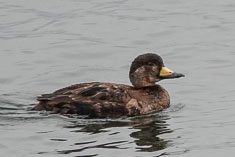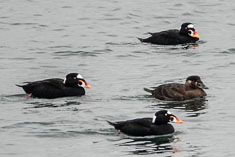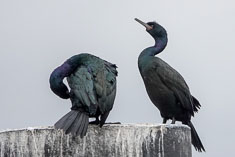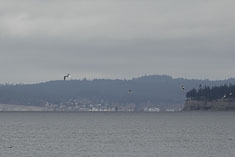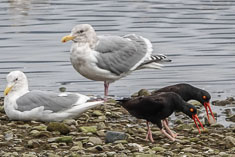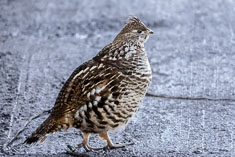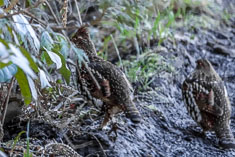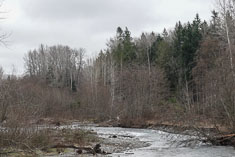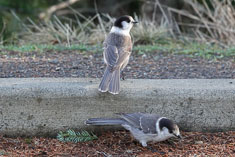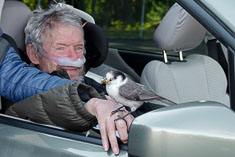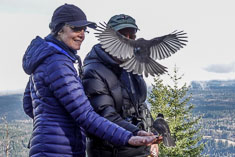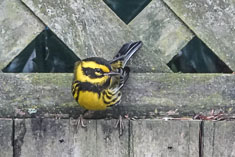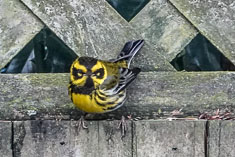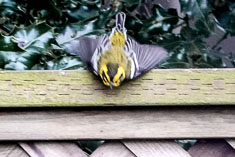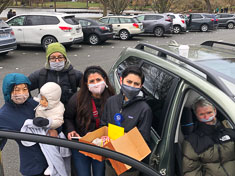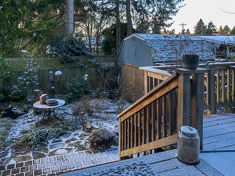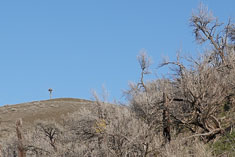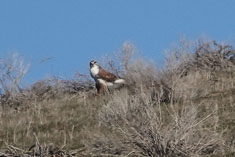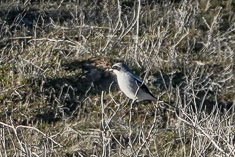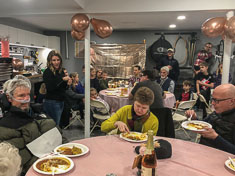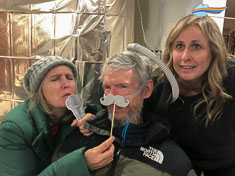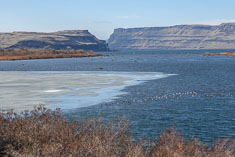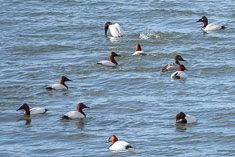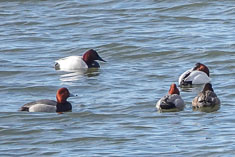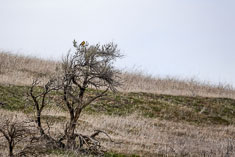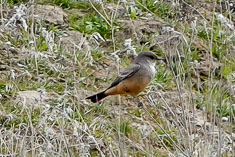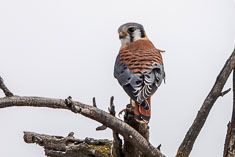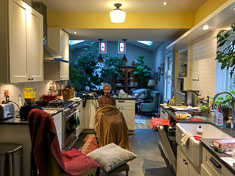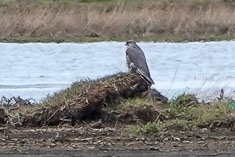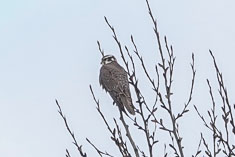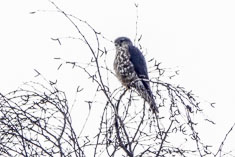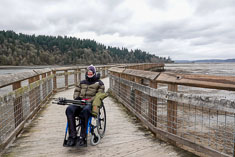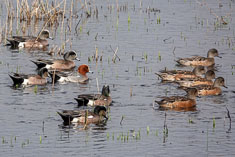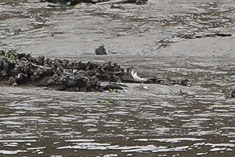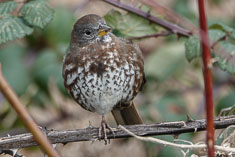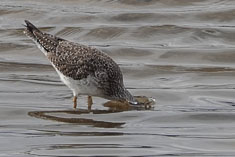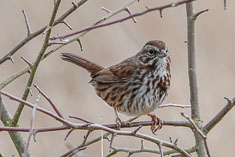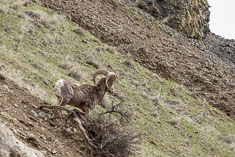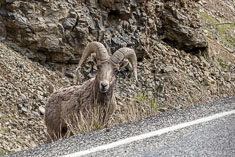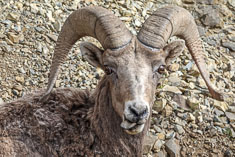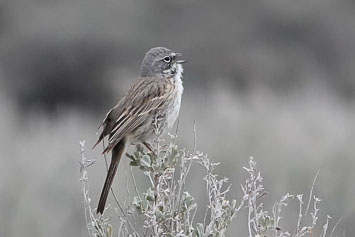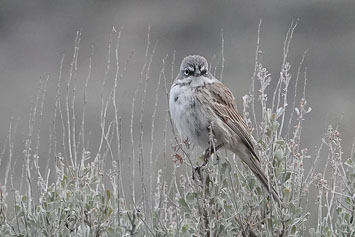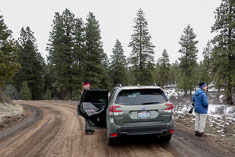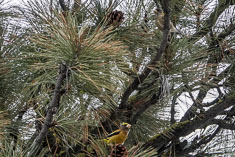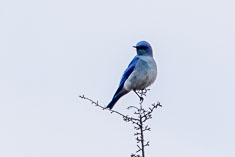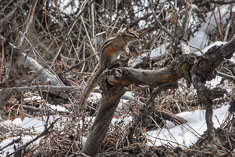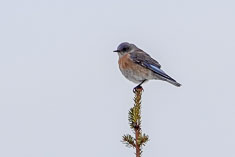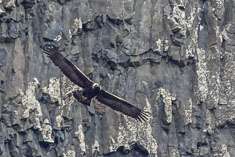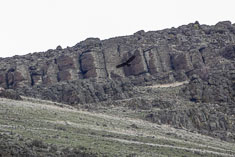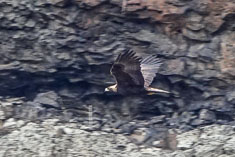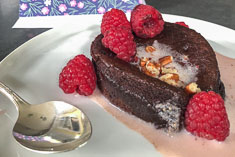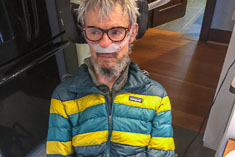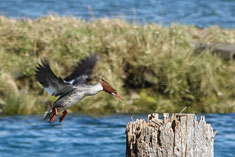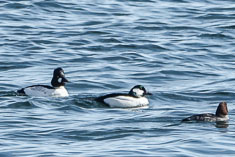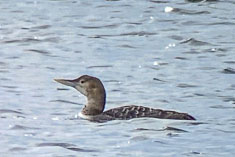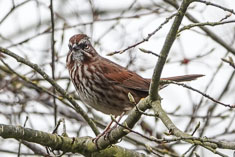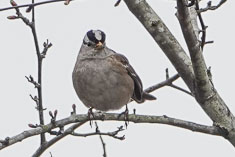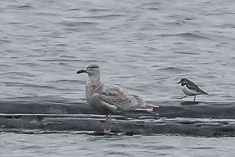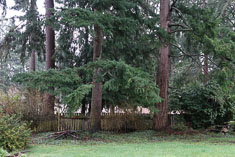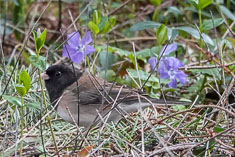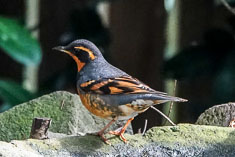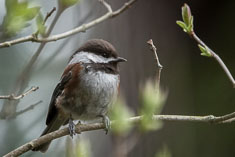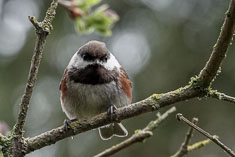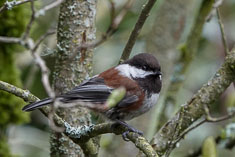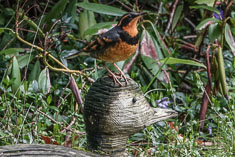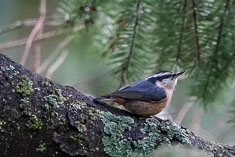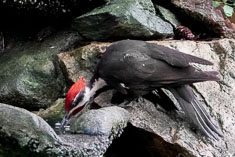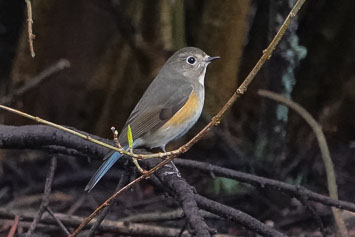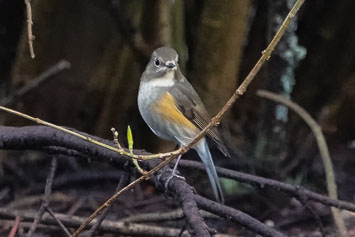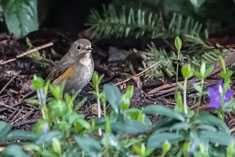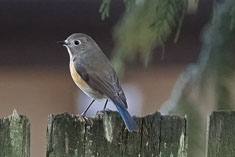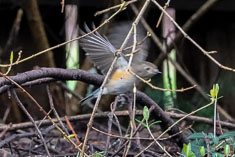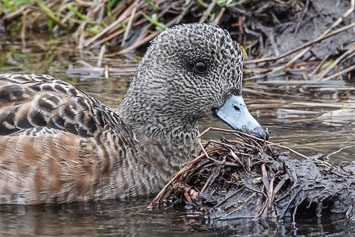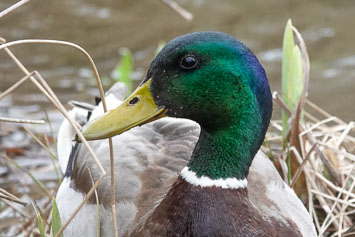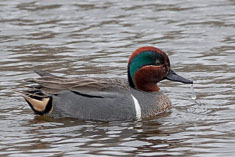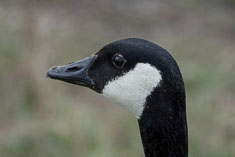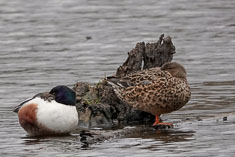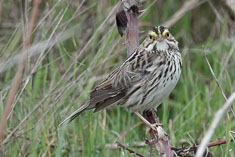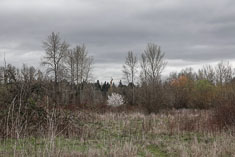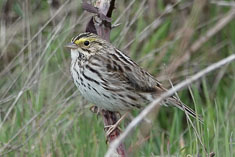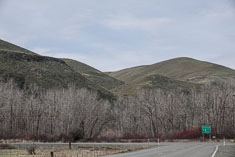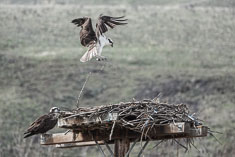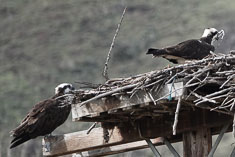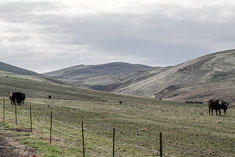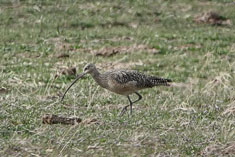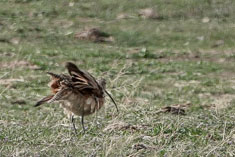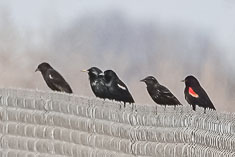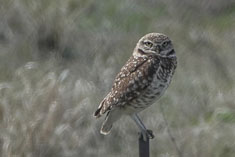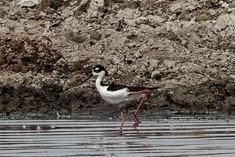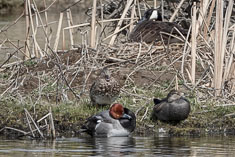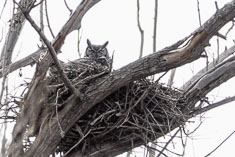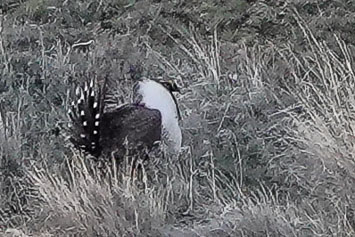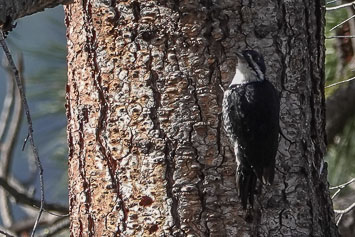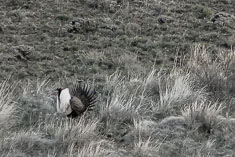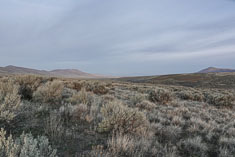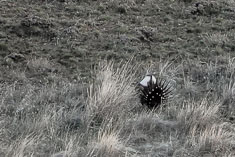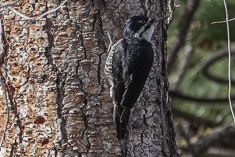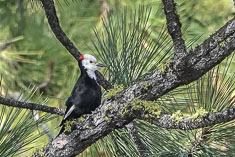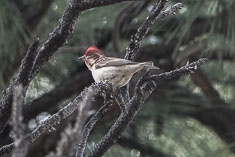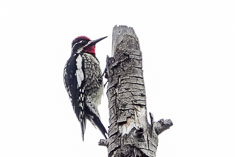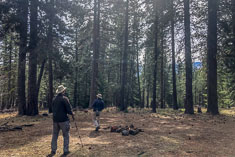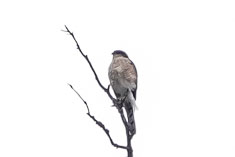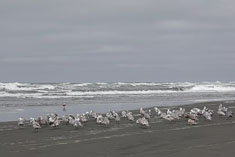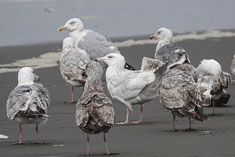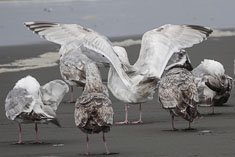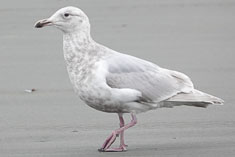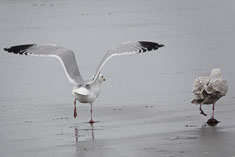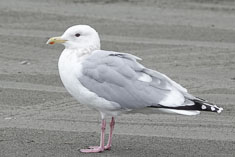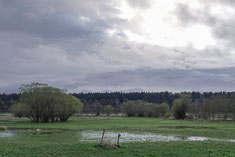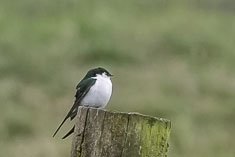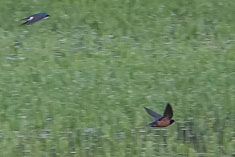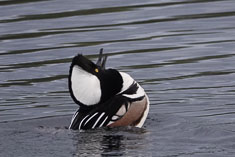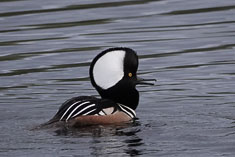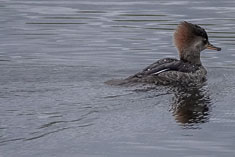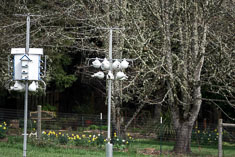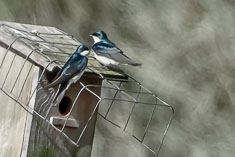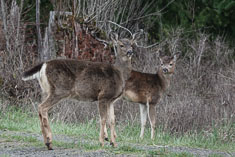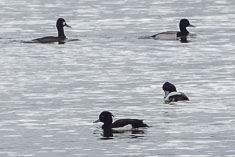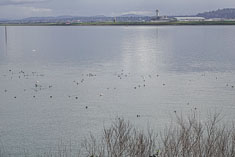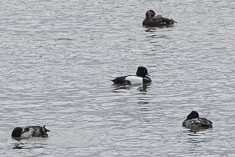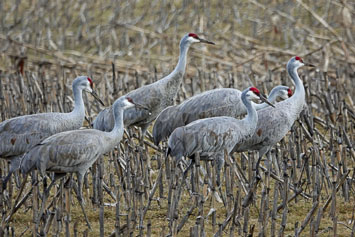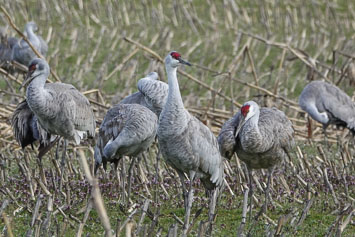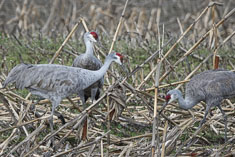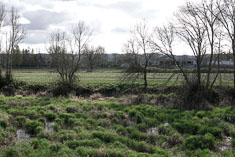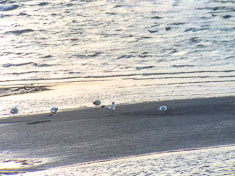1/01/2022 Not a very big day (link to here)
Happy New Year! We are out birding again - what a surprise! We are not, however, doing a big year this year. Yes I know, we said that last January too, but this time we mean it. We are just going to go out birdwatching and see what we find. Of course if there happens to be a rare bird nearby, I'm sure we will go try to take a look at it. And so we did today.
We did not find it - "it" being first the Glaucous Gull at the dumpster by Skagit River Park (which actually has not been reported for several weeks) then the large falcon for which we searched yesterday, then the Emperor Goose which we did see yesterday, then a Blue Jay over in Port Townsend and finally the Lesser Black-backed Gull which is still hanging around a farm near Sequim. That made 0 for 5 but we did manage to come up with 60 species for the day. Darchelle was embarrassed at how low that number was; I was on the other hand pleased that we managed by examining our photos to find one last bird to get us out of the 50s.
Happy New Year! We are out birding again - what a surprise! We are not, however, doing a big year this year. Yes I know, we said that last January too, but this time we mean it. We are just going to go out birdwatching and see what we find. Of course if there happens to be a rare bird nearby, I'm sure we will go try to take a look at it. And so we did today.
We did not find it - "it" being first the Glaucous Gull at the dumpster by Skagit River Park (which actually has not been reported for several weeks) then the large falcon for which we searched yesterday, then the Emperor Goose which we did see yesterday, then a Blue Jay over in Port Townsend and finally the Lesser Black-backed Gull which is still hanging around a farm near Sequim. That made 0 for 5 but we did manage to come up with 60 species for the day. Darchelle was embarrassed at how low that number was; I was on the other hand pleased that we managed by examining our photos to find one last bird to get us out of the 50s.
1/02/2022 Blue Jays (link to here)
We spent the night at the Bishop Hotel + in Port Townsend in a comfortable two room suite (#25) on the first floor and ate takeout from Finistere +, a restaurant Darchelle has wanted to try for a while now. The first time she called them they told her that they did not do takeout but when she called again and pleaded our case they relented. I ordered fried oysters and grilled broccolini; Darchelle got the creamy polenta, the roasted Brussels sprouts and the Kuri squash soup. It was all delicious. We also picked up a couple of items from the in-house Wine bar, the Bishop Block Bottle Shop +. I got the Duck liver toasts and Darchelle the Chickpea panisse. Not cheap but both very tasty. The bottle shop carries a nice selection of Propolis beers so on their recommendation I bought a can of Propolis spruce tip pale ale to take home. I should have bought three or four; it's a delicious beer but unfortunately it is probably seasonal.
We did not hurry out in the morning but when we did get going, we returned to the neighborhood where the Blue Jay has been showing up and parked where I could see into the backyard. We did not have to wait long. Darchelle get out to look around and had not even made it across the street before I spotted the jay flying into the yard. It did not stay long but she waited with the camera and it soon returned for photos. Or maybe just for peanuts.
While I was watching, a Peregrine swooped in over the yard and down into "H" Street. Flying just a few feet above the pavement, it dodged the roundabout at Rose Street and continued for a block or two up the hill before turning a corner. A few seconds later I spotted it circling in front of the Douglas firs at the top of the hill before it disappeared behind them. My first impression had been of a Cooper's Hawk but its pale gray color above and long pointed wings made it clearly a Peregrine, our second in two days.
Before leaving Port Townsend we drove out to Fort Worden but the wind was blowing too hard to do
much birding. On the way out of the park we get lost and ended up at nearby North Beach. The water
was such a beautiful blue that I had Darchelle take a few photos. Later on the computer, I assumed
that she had been photographing birds out on the water so I looked for them and discovered a small
group of Ancient Murrelets, not generally an easy bird to find. I counted them because I had been
watching the water while she took the photos, even though I could not recall seeing those specific
birds. My listing standards are declining, or maybe I'm just adjusting them to fit my situation.
We spent the night at the Bishop Hotel + in Port Townsend in a comfortable two room suite (#25) on the first floor and ate takeout from Finistere +, a restaurant Darchelle has wanted to try for a while now. The first time she called them they told her that they did not do takeout but when she called again and pleaded our case they relented. I ordered fried oysters and grilled broccolini; Darchelle got the creamy polenta, the roasted Brussels sprouts and the Kuri squash soup. It was all delicious. We also picked up a couple of items from the in-house Wine bar, the Bishop Block Bottle Shop +. I got the Duck liver toasts and Darchelle the Chickpea panisse. Not cheap but both very tasty. The bottle shop carries a nice selection of Propolis beers so on their recommendation I bought a can of Propolis spruce tip pale ale to take home. I should have bought three or four; it's a delicious beer but unfortunately it is probably seasonal.
We did not hurry out in the morning but when we did get going, we returned to the neighborhood where the Blue Jay has been showing up and parked where I could see into the backyard. We did not have to wait long. Darchelle get out to look around and had not even made it across the street before I spotted the jay flying into the yard. It did not stay long but she waited with the camera and it soon returned for photos. Or maybe just for peanuts.
While I was watching, a Peregrine swooped in over the yard and down into "H" Street. Flying just a few feet above the pavement, it dodged the roundabout at Rose Street and continued for a block or two up the hill before turning a corner. A few seconds later I spotted it circling in front of the Douglas firs at the top of the hill before it disappeared behind them. My first impression had been of a Cooper's Hawk but its pale gray color above and long pointed wings made it clearly a Peregrine, our second in two days.
1/03/2022 Redpolls (link to here)
Darchelle took the above photo of the Merlin along Schmuck Road in Sequim this morning. It was feeding on a bird, probably a Dunlin, having left a trail of feathers downwind after plucking it. For our breakfast we stopped as usual at the Rainshadow Café +. We spent the second night of the new year in Sequim at the Sequim West Motel + in another two room suite, not quite as nice as the night before but considerably cheaper. After coffee we stopped by Three Crabs to see if we could view the water from the parking lot but we could not. The short trail out to the beach is too sandy for my wheelchair. We did spot a Peregrine strafing the ducks in the pond across the street, our third Peregrine in three days.
We had already committed to spending the night in Port Townsend when Darchelle noticed two days ago that a Hoary Redpoll had been reported at Green Lake. There was a time when that would've been a very big deal for me; ever since I found my first flock of Common Redpolls I've been searching through them for a Hoary, which is basically a very pale version of its much more abundant cousin. I have never succeeded in that effort and now it is almost too late. Recent research + seems to indicate that Hoary and Common Redpolls are more like siblings than cousins, genetically almost identical and likely soon to be lumped together as a single species.
Big deal or not, we cut short our fruitless search for the Lesser Black-backed Gull in Sequim this morning, caught the 12:45 ferry and found a parking spot on 63rd just as Alex S walked past us carrying his scope. "The bird is still there", he told us. He was returning for a better view after waiting out a rainstorm in his car for the previous half hour. We followed him down to the lake shore where he pointed the Hoary out to us. It was the one with multi-pointed tail. Even without optics I could see the tail. I could also see that the bird was noticeably paler than its companions up in the birch tree, though Darchelle photographed another one (top right photo above) which was almost as white as the designated Hoary. Temporary ABA life bird #644, I think.
Darchelle took the above photo of the Merlin along Schmuck Road in Sequim this morning. It was feeding on a bird, probably a Dunlin, having left a trail of feathers downwind after plucking it. For our breakfast we stopped as usual at the Rainshadow Café +. We spent the second night of the new year in Sequim at the Sequim West Motel + in another two room suite, not quite as nice as the night before but considerably cheaper. After coffee we stopped by Three Crabs to see if we could view the water from the parking lot but we could not. The short trail out to the beach is too sandy for my wheelchair. We did spot a Peregrine strafing the ducks in the pond across the street, our third Peregrine in three days.
We had already committed to spending the night in Port Townsend when Darchelle noticed two days ago that a Hoary Redpoll had been reported at Green Lake. There was a time when that would've been a very big deal for me; ever since I found my first flock of Common Redpolls I've been searching through them for a Hoary, which is basically a very pale version of its much more abundant cousin. I have never succeeded in that effort and now it is almost too late. Recent research + seems to indicate that Hoary and Common Redpolls are more like siblings than cousins, genetically almost identical and likely soon to be lumped together as a single species.
Big deal or not, we cut short our fruitless search for the Lesser Black-backed Gull in Sequim this morning, caught the 12:45 ferry and found a parking spot on 63rd just as Alex S walked past us carrying his scope. "The bird is still there", he told us. He was returning for a better view after waiting out a rainstorm in his car for the previous half hour. We followed him down to the lake shore where he pointed the Hoary out to us. It was the one with multi-pointed tail. Even without optics I could see the tail. I could also see that the bird was noticeably paler than its companions up in the birch tree, though Darchelle photographed another one (top right photo above) which was almost as white as the designated Hoary. Temporary ABA life bird #644, I think.
1/07/2022 Doubleheader in Sequim (link to here)
Now that the snow has melted, the Dickcissel in Sequim has reappeared. Maxine and Mike were headed over there this morning and Darchelle arranged for us to join them even though we spent two days in Sequim just last weekend. We'd been looking for the Lesser Black-backed Gull and although we'd driven the snow-covered hill along Maple View Farm repeatedly, we'd not managed to find it either in person or in our photographs. Darchelle does not like to be denied so she wanted a rematch. That, and the prospect of better photos of the Dickcissel, along with Maxine's assistance in locating them, created enough incentive to get us out of bed before 6AM despite neither of us getting a decent nights sleep.
As it turned out, that was how they helped us the most - getting us out of bed. As planned, we both made the 7:10 ferry but we reached Sequim a few minutes before they did and by the time they caught up to us, Darchelle had already spotted the gull. As for the Dickcissel, after Mike helped us wheel across the field he and Maxine walked over to the far corner of the field while Darchelle and I parked in the near corner. We were still getting settled when I heard the bird call (described by a previous observer as a low pitched "thick") and saw it fly into the same lone bush in which it had frequently parked before Christmas. We called Mike and Maxine over and everyone got photos but for me both the bird and the bush were backlit so I never got a good look in person. Darchelle felt bad about that but without being able to use optics, I don't usually get much of a look in person anyhow. I'd rather have good photos to look at on the computer when I get home, so I was pleased that Darchelle was able to get some good shots.
Worth noting, we had three species of falcon along Schmuck Road l+, including our fourth Peregrine in four days of birding.
With two rare birds in our pocket, so to speak, by 10:30AM, we thought we would head over to Port Townsend, take the ferry over to Whidbey Island and drive up to March Point near Anacortes to look for the Emperor Goose. We saw it there just a week ago but it is still hanging around and lots of people are making the pilgrimage to see it in 2022. There might not be another one in the state all year. Besides, we missed it on New Year's Day and as previously noted, Darchelle does not like to be denied. We were denied again nonetheless; the ferry was not operating due to the weather. The person in the ticket booth was clearly tired of explaining that yes the weather did look reasonably benign and no he did not know when the ferry would resume operation. We caught the ferry back to Edmonds instead and searched until dusk for a Black Scoter without success. The mile or so of shoreline north of the ferry terminal is about the only place I know of to reliably find Black Scoters but but they come and go and today they were gone.
Now that the snow has melted, the Dickcissel in Sequim has reappeared. Maxine and Mike were headed over there this morning and Darchelle arranged for us to join them even though we spent two days in Sequim just last weekend. We'd been looking for the Lesser Black-backed Gull and although we'd driven the snow-covered hill along Maple View Farm repeatedly, we'd not managed to find it either in person or in our photographs. Darchelle does not like to be denied so she wanted a rematch. That, and the prospect of better photos of the Dickcissel, along with Maxine's assistance in locating them, created enough incentive to get us out of bed before 6AM despite neither of us getting a decent nights sleep.
As it turned out, that was how they helped us the most - getting us out of bed. As planned, we both made the 7:10 ferry but we reached Sequim a few minutes before they did and by the time they caught up to us, Darchelle had already spotted the gull. As for the Dickcissel, after Mike helped us wheel across the field he and Maxine walked over to the far corner of the field while Darchelle and I parked in the near corner. We were still getting settled when I heard the bird call (described by a previous observer as a low pitched "thick") and saw it fly into the same lone bush in which it had frequently parked before Christmas. We called Mike and Maxine over and everyone got photos but for me both the bird and the bush were backlit so I never got a good look in person. Darchelle felt bad about that but without being able to use optics, I don't usually get much of a look in person anyhow. I'd rather have good photos to look at on the computer when I get home, so I was pleased that Darchelle was able to get some good shots.
Worth noting, we had three species of falcon along Schmuck Road l+, including our fourth Peregrine in four days of birding.
With two rare birds in our pocket, so to speak, by 10:30AM, we thought we would head over to Port Townsend, take the ferry over to Whidbey Island and drive up to March Point near Anacortes to look for the Emperor Goose. We saw it there just a week ago but it is still hanging around and lots of people are making the pilgrimage to see it in 2022. There might not be another one in the state all year. Besides, we missed it on New Year's Day and as previously noted, Darchelle does not like to be denied. We were denied again nonetheless; the ferry was not operating due to the weather. The person in the ticket booth was clearly tired of explaining that yes the weather did look reasonably benign and no he did not know when the ferry would resume operation. We caught the ferry back to Edmonds instead and searched until dusk for a Black Scoter without success. The mile or so of shoreline north of the ferry terminal is about the only place I know of to reliably find Black Scoters but but they come and go and today they were gone.
1/08/2022 Emperor Goose - yes, large falcon - no (link to here)
Darchelle has been eager to get the Emperor Goose on our year list even though we are not doing a big year so we drove up to the Skagit again today. The weather was chilly with a steady south breeze and a gradually thickening overcast. I did not envy the duck hunters out on the water, sitting in the cold wind waiting for a duck to come by. I did my share of sitting in the cold wind, on the dike behind the Swinomish Casino trying to get a glimpse of the Emperor Goose. Darchelle had been the first to spot it, foraging along the near shore of the Swinomish channel with a flock of Brant. Neither it nor the Brant appeared much perturbed by the hunters popping away offshore. They may even have been relieved since the hunting activity seemed to keep the Bald Eagles at bay. I was unable to see the goose with my opera glasses so Doug helped Darchelle hold me up while I peered through the scope and caught a glimpse of its white head and dark neck among the Brants. I think Doug may have been the birder who came to my rescue when I fell at Bottle Beach last May. He and his wife Victoria C remembered meeting us at Bottle Beach when we were all looking for Red Knots.
We almost ran out of gas searching for the large falcon on the Samish Flats. When the miles-to-go number on the center console switched from "20" to "---" without ever stopping at "10" Darchelle finally began to share my concern about finding a gas station. Siri saved the day, directing us to a gas station three miles up Bow Hill Road by the casino. Darchelle recalled that we had been there before under similar circumstances. She filled the 16.6 gallon gas tank with 15.3 gallons so our alarm about running out may have been premature.
We did not find the large falcon but Darchelle might have seen the Prairie Falcon around dusk as we started to head home. It has apparently been reported in that vicinity before.
Darchelle has been eager to get the Emperor Goose on our year list even though we are not doing a big year so we drove up to the Skagit again today. The weather was chilly with a steady south breeze and a gradually thickening overcast. I did not envy the duck hunters out on the water, sitting in the cold wind waiting for a duck to come by. I did my share of sitting in the cold wind, on the dike behind the Swinomish Casino trying to get a glimpse of the Emperor Goose. Darchelle had been the first to spot it, foraging along the near shore of the Swinomish channel with a flock of Brant. Neither it nor the Brant appeared much perturbed by the hunters popping away offshore. They may even have been relieved since the hunting activity seemed to keep the Bald Eagles at bay. I was unable to see the goose with my opera glasses so Doug helped Darchelle hold me up while I peered through the scope and caught a glimpse of its white head and dark neck among the Brants. I think Doug may have been the birder who came to my rescue when I fell at Bottle Beach last May. He and his wife Victoria C remembered meeting us at Bottle Beach when we were all looking for Red Knots.
We almost ran out of gas searching for the large falcon on the Samish Flats. When the miles-to-go number on the center console switched from "20" to "---" without ever stopping at "10" Darchelle finally began to share my concern about finding a gas station. Siri saved the day, directing us to a gas station three miles up Bow Hill Road by the casino. Darchelle recalled that we had been there before under similar circumstances. She filled the 16.6 gallon gas tank with 15.3 gallons so our alarm about running out may have been premature.
We did not find the large falcon but Darchelle might have seen the Prairie Falcon around dusk as we started to head home. It has apparently been reported in that vicinity before.
1/09/2022 Conway doubleheader (link to here)
We picked up two difficult to find species this afternoon back up in the Skagit Valley in the neighborhood of Conway, spending a total of about four hours on the effort as compared with the forty hours we devoted to finding the same two species last year. Darchelle even got photos of both of them.
The Bohemian Waxwing was hawking invisible insects with a small group of Cedar Waxwings in the sunny alders along the road to the bo.at launch at Wiley Slough. David P gave Darchelle a view of it through his scope but before she was able to explain to me where it was, it flew to the very top of one of the alders and I was able to spot it through my opera glasses. She got photos. Last November we drove 5 1/2 hours each way to the Methow Valley and spent a total of maybe 8 hours looking for a Bohemian Waxwing. Darchelle probably saw one; I might have seen another but it took another trip to the Okanogan in December to finally get it for sure.
The Rusty Blackbird has been hanging out with a small group of blackbirds and starlings around Conway Feed but it wasn't there when we arrived after seeing the waxwing. Maxine was there instead and she told us that she had seen the bird but then a train came along and scared away all the blackbirds. She and Mike had driven around the area but had not relocated them. We decided we would try our luck, but first Darchelle wanted to check out the big blackbird flock she'd seen on the way back from Wiley Road. While we were perusing that huge flock of starlings and blackbirds, Maxine texted Darchelle. She had the bird again.
We raced back to Conway and arrived 15 seconds after the Rusty Blackbird disappeared again. "You had to have seen it," Maxine insisted. "It was right there on the wire when you drove up!" But we had not seen it. We were quite grumpy about missing it but put on a good face about it for Maxine, who hung out and visited with us for a few minutes before they had to leave.
We drove around town for a few minutes without finding any more blackbirds. As we pulled up in front of Conway Feed again I looked up through my open window and there it was, the Rusty Blackbird, sitting on a wire right above us. Of course it flew away before Darchelle could get a photo but she relocated it in a big Cottonwood tree on the other side of the tracks. I was able to see it, if not identify it, with my opera glasses but Darchelle got photos through the scope. Much easier than last year.
We celebrated our success by watching "Fiddler on the Roof" and going to bed after midnight.
We picked up two difficult to find species this afternoon back up in the Skagit Valley in the neighborhood of Conway, spending a total of about four hours on the effort as compared with the forty hours we devoted to finding the same two species last year. Darchelle even got photos of both of them.
The Bohemian Waxwing was hawking invisible insects with a small group of Cedar Waxwings in the sunny alders along the road to the bo.at launch at Wiley Slough. David P gave Darchelle a view of it through his scope but before she was able to explain to me where it was, it flew to the very top of one of the alders and I was able to spot it through my opera glasses. She got photos. Last November we drove 5 1/2 hours each way to the Methow Valley and spent a total of maybe 8 hours looking for a Bohemian Waxwing. Darchelle probably saw one; I might have seen another but it took another trip to the Okanogan in December to finally get it for sure.
The Rusty Blackbird has been hanging out with a small group of blackbirds and starlings around Conway Feed but it wasn't there when we arrived after seeing the waxwing. Maxine was there instead and she told us that she had seen the bird but then a train came along and scared away all the blackbirds. She and Mike had driven around the area but had not relocated them. We decided we would try our luck, but first Darchelle wanted to check out the big blackbird flock she'd seen on the way back from Wiley Road. While we were perusing that huge flock of starlings and blackbirds, Maxine texted Darchelle. She had the bird again.
We raced back to Conway and arrived 15 seconds after the Rusty Blackbird disappeared again. "You had to have seen it," Maxine insisted. "It was right there on the wire when you drove up!" But we had not seen it. We were quite grumpy about missing it but put on a good face about it for Maxine, who hung out and visited with us for a few minutes before they had to leave.
We drove around town for a few minutes without finding any more blackbirds. As we pulled up in front of Conway Feed again I looked up through my open window and there it was, the Rusty Blackbird, sitting on a wire right above us. Of course it flew away before Darchelle could get a photo but she relocated it in a big Cottonwood tree on the other side of the tracks. I was able to see it, if not identify it, with my opera glasses but Darchelle got photos through the scope. Much easier than last year.
We celebrated our success by watching "Fiddler on the Roof" and going to bed after midnight.
1/13-16/2022 Okanogan trip (link to here)
Worried that the Snowy Owl we saw in December might soon depart for colder climates, Darchelle
wanted to get over to the Waterville plateau and the Okanogan Highlands as soon as possible. As for
me, after two days of sitting at the computer I was ready for another birding trip too. Despite "patchy dense
fog" which kept turning out to be more dense than patchy, and despite missing our primary target,
the Snowy Owl, it was a good trip. Thanks probably to heavier snow than usual, we saw lots of
grouse although we could not find a Ruffed, and thanks to unexpected chance encounters, we picked up
several other specialties of the region including White-winged Crossbill, Gray-crowned Rosy-Finch and Snow
Bunting.
1/13 Seattle to Omak (link to here)
I don't recall ever seeing so much snow east of Snoqualmie Pass. A four foot dump of snow a couple of weeks ago in Leavenworth made the statewide if not national news, but Cle Elum must have received almost as much and even Soap Lake was uncharacteristically snowy. We stopped at Cloudview Kitchen to pick up supper; they didn't have the Portobello Panini so Darchelle got me the Posole Verde special instead. I enjoyed it for the next two nights at the Omak Inn; it was delicious. Soap Lake was frozen over so we didn't find any Eared Grebes or Ruddy Ducks. Up on the Waterville Plateau the combination of fog and sunset thwarted our efforts to find the Snowy Owl.
I don't recall ever seeing so much snow east of Snoqualmie Pass. A four foot dump of snow a couple of weeks ago in Leavenworth made the statewide if not national news, but Cle Elum must have received almost as much and even Soap Lake was uncharacteristically snowy. We stopped at Cloudview Kitchen to pick up supper; they didn't have the Portobello Panini so Darchelle got me the Posole Verde special instead. I enjoyed it for the next two nights at the Omak Inn; it was delicious. Soap Lake was frozen over so we didn't find any Eared Grebes or Ruddy Ducks. Up on the Waterville Plateau the combination of fog and sunset thwarted our efforts to find the Snowy Owl.
1/14 Conconully (link to here)
The water birches along Scotch Creek were hosting two dozen Sharp-tailed Grouse when we drove by at 8:30 AM so we stopped for photos. There wasn't much traffic and the grouse were quite close to the road. Just as they were four years ago, two Great Horned Owls were also perched low in the same water birch, though around on the back side so we could not get photos. Unlike back in December, we did not see any Ermine along the road nearby.
We did find a flock of Chukars along Conconully Road, and at Hess Lake, 91 more Chukars along with 56 Gray Partridge, again reminding me of four years ago when we saw so many Chukars and partridge. Conditions were similar today - snow everywhere and cold under a low stratus overcast - and the birds were feeding in and along the road, allowing us to get closer than they usually do.
Conconully was pretty quiet - not much bird activity, not much mammal activity, not much human activity, at least not that we could see - until we started up the hillside on the west side of town. About two sreets up we flushed a Golden Eagle from a snowbank (only in Conconully!) and realized that it had left behind a good-sized chunk of skinless turkey breast. There was a time that I would have carved off a a few slices and cooked them up for lunch, but that time is in the past. The remaining turkeys, all 68 of them, appeared to have recovered from the shock of losing one of their comrades. When we pulled over to take some photos, they crowded around us seeking handouts. We obliged.
After dedicating a half-hour to a Ruffed Grouse search on Salmon Hill Road (I think, though Google timeline appears to disagree), we decided to spend the afternoon in the Highlands. It was foggy up there too and we did not find much, that is to say, we did not find either a Ruffed Grouse or a Northern Goshawk. At dusk, perhaps a little too late we thought at the time, we tried for a Great Gray Owl in the meadows along the Sno-Park Road. We were probably not too late; there was just too much snow.
The water birches along Scotch Creek were hosting two dozen Sharp-tailed Grouse when we drove by at 8:30 AM so we stopped for photos. There wasn't much traffic and the grouse were quite close to the road. Just as they were four years ago, two Great Horned Owls were also perched low in the same water birch, though around on the back side so we could not get photos. Unlike back in December, we did not see any Ermine along the road nearby.
We did find a flock of Chukars along Conconully Road, and at Hess Lake, 91 more Chukars along with 56 Gray Partridge, again reminding me of four years ago when we saw so many Chukars and partridge. Conditions were similar today - snow everywhere and cold under a low stratus overcast - and the birds were feeding in and along the road, allowing us to get closer than they usually do.
Conconully was pretty quiet - not much bird activity, not much mammal activity, not much human activity, at least not that we could see - until we started up the hillside on the west side of town. About two sreets up we flushed a Golden Eagle from a snowbank (only in Conconully!) and realized that it had left behind a good-sized chunk of skinless turkey breast. There was a time that I would have carved off a a few slices and cooked them up for lunch, but that time is in the past. The remaining turkeys, all 68 of them, appeared to have recovered from the shock of losing one of their comrades. When we pulled over to take some photos, they crowded around us seeking handouts. We obliged.
After dedicating a half-hour to a Ruffed Grouse search on Salmon Hill Road (I think, though Google timeline appears to disagree), we decided to spend the afternoon in the Highlands. It was foggy up there too and we did not find much, that is to say, we did not find either a Ruffed Grouse or a Northern Goshawk. At dusk, perhaps a little too late we thought at the time, we tried for a Great Gray Owl in the meadows along the Sno-Park Road. We were probably not too late; there was just too much snow.
1/15 Okanogan Highlands (link to here)
The Okanogan Highlands, at least as this birdwatcher defines them, consist of about 100 square miles of grasslands, montane forest and riparian thickets on the irregular hills and valleys east of the Okanogan River between Mount Bonaparte and the Canadian border. The elevation ranges from 3000 to 5000 feet; by comparison, the Okanogan River Valley is under 1000 feet. Although probably not for lack of trying over the past 100 years, the human impact on the landscape is minimal. Small farms raise a few cattle here and there, particularly around Chesaw, and a few vacation homes protrude from the hillsides, and of course the forest has all been logged but it has largely grown back. The several small communities in the region - Chesaw, Molson, Havillah - are probably no larger than they were 100 years ago but they are still connected by a confusing network of dirt and gravel roads, most of them so lightly traveled that we can get away with stopping wherever we are whenever the urge strikes. Birds and scenery are the usual reasons for the urge.
We spent all day up there today, leaving the Omak Inn at 7:30 and returning almost 12 hours later. Like yesterday, we found lots of Gray Partridge but no Ruffed Grouse. Of the northern specialties for which the Highlands are known we found one Snow Bunting, one flock of White-winged Crossbills, one flock of Common Redpolls and one flock of Gray-crowned Rosy-Finches, the latter uncharacteristically occupying a small Ponderosa Pine. We called up one Northern Pygmy-Owl but again no Great Gray Owl. On the Sno-Park Road Darchelle talked with a man who had a home in the area and was familiar with the owls. He told her that they are much easier to find in March and April than they are in midwinter. We believed him.
Like yesterday, we did not get many photos, but the images of the Gray Partridge were our best ever. The crossbills were as usual too high up in a tree top. The redpolls were fairly low in alders but the light was poor. Low light also impaired the photos of the California quail huddled together on a log before heading off to bed.
The Okanogan Highlands, at least as this birdwatcher defines them, consist of about 100 square miles of grasslands, montane forest and riparian thickets on the irregular hills and valleys east of the Okanogan River between Mount Bonaparte and the Canadian border. The elevation ranges from 3000 to 5000 feet; by comparison, the Okanogan River Valley is under 1000 feet. Although probably not for lack of trying over the past 100 years, the human impact on the landscape is minimal. Small farms raise a few cattle here and there, particularly around Chesaw, and a few vacation homes protrude from the hillsides, and of course the forest has all been logged but it has largely grown back. The several small communities in the region - Chesaw, Molson, Havillah - are probably no larger than they were 100 years ago but they are still connected by a confusing network of dirt and gravel roads, most of them so lightly traveled that we can get away with stopping wherever we are whenever the urge strikes. Birds and scenery are the usual reasons for the urge.
We spent all day up there today, leaving the Omak Inn at 7:30 and returning almost 12 hours later. Like yesterday, we found lots of Gray Partridge but no Ruffed Grouse. Of the northern specialties for which the Highlands are known we found one Snow Bunting, one flock of White-winged Crossbills, one flock of Common Redpolls and one flock of Gray-crowned Rosy-Finches, the latter uncharacteristically occupying a small Ponderosa Pine. We called up one Northern Pygmy-Owl but again no Great Gray Owl. On the Sno-Park Road Darchelle talked with a man who had a home in the area and was familiar with the owls. He told her that they are much easier to find in March and April than they are in midwinter. We believed him.
Like yesterday, we did not get many photos, but the images of the Gray Partridge were our best ever. The crossbills were as usual too high up in a tree top. The redpolls were fairly low in alders but the light was poor. Low light also impaired the photos of the California quail huddled together on a log before heading off to bed.
1/16 Omak to Seattle (link to here)
The fog persisted overnight as a low status overcast. Up on Cameron Lake Road it presented as a
white haze which, in combination with our forgetting to reset the exposure compensation on the
camera after photographing a
Cooper's Hawk
on the way out of Omak, gave our photos an overexposed appearance. Snow on the ground and frost
on the trees and grass made for white backgrounds anyhow. Of interest, we thought we saw a wolf
but when we went to look for its tracks on the road to verify the sighting, we couldn't find them.
It was probably a Coyote but seemed bigger with shorter legs and thicker fur.
After looking for/at ducks at Washburn Island and Brewster, we drove up onto the Waterville Plateau to search for the Snowy Owl again, and again we were thwarted by fog.
After looking for/at ducks at Washburn Island and Brewster, we drove up onto the Waterville Plateau to search for the Snowy Owl again, and again we were thwarted by fog.
1/17/2022 Green Heron (link to here)
Green Heron being a bird which we usually find only once or twice a year, we drove down to Puyallup this afternoon to look for the one which is spending the winter at Levee Pond. It is probably the same individual which wintered there last year. A helpful birdwatcher was looking at the heron when we arrived and pointed it out to Darchelle who returned to the car and retrieved me. Because the day was reasonably warm, we wheeled all the way around the lake on the paved path. Darchelle took a few photos along the way and we picked up two year birds in addition to the heron.
Green Heron being a bird which we usually find only once or twice a year, we drove down to Puyallup this afternoon to look for the one which is spending the winter at Levee Pond. It is probably the same individual which wintered there last year. A helpful birdwatcher was looking at the heron when we arrived and pointed it out to Darchelle who returned to the car and retrieved me. Because the day was reasonably warm, we wheeled all the way around the lake on the paved path. Darchelle took a few photos along the way and we picked up two year birds in addition to the heron.
1/20/2022 Asotin Aspirations (Kirkland) (link to here)
Past reports of a large falcon on the Anatone flats above Asotin, along with a birthday party in Walla Walla inspired us to head southeast for a long weekend this morning, except that we didn't leave until midday. That still left time to go look for the Mandarin duck in Kirkland before handing over to Tri-Cities for the night. Darchelle really wanted to get a good photo of the Mandarin duck; neither the weather nor the duck cooperated but we did see it so eBird reluctantly added it to our year list, #120 and our first new bird of the trip.
Our motel search in Tri-Cities took about an hour. We inquired at the Desert Gold Motel but they only rent rooms by the month, then we drove over to the Comfort Inn and Suites but it was still under construction so we tried the Super 8 but it did not have direct access to the room without going through the lobby so we settled on the Econolodge. We usually prefer something a little more upscale but we slept well enough despite the sketchy neighborhood. In the morning I drank coffee which Darchelle had brought from home and the sun came out.
Past reports of a large falcon on the Anatone flats above Asotin, along with a birthday party in Walla Walla inspired us to head southeast for a long weekend this morning, except that we didn't leave until midday. That still left time to go look for the Mandarin duck in Kirkland before handing over to Tri-Cities for the night. Darchelle really wanted to get a good photo of the Mandarin duck; neither the weather nor the duck cooperated but we did see it so eBird reluctantly added it to our year list, #120 and our first new bird of the trip.
Our motel search in Tri-Cities took about an hour. We inquired at the Desert Gold Motel but they only rent rooms by the month, then we drove over to the Comfort Inn and Suites but it was still under construction so we tried the Super 8 but it did not have direct access to the room without going through the lobby so we settled on the Econolodge. We usually prefer something a little more upscale but we slept well enough despite the sketchy neighborhood. In the morning I drank coffee which Darchelle had brought from home and the sun came out.
1/21/2022 Asotin Aspirations (Tri-Cities to Clarkston) (link to here)
We missed the Slaty-backed Gull at the Columbia Park Marina l+ this morning and at Lower Monumental Dam
this afternoon but otherwise we had a remarkably successful day. At the marina Darchelle photographed
Kingfisher and a White Pelican, the latter new for the year for us, in the sunshine. Not very many
ducks were present at the marina but we found hundreds more by driving a dirt road north along the water,
so many that we did not attempt to do a checklist.
Someone had reported a Black-crowned Night-Heron at the Steptoe Roundabout pond l+. It was just a mile
or so from the marina so we drove over there and discovered a delightful little marsh. As
advertised, it hosted a handsome Canvasback along with a handful of other waterfowl species. While
Darchelle was photographing the ducks, the Night-Heron suddenly showed up. While she was
photographing the Night-Heron, Vic H showed up. He
parked next to us and started photographing the ducks from his car so we got to talking.
When he introduced himself, we recognized the name from the eBird report of the Harris's Sparrow, our next target. When we mentioned the sparrow he exclaimed, "That bird is at my feeder!". He explained how it typically waited until he put out a particular seed mix before showing up, and that he had already fed it this morning but he would call his wife and let her know that we were coming, and that if we parked in his driveway and waited a bit, we would probably see it right from the car. He did, and we did. We suspect that he asked her to put out a little fresh feed because the sparrow showed up just minutes after we arrived. It is not an easy bird to find in Washington and I doubt we would have seen it had we not run into Vic.
The Slaty-backed Gull has spent the last five winters at the Columbia Park Marina but like us, it occasionally takes a little trip somewhere. Last week, that somewhere was the Lower Monumental Dam about 30 miles up the Snake River from the Columbia and about 40 miles from the marina. Lower Monumental Dam hosts a good-sized gull flock during the winter, mostly Californias but on our visit today, with the help of photographs, I identified seven different species l+, although not the Slaty-backed. The first-year Glaucous Gull which I spotted in flight through my opera glasses provided some consolation. We were excited to have discovered a rare bird all on our own, then somewhat deflated when eBird declined to flag it as rare. First-year Glaucous Gulls would turn up in half a dozen locations elsewhere in the state over the next two days and most of them would be marked as rare but not ours.
The road to Lower Monumental Dam winds through about 20 miles of Palouse Hills, all cultivated for
wheat at some point but some currently fallow, either planted to Bunch grass through
CRP +
or left to grow annual grasses and weeds. American Goldfinches like the weed seeds; we came across
a flock of at least 150 which included a Lesser Goldfinch and a Common Redpoll, both spotted in
Darchelle's photos. Prairie Falcons like goldfinches; Darchelle spotted one flying overhead and
immediately recognized it as something other than the usual Red-tails and Cooper's Hawks.
We made one last stop before heading east to Clarkston, a detour up Smith Springs Road to the Long-eared Owl spot. Usually there are half a dozen there but today we only found one. Nice sunset, and shortly afterwards two Great Horned Owls, on the way out.
When he introduced himself, we recognized the name from the eBird report of the Harris's Sparrow, our next target. When we mentioned the sparrow he exclaimed, "That bird is at my feeder!". He explained how it typically waited until he put out a particular seed mix before showing up, and that he had already fed it this morning but he would call his wife and let her know that we were coming, and that if we parked in his driveway and waited a bit, we would probably see it right from the car. He did, and we did. We suspect that he asked her to put out a little fresh feed because the sparrow showed up just minutes after we arrived. It is not an easy bird to find in Washington and I doubt we would have seen it had we not run into Vic.
The Slaty-backed Gull has spent the last five winters at the Columbia Park Marina but like us, it occasionally takes a little trip somewhere. Last week, that somewhere was the Lower Monumental Dam about 30 miles up the Snake River from the Columbia and about 40 miles from the marina. Lower Monumental Dam hosts a good-sized gull flock during the winter, mostly Californias but on our visit today, with the help of photographs, I identified seven different species l+, although not the Slaty-backed. The first-year Glaucous Gull which I spotted in flight through my opera glasses provided some consolation. We were excited to have discovered a rare bird all on our own, then somewhat deflated when eBird declined to flag it as rare. First-year Glaucous Gulls would turn up in half a dozen locations elsewhere in the state over the next two days and most of them would be marked as rare but not ours.
We made one last stop before heading east to Clarkston, a detour up Smith Springs Road to the Long-eared Owl spot. Usually there are half a dozen there but today we only found one. Nice sunset, and shortly afterwards two Great Horned Owls, on the way out.
1/22/2022 Asotin Aspirations (Asotin County) (link to here)
We liked the sound of the Rivertree Inn + so did not wander around looking for alternatives yesterday evening. It proved to be very comfortable, with a decent breakfast of eggs, sausage gravy and hashbrowns in the morning. The toilet was a bit low but the bathroom sufficiently spacious. We wished we could stay there an extra night but we still thought we might make it back to Walla Walla for the birthday party, or maybe we had already decided that with Omicron so widespread, it would be too risky to gather indoors even with family, in which case we planned to spend the night in Dayton and try to find the 15 species we needed to bring our county list up to 50. Columbia County is the only county in the state in which we have not seen at least 50 species.
Morning was foggy. We checked out Swallows Park, renowned for gulls, but found none. Continuing up the Snake looking for a Canyon Wren we found four but turned around a half-mile short of Weissenfels Ridge Rd, the road we should have taken up the hill to Anatone Flats. We took Highway 129 instead and crawled out of the fog shortly after the road leveled out. The flats are not exactly flat; they lie on top of dozens of layers of basalt which slope gently northeast towards the Snake River. The level land is planted to wheat but the canyon slopes are native grasses. We found a few Red-tails and Rough-legs but no large falcons.
We stopped by the little town of Anatone and found
a post office
from which to mail my letter to Mom. The snow was surprisingly deep in that
area with drifts behind every hill and house. We descended from the flats on Weissenfels Ridge Rd,
more by chance than by design; it was plowed and the alternatives were not. Spectacular views of
the layers of basalt above the Snake River.
Heading out of town back towards Dayton we found the a flock of ducks l+ at the mouth of Alpowa Creek at dusk which brought our Asotin County list up to 83 and year list for the state up to 137.
We liked the sound of the Rivertree Inn + so did not wander around looking for alternatives yesterday evening. It proved to be very comfortable, with a decent breakfast of eggs, sausage gravy and hashbrowns in the morning. The toilet was a bit low but the bathroom sufficiently spacious. We wished we could stay there an extra night but we still thought we might make it back to Walla Walla for the birthday party, or maybe we had already decided that with Omicron so widespread, it would be too risky to gather indoors even with family, in which case we planned to spend the night in Dayton and try to find the 15 species we needed to bring our county list up to 50. Columbia County is the only county in the state in which we have not seen at least 50 species.
Morning was foggy. We checked out Swallows Park, renowned for gulls, but found none. Continuing up the Snake looking for a Canyon Wren we found four but turned around a half-mile short of Weissenfels Ridge Rd, the road we should have taken up the hill to Anatone Flats. We took Highway 129 instead and crawled out of the fog shortly after the road leveled out. The flats are not exactly flat; they lie on top of dozens of layers of basalt which slope gently northeast towards the Snake River. The level land is planted to wheat but the canyon slopes are native grasses. We found a few Red-tails and Rough-legs but no large falcons.
Heading out of town back towards Dayton we found the a flock of ducks l+ at the mouth of Alpowa Creek at dusk which brought our Asotin County list up to 83 and year list for the state up to 137.
1/23/2022 Asotin Aspirations (Columbia County, mostly) (link to here)
When we pulled into Dayton we called around to the local motels. The two cheap ones did not answer the telephone. The historic one was not accepting new customers for the night. That left the Best Western, comfortably predictable and predictably expensive at $155. We slept well.
The morning arrived with sunshine but by the time we got out, fog had moved in from the south and did not go away. We drove around town looking for birds and eventually found some. Starting with a Rock Pigeon and concluding with several Canada Geese, we accumulated a list of 26 species l+ of which 15 were new for the county giving us the lifetime total of 50 species which we sought. In the course of the morning we met a man walking his dog who told us that his kids had started keeping track of the birds they spotted in the yard, juncos and robins and such. His name was Jesse Y and his dad owned a strip of property along the river where, he told us, we could find mallards. He unhooked the chain across the dike to let us drive in there and we did find mallards. We chatted a bit. He'd grown up in town and used to fish for steelhead in the river, sometimes catching three in a morning, but did not fish much anymore because the regulations were too burdensome. He explained that the habitat along the river was better then but since the floods a few years ago the town had cleared out a lot of the trees, though they were keeping the trees on his dad's property. We promised we would send him a list of the birds we saw that morning.
Darchelle had learned from her phone that a Northern Mockingbird had been discovered in Wallula yesterday and a Tennessee Warbler had turned up in Vancouver the day before that. She wanted to try for both of them but also wanted to survey Coppei Creek for a Ruffed Grouse and drive up Lewis Peak Road in search of a Great Gray Owl. Even without Lewis Peak we didn't get to Wallula until sunset, but to my surprise the Mockingbird popped right up after Darchelle played its calls a few times. Coppei Creek was very pretty in the sunshine but granted us no grouse.
We listened to Breathing Lessons by Anne Tyler on Audible all the way from Tri-Cities to the Comfort Inn and Suites in Vancouver and loved it. It was the first time we have ever listened to an audiobook together in the car. I had listened to that book back when I was married to Susan and the marriage depicted in that story had reminded me uncomfortably of my own. I did not take the book as personally this time and enjoyed it more.
When we pulled into Dayton we called around to the local motels. The two cheap ones did not answer the telephone. The historic one was not accepting new customers for the night. That left the Best Western, comfortably predictable and predictably expensive at $155. We slept well.
The morning arrived with sunshine but by the time we got out, fog had moved in from the south and did not go away. We drove around town looking for birds and eventually found some. Starting with a Rock Pigeon and concluding with several Canada Geese, we accumulated a list of 26 species l+ of which 15 were new for the county giving us the lifetime total of 50 species which we sought. In the course of the morning we met a man walking his dog who told us that his kids had started keeping track of the birds they spotted in the yard, juncos and robins and such. His name was Jesse Y and his dad owned a strip of property along the river where, he told us, we could find mallards. He unhooked the chain across the dike to let us drive in there and we did find mallards. We chatted a bit. He'd grown up in town and used to fish for steelhead in the river, sometimes catching three in a morning, but did not fish much anymore because the regulations were too burdensome. He explained that the habitat along the river was better then but since the floods a few years ago the town had cleared out a lot of the trees, though they were keeping the trees on his dad's property. We promised we would send him a list of the birds we saw that morning.
Darchelle had learned from her phone that a Northern Mockingbird had been discovered in Wallula yesterday and a Tennessee Warbler had turned up in Vancouver the day before that. She wanted to try for both of them but also wanted to survey Coppei Creek for a Ruffed Grouse and drive up Lewis Peak Road in search of a Great Gray Owl. Even without Lewis Peak we didn't get to Wallula until sunset, but to my surprise the Mockingbird popped right up after Darchelle played its calls a few times. Coppei Creek was very pretty in the sunshine but granted us no grouse.
We listened to Breathing Lessons by Anne Tyler on Audible all the way from Tri-Cities to the Comfort Inn and Suites in Vancouver and loved it. It was the first time we have ever listened to an audiobook together in the car. I had listened to that book back when I was married to Susan and the marriage depicted in that story had reminded me uncomfortably of my own. I did not take the book as personally this time and enjoyed it more.
1/24/2022 Asotin Aspirations (Clark County) (link to here)
Darchelle got photos of both of our rare birds today. I was delighted.
The Tennessee Warbler was visiting a feeder in a crowded subdivision new enough that none of the trees were taller than 20 feet. That did not seem to slow the birds down much. The seed and suet feeders in the side yard l+ hosted a flock of 50 birds composed of a dozen different species. Including the warbler, we picked up four new year birds. The homeowners had posted a handwritten sign next to the open gate into the backyard welcoming birdwatchers but warning them that they might have to wait an hour or more to see the warbler. It had appeared just 5 or 10 minutes before we arrived, so we had to wait a full two hours before it showed up again. I sat in my wheelchair in the gate with a handful of birdwatchers standing behind me. The air temperature was only a few degrees above freezing but fortunately there was generally no wind at all so I was able to stay there until the bird showed up. It flew in over the fence, perched in a couple of bushes then foraged in the grass under the feeders for a minute or so before leaving again. With some mixture of delight and relief, the little pack of birders visited for a few minutes before dispersing. I sat in the gate with my back to them all until Darchelle returned from getting a few more photos of the bird as it tree-hopped down the street.
Out on Vancouver Lake Road an hour later we played a recording of Red-shouldered Hawk calls and within a minute or two, a beautiful adult flew in and perched in nearby ash and oak trees. We felt very lucky; last year we never even caught a glimpse of that species until October and some years I don't see it at all.
The Tennessee Warbler was visiting a feeder in a crowded subdivision new enough that none of the trees were taller than 20 feet. That did not seem to slow the birds down much. The seed and suet feeders in the side yard l+ hosted a flock of 50 birds composed of a dozen different species. Including the warbler, we picked up four new year birds. The homeowners had posted a handwritten sign next to the open gate into the backyard welcoming birdwatchers but warning them that they might have to wait an hour or more to see the warbler. It had appeared just 5 or 10 minutes before we arrived, so we had to wait a full two hours before it showed up again. I sat in my wheelchair in the gate with a handful of birdwatchers standing behind me. The air temperature was only a few degrees above freezing but fortunately there was generally no wind at all so I was able to stay there until the bird showed up. It flew in over the fence, perched in a couple of bushes then foraged in the grass under the feeders for a minute or so before leaving again. With some mixture of delight and relief, the little pack of birders visited for a few minutes before dispersing. I sat in the gate with my back to them all until Darchelle returned from getting a few more photos of the bird as it tree-hopped down the street.
Out on Vancouver Lake Road an hour later we played a recording of Red-shouldered Hawk calls and within a minute or two, a beautiful adult flew in and perched in nearby ash and oak trees. We felt very lucky; last year we never even caught a glimpse of that species until October and some years I don't see it at all.
1/26/2022 Short-eared Owl #150 (link to here)
Short-eared Owls have beeen reported recently from the Snoqualmie Valley near Carnation l+ so we drove out there this afternoon. The area is mostly wet farmland, some areas lightly grazed with lots of tall marsh grass, others with short-cropped green grass. A few weedy flower and vegetable fields and a handful of dairy cow feed yards support sparrows and blackbirds. The fields and pastures must provide a pretty good supply of small mammals despite recent flooding because we found lots of Buteos and Harriers.
We found no owls until 3:15PM when one flapped across the road ahead of us. We followed it over to the Blue Dog Blueberry Farm + and stopped at the top of a dirt track leading down into the fields. While we were sitting there a woman came over to greet us. Her name was Amy and she knew about the owls. She told us that they often foraged over her property and sometimes perched on the greenhouse frames, then invited us to drive down and look for them, explaining that we could turn around on the far side of the little creek. We thanked her and found everything as she had said, including an owl sitting on the roof peak of the nearest greenhouse.
We picked up another hard-to-get bird out there today, an American Bittern. It flushed from tall grass along the road when we pulled over to look at a distant Northern Harrier on a post, thinking that it might be an owl. Darchelle got a few photos as it departed though they are not our best images of the species. Before heading home we tried for a third hard-to-get bird, a Swamp Sparrow, playing recordings of its call and also Song Sparrow calls in likely spots but none responded. They often don't, even when they are present, which they often aren't.
Short-eared Owls have beeen reported recently from the Snoqualmie Valley near Carnation l+ so we drove out there this afternoon. The area is mostly wet farmland, some areas lightly grazed with lots of tall marsh grass, others with short-cropped green grass. A few weedy flower and vegetable fields and a handful of dairy cow feed yards support sparrows and blackbirds. The fields and pastures must provide a pretty good supply of small mammals despite recent flooding because we found lots of Buteos and Harriers.
We found no owls until 3:15PM when one flapped across the road ahead of us. We followed it over to the Blue Dog Blueberry Farm + and stopped at the top of a dirt track leading down into the fields. While we were sitting there a woman came over to greet us. Her name was Amy and she knew about the owls. She told us that they often foraged over her property and sometimes perched on the greenhouse frames, then invited us to drive down and look for them, explaining that we could turn around on the far side of the little creek. We thanked her and found everything as she had said, including an owl sitting on the roof peak of the nearest greenhouse.
We picked up another hard-to-get bird out there today, an American Bittern. It flushed from tall grass along the road when we pulled over to look at a distant Northern Harrier on a post, thinking that it might be an owl. Darchelle got a few photos as it departed though they are not our best images of the species. Before heading home we tried for a third hard-to-get bird, a Swamp Sparrow, playing recordings of its call and also Song Sparrow calls in likely spots but none responded. They often don't, even when they are present, which they often aren't.
1/27/2022 Westerns and Rockpipers (link to here)
We drove down to Westport overnight in pursuit of three "Western" birds: Western Gull, Western Sandpiper
and Western Grebe, and three "Rockpipers", as the wintering sandpipers which frequent rocky shores are
collectively called. All would be new for the year for us in Washington. We had a very successful trip,
particularly with regard to the rockpipers, and returned home with 17 additions to our year list, giving
us a total of 167 and putting us ahead of our previous January record by 11 species.
On our way out to the coast we stopped at Nisqually to look for a Swamp Sparrow (unsuccessful) and at
Tolmie Point State Park to look for a Long-tailed Duck (successful). Reaching Aberdeen, we decided to
try Ocean Shores first because our chances for rockpipers would be best at the jetty. The tide was low
but the light was bad so after a quick check of the jetty we drove the beach instead. At sunset the
horizon was clear for once so we waited for a green flash but it never appeared. Instead of the little
stack of luminous emerald and sapphire pancakes I was hoping for, we saw only
a lingering line of bright orange
where the sun had disappeared.
Wanting to check the Point Brown Jetty again in the morning, we spent the night at The Sands Resort Hotel
in Ocean Shores. To my surprise it was comfortable, convenient and reasonably priced, a combination of
attributes which I do not associate with Ocean Shores lodging. In the morning we hit the beach just before
high tide, a bad time for beach driving but we tried anyhow. The first few miles were okay, if not very
birdy but then we started getting into softer sand. We were only sinking in two or three inches, not a
problem at all for the Subaru in X-mode but unnerving nonetheless, and even more so when just a quarter-mile
short of the jetty we ran out of beach. Justifiably nervous about the encroaching sea, homeowners there
had erected a barricade of rocks against which the waves were now lapping. We did not do much birdwatching
on our trip back north to the nearest beach access road; the tide had risen further, obliterating our
recent tracks and forcing us up into the softer sand.
Returning to Point Brown via Ocean Shores Boulevard this time, we parked on the beach near the base of the jetty. The tide had dropped a bit and there was room to park on the firm wet sand out of reach of the waves. We saw no birds at first but after about 15 minutes a flock of turnstones flew into the rocks at the edge of the sand. A boy and his dog went over to check them out but the shorebirds did not seem too concerned and the boy and dog, not too interested. I suggested that Darchelle go over and stand among the rocks to try for closer photos so she did. The birds did not pay much attention to her either as they poked and probed among the barnacles so she was able to get lots of close-up photos. From my vantage point in the car I could see the birds well enough to identify them and hear them chattering to each other but from the photos that Darchelle took I was able to glean some information about behavior and feeding strategies.
Black Turnstones are intermediate in size between the other two species. They have the flashiest
plumage, at least in flight, and seem to be the most social of the three species. Like the
Surfbirds, they seemed to forage around the edges of bare patches in the barnacle carpet, using their
flattened bills to pry a barnacle loose from the edge of the colony, breaking it in the process, then
sucking up the animal inside. The turnstones seemed more interested in the undersides of the boulders
then the other shorebirds.
Surfbirds are the largest of the three species, and the least tolerant of company. They use their
relatively short and stout bill to crack open barnacles growing on the edge of the colony. I
suspect that these two larger rockpipers are primarily responsible for the irregular gaps in the
barnacle cover on accessible boulders. The tops of the barnacle shells must be thicker than the
sides so once a gap gets started, the birds exploit it and gradually expand it.
Rock Sandpipers are the smallest and least common of the three rockpipers which winter on the coast.
They seemed to feed primarily by probing between the barnacles with their relatively long bills and
did not seem to be particularly interested in working the edges of the gaps in the barnacle cover.
Although it was not evident when they were all feeding, the Rock Sandpipers seemed to flock with the
turnstones and not with the Surfbirds, perhaps because the former are less aggressive toward them.
As the tide went out the rockpiper flock gradually dispersed out along the jetty and we eventually dispersed over to Westport after first checking the marina for scoters and grebes. We headed straight to Tokeland and found the Willets right away. While Darchelle was scoping grebes and loons, a flock of Marbled Godwits flew in and began foraging in the mud of the far side of the marina. We had been hoping to see those. The Greater White-fronted Geese were an unexpected bonus as we were driving out of town.
Our last stop was Grayland Beach where we found Least Sandpipers around the dune ponds and more than 20 Snowy Plovers out on the wet sand of the beach. There were so many that I at first assumed that they were Semipalmated Plovers like the ones we had seen on the Ocean Shores Beach the previous afternoon.
Returning to Point Brown via Ocean Shores Boulevard this time, we parked on the beach near the base of the jetty. The tide had dropped a bit and there was room to park on the firm wet sand out of reach of the waves. We saw no birds at first but after about 15 minutes a flock of turnstones flew into the rocks at the edge of the sand. A boy and his dog went over to check them out but the shorebirds did not seem too concerned and the boy and dog, not too interested. I suggested that Darchelle go over and stand among the rocks to try for closer photos so she did. The birds did not pay much attention to her either as they poked and probed among the barnacles so she was able to get lots of close-up photos. From my vantage point in the car I could see the birds well enough to identify them and hear them chattering to each other but from the photos that Darchelle took I was able to glean some information about behavior and feeding strategies.
As the tide went out the rockpiper flock gradually dispersed out along the jetty and we eventually dispersed over to Westport after first checking the marina for scoters and grebes. We headed straight to Tokeland and found the Willets right away. While Darchelle was scoping grebes and loons, a flock of Marbled Godwits flew in and began foraging in the mud of the far side of the marina. We had been hoping to see those. The Greater White-fronted Geese were an unexpected bonus as we were driving out of town.
Our last stop was Grayland Beach where we found Least Sandpipers around the dune ponds and more than 20 Snowy Plovers out on the wet sand of the beach. There were so many that I at first assumed that they were Semipalmated Plovers like the ones we had seen on the Ocean Shores Beach the previous afternoon.
1/29/2022 A Four Zono Day (link to here)
Four sparrows in the genus Zonotrichia can be found in Washington in the winter but it is very rare to find all four of them in one day, let alone in one spot. Two of them are common in the state though only the White-crowned breeds here. Golden-crowns nest near tree line in mountains from southern British Columbia north to Alaska and winter south to Baja California. Harris's Sparrows nest along the northern edge of the boreal forest from the Yukon to Hudson's Bay and winter on the Great Plains from Nebraska to Texas with scattered individuals across the West. White-throated Sparrows summer in the boreal forest across Canada south to northern New England and winter mostly in the southeastern third of the United States with a few along the West Coast.
Just last week someone noticed that all four Zonos were visiting a pile of silage at a farm in Stanwood l+. Darchelle and I drove up there today. She parked in front of the farm facing the silage pile so I could peer at the sparrows through my opera glasses. Darchelle and other birders including Ed and Delia and Philip D called out the location of the two rare ones, the Harris's and the White-throated, when they showed up among the other sparrows and blackbirds. I found the first three with ease but could not seem to get onto the White-throated. I now regret my vocalizations of anger at my inability to spot it but I did finally manage to get a glimpse or two and Darchelle was able to get a passable photo.
Four sparrows in the genus Zonotrichia can be found in Washington in the winter but it is very rare to find all four of them in one day, let alone in one spot. Two of them are common in the state though only the White-crowned breeds here. Golden-crowns nest near tree line in mountains from southern British Columbia north to Alaska and winter south to Baja California. Harris's Sparrows nest along the northern edge of the boreal forest from the Yukon to Hudson's Bay and winter on the Great Plains from Nebraska to Texas with scattered individuals across the West. White-throated Sparrows summer in the boreal forest across Canada south to northern New England and winter mostly in the southeastern third of the United States with a few along the West Coast.
Just last week someone noticed that all four Zonos were visiting a pile of silage at a farm in Stanwood l+. Darchelle and I drove up there today. She parked in front of the farm facing the silage pile so I could peer at the sparrows through my opera glasses. Darchelle and other birders including Ed and Delia and Philip D called out the location of the two rare ones, the Harris's and the White-throated, when they showed up among the other sparrows and blackbirds. I found the first three with ease but could not seem to get onto the White-throated. I now regret my vocalizations of anger at my inability to spot it but I did finally manage to get a glimpse or two and Darchelle was able to get a passable photo.
1/31/2022 Black Birds (link to here)
We devoted the last day of the month to maximizing our Washington year list, seeking in particular three species which are primarily black: Pileated Woodpecker, Black Scoter and Black Phoebe. We found all three along with two others before we ran out of daylight. We picked up the Pileated as soon as we stepped out the front door (back door in my case). Darchelle heard it calling from a neighbor's yard and ran in to get me; I heard a more distant call on our way out to the wheelchair ramp. With that auspicious start we anticipated a successful day and for the most part it was though by sunset I had definitely had enough birdwatching for a while.
We are particularly fond of Black Scoters. There are three species of Scoters in Washington but Blacks are our favorite probably because they are rare but also because they are cute. Surf Scoters with their white head patches look a little clownish, and they are also tediously common. White-winged Scoters are less common but they have a serious, almost sinister, aspect which is a bit of a turnoff so we don't generally try very hard to find them. We make it a point to find the Black Scoters though.
For six of the past seven years we have visited the Edmonds waterfront to get our annual Black Scoter fix. It is gotten so I don't know any other place to look for them although we have seen them in a half-dozen other spots around the Sound in that time. Finding them often requires more than one visit; this year it took two. It was worth it. We had great views of a flotilla of seven of them cruising along the shore in front of Ocean Avenue l+ We also had a reasonably good look at a couple of River Otters. Patience paid off - when we arrived this morning only two birds were visible out on the water, a Horned Grebe and a Common Goldeneye. The Black Scoters showed up about a half-hour later, first a single male and then the group of seven.
We had tried for the Phoebe yesterday morning down at the 212th St Pond in Kent where it has been reported repeatedly over the past two weeks, along with a Cinnamon Teal. That is not my favorite place to bird watch; it borders a major thoroughfare which is uncomfortably loud even on a drizzly Sunday morning. We wheeled all around the pond and up and down the sidewalk yesterday and found only one new bird, a Virginia Rail which we heard calling from the catails. The call was atypical, a short three-note phrase which sounded like a cross between the "keek" and "grunt" calls.
We visited two more spots up north before heading down to Kent but did not find the other water birds we were looking for. In both places we got the wheelchair out so I would have a better chance of seeing the birds with my opera glasses, but in both places I got quite chilled. I also had to pee but fearful that my legs might collapse, I put it off. We got out again at the 212th St Pond and wheeled around like yesterday but this time I wore my poofy coat. That helped, but we still did not find the Phoebe. There's no place I can pee at the pond; I have to lean up against the door jamb while Darchelle pulls down my pants, and that requires parking in such a way that I am not too exposed to the public. I knew I could pee over at nearby 204th St so we drove over there and as soon as we opened the door we heard a Phoebe calling. I put off peeing for a few more minutes while Darchelle got photos.
With two hours of daylight remaining our best option for another year bird or two seemed to be the West Seattle waterfront along Alki Beach. There we were pretty sure we could find a Rhinoceros Auklet and perhaps even a Pacific Loon or something. It was a beautiful afternoon out there; lots of cyclists, dog walkers and beach dancers were out enjoying the afternoon sunshine. Well maybe not lots, it being a Monday, but some. Darchelle set up the scope and peered out over the water. Before long she located our final new year bird for January, a Rhinoceros Auklet. It was pretty far offshore but I was able to pick it out with my opera glasses once she told me where it was. No loons, nor was there a Spotted Sandpiper down at Herrings House Park at dusk. The last time we went there we did find them. That was our very first outing in a wheelchair and it was also at dusk, but in early April when they are probably more active.
What a month! We have seen or heard 179 species in Washington since the first of the year, completing 94 eBird checklists and entering at least one on 23 out of 31 days. We put almost 4,000 miles on the car, spent 11 nights on the road and forked over $1,155 for motels. Darchelle took about 11,300 photos of which I will keep about 1850 and use about 160, mostly in this Journal. As of the end of the month I still had about 6,000 left to review.
We celebrated with take-out from Cactus + (Austin-style Guacamole was delicious but the Poblano Relleno was a bit hot for me). Now I think we're going to take a couple days off.
We devoted the last day of the month to maximizing our Washington year list, seeking in particular three species which are primarily black: Pileated Woodpecker, Black Scoter and Black Phoebe. We found all three along with two others before we ran out of daylight. We picked up the Pileated as soon as we stepped out the front door (back door in my case). Darchelle heard it calling from a neighbor's yard and ran in to get me; I heard a more distant call on our way out to the wheelchair ramp. With that auspicious start we anticipated a successful day and for the most part it was though by sunset I had definitely had enough birdwatching for a while.
We are particularly fond of Black Scoters. There are three species of Scoters in Washington but Blacks are our favorite probably because they are rare but also because they are cute. Surf Scoters with their white head patches look a little clownish, and they are also tediously common. White-winged Scoters are less common but they have a serious, almost sinister, aspect which is a bit of a turnoff so we don't generally try very hard to find them. We make it a point to find the Black Scoters though.
For six of the past seven years we have visited the Edmonds waterfront to get our annual Black Scoter fix. It is gotten so I don't know any other place to look for them although we have seen them in a half-dozen other spots around the Sound in that time. Finding them often requires more than one visit; this year it took two. It was worth it. We had great views of a flotilla of seven of them cruising along the shore in front of Ocean Avenue l+ We also had a reasonably good look at a couple of River Otters. Patience paid off - when we arrived this morning only two birds were visible out on the water, a Horned Grebe and a Common Goldeneye. The Black Scoters showed up about a half-hour later, first a single male and then the group of seven.
We had tried for the Phoebe yesterday morning down at the 212th St Pond in Kent where it has been reported repeatedly over the past two weeks, along with a Cinnamon Teal. That is not my favorite place to bird watch; it borders a major thoroughfare which is uncomfortably loud even on a drizzly Sunday morning. We wheeled all around the pond and up and down the sidewalk yesterday and found only one new bird, a Virginia Rail which we heard calling from the catails. The call was atypical, a short three-note phrase which sounded like a cross between the "keek" and "grunt" calls.
We visited two more spots up north before heading down to Kent but did not find the other water birds we were looking for. In both places we got the wheelchair out so I would have a better chance of seeing the birds with my opera glasses, but in both places I got quite chilled. I also had to pee but fearful that my legs might collapse, I put it off. We got out again at the 212th St Pond and wheeled around like yesterday but this time I wore my poofy coat. That helped, but we still did not find the Phoebe. There's no place I can pee at the pond; I have to lean up against the door jamb while Darchelle pulls down my pants, and that requires parking in such a way that I am not too exposed to the public. I knew I could pee over at nearby 204th St so we drove over there and as soon as we opened the door we heard a Phoebe calling. I put off peeing for a few more minutes while Darchelle got photos.
With two hours of daylight remaining our best option for another year bird or two seemed to be the West Seattle waterfront along Alki Beach. There we were pretty sure we could find a Rhinoceros Auklet and perhaps even a Pacific Loon or something. It was a beautiful afternoon out there; lots of cyclists, dog walkers and beach dancers were out enjoying the afternoon sunshine. Well maybe not lots, it being a Monday, but some. Darchelle set up the scope and peered out over the water. Before long she located our final new year bird for January, a Rhinoceros Auklet. It was pretty far offshore but I was able to pick it out with my opera glasses once she told me where it was. No loons, nor was there a Spotted Sandpiper down at Herrings House Park at dusk. The last time we went there we did find them. That was our very first outing in a wheelchair and it was also at dusk, but in early April when they are probably more active.
What a month! We have seen or heard 179 species in Washington since the first of the year, completing 94 eBird checklists and entering at least one on 23 out of 31 days. We put almost 4,000 miles on the car, spent 11 nights on the road and forked over $1,155 for motels. Darchelle took about 11,300 photos of which I will keep about 1850 and use about 160, mostly in this Journal. As of the end of the month I still had about 6,000 left to review.
We celebrated with take-out from Cactus + (Austin-style Guacamole was delicious but the Poblano Relleno was a bit hot for me). Now I think we're going to take a couple days off.
2/02/2022 At Home (link to here)
We did take a couple of days off, but only a couple. I presumably did a little journaling on the computer while Darchelle met virtually with clients in her office upstairs. Alicia has offered to make a quilt out of some of my marathon T-shirts so Darchelle laid them out in the living room one evening for us to select which shirts to include. Seeing them all brought back some memories, but I am mostly over being sad about that. Another evening Monica, having bought a roasted chicken for dinner, brought some up for me. With a glass of stout, it was delicious.
We did take a couple of days off, but only a couple. I presumably did a little journaling on the computer while Darchelle met virtually with clients in her office upstairs. Alicia has offered to make a quilt out of some of my marathon T-shirts so Darchelle laid them out in the living room one evening for us to select which shirts to include. Seeing them all brought back some memories, but I am mostly over being sad about that. Another evening Monica, having bought a roasted chicken for dinner, brought some up for me. With a glass of stout, it was delicious.
2/03/2022 On the road again (link to here)
We were heading east to Walla Walla anyhow for Donna's birthday celebration but when Vic H posted a photo yesterday of an unusual Brewer's Blackbird at his feeders which turned out to be a Common Grackle, we left a day ahead of schedule. It would be a state bird for us; we missed it by a few minutes a year ago and wanted to minimize our chances of missing it again. We had other reasons for stopping in Tri-Cities as well - the Slaty-backed Gull at Columbia Park Marina and an Eared Grebe somewhere in the same neighborhood.
We didn't miss the grackle; Darchelle spotted it on top of a tree before we even reached Vic's place but we joined the party in his driveway to wait for better photo opportunities. Mike and Mary Lynn were there, and Cara and Asta, and a couple of other birders I did not know. We parked in the driveway and visited for about 15 minutes before we all realized that the grackle was in the Lilac hedge right behind us. Though the hedge was not a great spot for photos, the bird soon came out and put on a show. We clicked instead of clapped.
Over at the marina the rare dark-mantled gull we sought was not there. Neither was the Eared Grebe. They come and go. Later though, perusing Darchelle's photos, I spotted a different rare dark-mantled gull, a Lesser Black-backed. There has been one most of the winter about 40 miles away up at Lower Monumental Dam where we saw it last month. Probably the same bird since that one has not been reported in the past couple of weeks.
We spent a quiet evening with Darchelle's folks who seemed happy to have us show up unannounced a day early. It was nice to have a chance to visit before the festivities. Alicia was scheduled to fly in at 10PM but when Richard went to get her, we went to bed. We had grouse to chase in the morning.
We were heading east to Walla Walla anyhow for Donna's birthday celebration but when Vic H posted a photo yesterday of an unusual Brewer's Blackbird at his feeders which turned out to be a Common Grackle, we left a day ahead of schedule. It would be a state bird for us; we missed it by a few minutes a year ago and wanted to minimize our chances of missing it again. We had other reasons for stopping in Tri-Cities as well - the Slaty-backed Gull at Columbia Park Marina and an Eared Grebe somewhere in the same neighborhood.
We didn't miss the grackle; Darchelle spotted it on top of a tree before we even reached Vic's place but we joined the party in his driveway to wait for better photo opportunities. Mike and Mary Lynn were there, and Cara and Asta, and a couple of other birders I did not know. We parked in the driveway and visited for about 15 minutes before we all realized that the grackle was in the Lilac hedge right behind us. Though the hedge was not a great spot for photos, the bird soon came out and put on a show. We clicked instead of clapped.
Over at the marina the rare dark-mantled gull we sought was not there. Neither was the Eared Grebe. They come and go. Later though, perusing Darchelle's photos, I spotted a different rare dark-mantled gull, a Lesser Black-backed. There has been one most of the winter about 40 miles away up at Lower Monumental Dam where we saw it last month. Probably the same bird since that one has not been reported in the past couple of weeks.
We spent a quiet evening with Darchelle's folks who seemed happy to have us show up unannounced a day early. It was nice to have a chance to visit before the festivities. Alicia was scheduled to fly in at 10PM but when Richard went to get her, we went to bed. We had grouse to chase in the morning.
2/04/2022 No Grouse, but a Gull and a Three Little Grebes (link to here)
At sunrise fog rested in the Coppei Creek valleys, providing great visual effects as it burned off.
We drove up the South Fork as far as we could go, then the North Fork until we ran into the same
snow and ice that stopped us two weeks ago, where the road starts climbing the hill. On the South
Fork Road we ran into Khanh
Tran + and a small flock of birdwatchers from Missouri for whom Khanh had apparently persuaded
a Northern Pygmy-Owl to pose. On neither the South Fork nor the North Fork nor Jasper Mountain Road
did we run into any Ruffed Grouse.
We fared better over in Tri-Cities. When we pulled up to the marina overlook Elke D and Phil B were scrutinizing the gull flock
on the ice. That looked like good news, and it was. Darchelle verified they had the bird then
loaded me into the wheelchair and wheeled me up to them. They pointed out the Slaty-backed, which
then stretched, spread its wings and flew away - but not before Darchelle got a few photos.
Phil and Elke suggested we might find an Eared Grebe in the cove across from the baseball field, or was it the Ultimate Frisbee course? They advised us to look for the characteristic muffin-top back, an attribute which proved fairly unhelpful in distinguishing the bird from the similar and more common Horned Grebe. From my occasional sightings in previous years I recalled that the Eared Grebe is typically darker and more slender-necked then the Horned. Darchelle got photos so you can decide for yourself.
Phil and Elke suggested we might find an Eared Grebe in the cove across from the baseball field, or was it the Ultimate Frisbee course? They advised us to look for the characteristic muffin-top back, an attribute which proved fairly unhelpful in distinguishing the bird from the similar and more common Horned Grebe. From my occasional sightings in previous years I recalled that the Eared Grebe is typically darker and more slender-necked then the Horned. Darchelle got photos so you can decide for yourself.
2/05/2022 Sabbath rest (link to here)
On Saturday morning we took it easy, ate a leisurely breakfast with Richard and Donna and Alicia then watched church on Donna's laptop on the kitchen counter while the others went off to worship in person. Having not pooped for the past three days, I took a laxative but pooping was still a bit of an ordeal so we were an hour late to the birthday lunch Sally fixed for Donna. That worked out okay because the fire alarm had gone off at church, delaying the service by a half-hour so everyone else was late too.
On Saturday morning we took it easy, ate a leisurely breakfast with Richard and Donna and Alicia then watched church on Donna's laptop on the kitchen counter while the others went off to worship in person. Having not pooped for the past three days, I took a laxative but pooping was still a bit of an ordeal so we were an hour late to the birthday lunch Sally fixed for Donna. That worked out okay because the fire alarm had gone off at church, delaying the service by a half-hour so everyone else was late too.
2/06/2022 Portland (link to here)
We left a little early in order to do some birding. We were quite successful. At Port Kelly Darchelle found the Clark's Grebe that we missed yesterday. Through the scope she confirmed the ID; without optics I could see the bird but could not have been sure that it was a Clark's. In Lyle we found both of the woodpeckers for which we had stopped there, along with a very leucistic Red-tailed Hawk. That might be the rarest bird we see all year, but on the other hand it was just another Red-tail. At Bingen Pond the Swamp Sparrow called back immediately when we played the recording but we did not linger long enough to spot it.
In Portland we stopped at The Place PDX + hoping that they would still have Spruce Pale Ale by Propolis in stock. They did, so Darchelle bought me two 4-packs. We also stopped by the Rawdacious + when Darchelle bought vegan cheesecakes for the party.
Darchelle had booked a houseboat on the Clackamas River near Oregon City for all of us for the night. Right on the water (obviously) and nicely appointed, it even had a hot tub in a little cupola upstairs. My only complaint was that the downstairs was a little chilly so I never really warmed up. Alicia fixed a delicious vegan pot pie for supper and Darchelle brought out the cheesecakes for dessert. Sally lit all 80 candles on the main cake and Donna blew them all out as we sang Happy Birthday. We all sat around the table sharing family stories for a couple of hours afterwards.
We left a little early in order to do some birding. We were quite successful. At Port Kelly Darchelle found the Clark's Grebe that we missed yesterday. Through the scope she confirmed the ID; without optics I could see the bird but could not have been sure that it was a Clark's. In Lyle we found both of the woodpeckers for which we had stopped there, along with a very leucistic Red-tailed Hawk. That might be the rarest bird we see all year, but on the other hand it was just another Red-tail. At Bingen Pond the Swamp Sparrow called back immediately when we played the recording but we did not linger long enough to spot it.
In Portland we stopped at The Place PDX + hoping that they would still have Spruce Pale Ale by Propolis in stock. They did, so Darchelle bought me two 4-packs. We also stopped by the Rawdacious + when Darchelle bought vegan cheesecakes for the party.
Darchelle had booked a houseboat on the Clackamas River near Oregon City for all of us for the night. Right on the water (obviously) and nicely appointed, it even had a hot tub in a little cupola upstairs. My only complaint was that the downstairs was a little chilly so I never really warmed up. Alicia fixed a delicious vegan pot pie for supper and Darchelle brought out the cheesecakes for dessert. Sally lit all 80 candles on the main cake and Donna blew them all out as we sang Happy Birthday. We all sat around the table sharing family stories for a couple of hours afterwards.
2/07/2022 Ridgefield (link to here)
We drove the loop road at the Ridgefield "S" unit three times this afternoon after dropppiing Alicia off at the airport. Most of our photos were from our third pass when the light was better but Darchelle spotted the warbler in the ash grove on our first trip through, photographed the yellowlegs on our second and the teal on our third.
Cinnamon Teal had been one of our target species and after missing it twice we might have given up
had we not talked to another birder who told us he had just seen it near the start of the loop. The
Orange-crowned Warbler and Lesser Yellowlegs were also new for the year. With the Greater
Yellowlegs in the same photo there is no doubt about the identity of the Lesser, which is uncommon
here in winter.
It seems that whenever we visit Ridgefield we are looking for a Red-shouldered Hawk, but we have never had a better view of one at the refuge than we did today. It is ironic that today it is not even a new bird for us; we had great views of an adult just two weeks ago in the Vancouver lowlands.
We drove the loop road at the Ridgefield "S" unit three times this afternoon after dropppiing Alicia off at the airport. Most of our photos were from our third pass when the light was better but Darchelle spotted the warbler in the ash grove on our first trip through, photographed the yellowlegs on our second and the teal on our third.
It seems that whenever we visit Ridgefield we are looking for a Red-shouldered Hawk, but we have never had a better view of one at the refuge than we did today. It is ironic that today it is not even a new bird for us; we had great views of an adult just two weeks ago in the Vancouver lowlands.
2/09/2022 Whooper Swan and a Four Falcon day (link to here)
Albeit with little justification, I don't find swans the most exciting of birds but when a Whooper, last seen in the state around 15 years ago, was reported in Monroe yesterday we promptly made plans to get out there and look for it. We, along with Ed and Delia and everyone else, found it right where it had first been discovered along 203rd St SE, grazing on fresh green grass with a flock of Trumpeters. It was my second life bird and state bird in as many months.
The day being yet young, Darchelle wanted to drive up to the Samish Flats to look for the large falcon which Liam and others reported to us last Saturday. That day Liam and others had also seen all four of the other falcons which winter in the Flats, giving them the once-in-a-lifetime experience of a five falcon day. I have never had a five falcon day. I don't know that I have ever even had a four falcon day, but today we did. Too bad we didn't find the large falcon. The Merlin was sitting on a tree top in Edison; the Prairie Falcon was hanging out in the same tree as last year at the West 90; the Kestrel was sitting on a wire as we started up the hill on Samish Island and Ed spotted the Peregrine flying over the East 90 for us.
Seeking a respite from looking for the large falcon and hoping we might spot a first-of-year Pacific Loon or something, we drove out to the overlook on Samish Island. No loon but on the way back we noticed some pigeons in a fir tree. I was sure that they were Band-tailed until I studied the photos and realized that they were actually just Eurasian Collared Doves and not a new year bird after all. Back on the flats Darchelle noticed a very strange-looking hawk on a fence post which, after studying her photos, we determined was a Rough-legged Hawk. Interesting sightings both, but it still would have been really nice to see the large falcon.
Albeit with little justification, I don't find swans the most exciting of birds but when a Whooper, last seen in the state around 15 years ago, was reported in Monroe yesterday we promptly made plans to get out there and look for it. We, along with Ed and Delia and everyone else, found it right where it had first been discovered along 203rd St SE, grazing on fresh green grass with a flock of Trumpeters. It was my second life bird and state bird in as many months.
The day being yet young, Darchelle wanted to drive up to the Samish Flats to look for the large falcon which Liam and others reported to us last Saturday. That day Liam and others had also seen all four of the other falcons which winter in the Flats, giving them the once-in-a-lifetime experience of a five falcon day. I have never had a five falcon day. I don't know that I have ever even had a four falcon day, but today we did. Too bad we didn't find the large falcon. The Merlin was sitting on a tree top in Edison; the Prairie Falcon was hanging out in the same tree as last year at the West 90; the Kestrel was sitting on a wire as we started up the hill on Samish Island and Ed spotted the Peregrine flying over the East 90 for us.
Seeking a respite from looking for the large falcon and hoping we might spot a first-of-year Pacific Loon or something, we drove out to the overlook on Samish Island. No loon but on the way back we noticed some pigeons in a fir tree. I was sure that they were Band-tailed until I studied the photos and realized that they were actually just Eurasian Collared Doves and not a new year bird after all. Back on the flats Darchelle noticed a very strange-looking hawk on a fence post which, after studying her photos, we determined was a Rough-legged Hawk. Interesting sightings both, but it still would have been really nice to see the large falcon.
2/10/2022 ALS Clinic (link to here)
The news at the ALS clinic this morning wasn't terrible. My FVC stayed the same at 0.49L, 11% of normal. The doctor was delighted that the ventilator is working so well for me. We agreed again that I'm not ready for hospice. We talked about the possibility of a feeding tube in the future despite my low breathing capacity. Apparently a surgeon over at Virginia Mason is willing to do the procedure. Complications, including pain which makes breathing difficult, are more likely when the breathing capacity has declined below 50% but I am skinny and healthy, which would work in my favor. It was a relief to hear that if my swallowing fails sometime in the future and I don't die of aspiration pneumonia, I could get a feeding tube to keep from starving to death.
My other compelling concern has been constipation. My regimen of Docusate and Dulcolax stopped working about a month ago and supplementing it with a Bisacodyl suppository every two to four days has not worked very well either. I aired my complaints to Dr Mayadev and whomever else would listen and the doctor reassured me that a solution could be found. She suggested Magnesium Citrate or MiraLAX to start with. We have a few packets of MiraLAX which I inherited from John so we'll try that first. I'll keep you posted.
After the clinic we drove over to the lower end of Ravenna Park where Darchelle loaded me into the wheelchair and we paid a visit to an old friend. For three of the past four years I have found my first Hermit Thrush of the year near the little bridge where a side trail comes in from the left just before you reach the ballfield as you are walking down the central trail in Ravenna Park. We wheeled up there this afternoon and played recordings of its call and within a few minutes the Hermit Thrush came by to see what was up. It is an unassuming little bird, a smaller cousin of the common American Robin, and I imagine that the bird we saw today was the same individual I first encountered back in March of 2018. Last March I couldn't walk far enough to reach the little bridge. Darchelle and I instead heard one singing from the parking lot by 20th Ave but it may not have been the same bird.
The news at the ALS clinic this morning wasn't terrible. My FVC stayed the same at 0.49L, 11% of normal. The doctor was delighted that the ventilator is working so well for me. We agreed again that I'm not ready for hospice. We talked about the possibility of a feeding tube in the future despite my low breathing capacity. Apparently a surgeon over at Virginia Mason is willing to do the procedure. Complications, including pain which makes breathing difficult, are more likely when the breathing capacity has declined below 50% but I am skinny and healthy, which would work in my favor. It was a relief to hear that if my swallowing fails sometime in the future and I don't die of aspiration pneumonia, I could get a feeding tube to keep from starving to death.
My other compelling concern has been constipation. My regimen of Docusate and Dulcolax stopped working about a month ago and supplementing it with a Bisacodyl suppository every two to four days has not worked very well either. I aired my complaints to Dr Mayadev and whomever else would listen and the doctor reassured me that a solution could be found. She suggested Magnesium Citrate or MiraLAX to start with. We have a few packets of MiraLAX which I inherited from John so we'll try that first. I'll keep you posted.
After the clinic we drove over to the lower end of Ravenna Park where Darchelle loaded me into the wheelchair and we paid a visit to an old friend. For three of the past four years I have found my first Hermit Thrush of the year near the little bridge where a side trail comes in from the left just before you reach the ballfield as you are walking down the central trail in Ravenna Park. We wheeled up there this afternoon and played recordings of its call and within a few minutes the Hermit Thrush came by to see what was up. It is an unassuming little bird, a smaller cousin of the common American Robin, and I imagine that the bird we saw today was the same individual I first encountered back in March of 2018. Last March I couldn't walk far enough to reach the little bridge. Darchelle and I instead heard one singing from the parking lot by 20th Ave but it may not have been the same bird.
2/11/2022 Samish Flats again (link to here)
Fatigued from my struggle to pass a bowel movement last night, I would just have soon stayed home today but Darchelle was keen to get back up to the Samish Flats to search for the large falcon again, particularly since Andy and Ellen would also be going up there to join the quest after they first stopped by Monroe to see the Whooper Swan. Once again we did not find the large falcon but we did use the occasion to take a few pictures with the new camera after first hastily attempting to configure it for bird photography in the kitchen during breakfast. The above shots are the result and are probably a little higher-quality than we would have achieved with the old camera.
Fatigued from my struggle to pass a bowel movement last night, I would just have soon stayed home today but Darchelle was keen to get back up to the Samish Flats to search for the large falcon again, particularly since Andy and Ellen would also be going up there to join the quest after they first stopped by Monroe to see the Whooper Swan. Once again we did not find the large falcon but we did use the occasion to take a few pictures with the new camera after first hastily attempting to configure it for bird photography in the kitchen during breakfast. The above shots are the result and are probably a little higher-quality than we would have achieved with the old camera.
2/12/2022 Waterville Plateau (link to here)
Fearing that the Snowy Owls might depart the Waterville Plateau before we got back over there to see
them, Darchelle had wanted to return on the first possible opportunity after our
trip in mid-January. That first weekend, anticipating a birthday party for
Daniel, we visited the southeast corner of the state instead. The second
weekend we visited Westport instead; I don't recall why. The third weekend
was Donna's birthday celebration in Walla Walla and Portland, though we
squeezed some birding in as well. That is how we ended up waiting until
this weekend to return to the Okanogan. The Snowy Owls were still there though it appears that
Darchelle's fears were justified; the owls were not seen again after our visit.
We did not find them right away. Two had been reported around Heritage Road near Road 1 and Atkins Lake during the previous week so we searched and scoped from those two roads. On Heritage Road we ran into a car full of women who reported that they had just seen an owl but they weren't quite sure where. We resumed our search with renewed enthusiasm along with a little confusion as to just where we should be looking. When we still failed to spot an owl we got desperate and decided to drive east on the unplowed section of Road 1. We were not the first to go that way; frozen ruts in the crusty snow made that clear, but ever since I got a flat tire while following frozen ruts with the boys on some remote forest road above Enumclaw about 30 years ago I've been leery of frozen ruts. About a half-mile out we surmounted a small rise so Darchelle hopped out of the car to scope the expanse of untracked snow beyond. There she found the owl, just a tiny white spot in the frozen landscape. I could barely make it out with my opera glasses even when Darchelle told me exactly where to look.
Since we still did not have a flat tire we continued to follow the ruts east to their terminus at Road M, a mile east of Heritage Road but still 150 yards short of the owl. Darchelle took more photos then tromped out into the field for a closer look. She got a few more photos before the owl had had enough and flew off to a nearby rockpile. We took the hint and retraced our tracks back to Heritage Road.
About 15 miles to the north at sunset we found the other recently-reported Snowy Owl quite easily along Road H. It was just far enough off the road that we could not have seen it a month ago in the fog.
We did not find them right away. Two had been reported around Heritage Road near Road 1 and Atkins Lake during the previous week so we searched and scoped from those two roads. On Heritage Road we ran into a car full of women who reported that they had just seen an owl but they weren't quite sure where. We resumed our search with renewed enthusiasm along with a little confusion as to just where we should be looking. When we still failed to spot an owl we got desperate and decided to drive east on the unplowed section of Road 1. We were not the first to go that way; frozen ruts in the crusty snow made that clear, but ever since I got a flat tire while following frozen ruts with the boys on some remote forest road above Enumclaw about 30 years ago I've been leery of frozen ruts. About a half-mile out we surmounted a small rise so Darchelle hopped out of the car to scope the expanse of untracked snow beyond. There she found the owl, just a tiny white spot in the frozen landscape. I could barely make it out with my opera glasses even when Darchelle told me exactly where to look.
Since we still did not have a flat tire we continued to follow the ruts east to their terminus at Road M, a mile east of Heritage Road but still 150 yards short of the owl. Darchelle took more photos then tromped out into the field for a closer look. She got a few more photos before the owl had had enough and flew off to a nearby rockpile. We took the hint and retraced our tracks back to Heritage Road.
About 15 miles to the north at sunset we found the other recently-reported Snowy Owl quite easily along Road H. It was just far enough off the road that we could not have seen it a month ago in the fog.
2/13/2022 Okanogan Highlands (link to here)
Ruffed Grouse are considerably more common in Washington state than Sharp-tailed Grouse, but
at least in the winter (as we have discovered to our chagrin over the past month), they are
considerably more difficult to find. That is why the latter are pictured on this page, and not
the former.
We spent most of the day in the Highlands today, devoting hours to the Ruffed Grouse search before retreating to the valley and driving the Cameron Lake Road in search of a Lapland Longspur which, remarkably, we heard (but did not see) amidst a flock of Horned Larks. Not that we have any regrets about how we spent our day; we did pick up a couple of year birds (not easy to come by at this point) and Darchelle got some very nice photos of some of the local residents. The weather was beautiful too, the sunlight gleaming on snowy hills and sifting down through tall pines from the blue sky above.
The Sharp-tails flew in from the south around 8AM and perched for 20 minutes or so before dropping down to the water birch to feed. We would have missed them, having driven by a half-hour earlier, but we had returned to scour the area aaround Remke Road a little more thoroughly since that is where the Ruffed Grouse had last been seen.
I often wonder what the small birds like Mountain Chickadees and nuthatches eat during the winter in
the frozen forests of the Highlands. The photos Darchelle took today offer a clue. In three
images, the first two captured within the span of about a half second, a chickadee probes under a
pine twig, pulls out what appears to be a Ponderosa Pine seed and holds it up for all (or perhaps
just for his prospective mate?) to see. Unfortunately we do not know the rest of the story.
Red Crossbills seemed to be everywhere, raptors nowhere. We saw one Rough-legged Hawk near Havillah
and one Red-tail somewhere up there but that was about it. Looking for Pine Grosbeaks, we found
White-winged Crossbills
instead but they were too high up in the trees for good photos. We tried calling White-headed Woodpeckers
in multiple locations along North Siwash Creek Road where others had reported them but only as we were
driving back down the hill to Tonasket did we get one to respond. We had pulled off into a driveway
and as luck would have it, encountered the homeowner on his way out for a walk. He was very friendly,
even inviting us to drive around to the back of his house where, he said, he usually saw woodpeckers.
The White-headed came in as we were talking with him so Darchelle showed him the bird on the LCD screen
of the camera. I don't think he had seen that one before.
We spent most of the day in the Highlands today, devoting hours to the Ruffed Grouse search before retreating to the valley and driving the Cameron Lake Road in search of a Lapland Longspur which, remarkably, we heard (but did not see) amidst a flock of Horned Larks. Not that we have any regrets about how we spent our day; we did pick up a couple of year birds (not easy to come by at this point) and Darchelle got some very nice photos of some of the local residents. The weather was beautiful too, the sunlight gleaming on snowy hills and sifting down through tall pines from the blue sky above.
The Sharp-tails flew in from the south around 8AM and perched for 20 minutes or so before dropping down to the water birch to feed. We would have missed them, having driven by a half-hour earlier, but we had returned to scour the area aaround Remke Road a little more thoroughly since that is where the Ruffed Grouse had last been seen.
2/14/2022 Methow Valley (link to here)
Although I am not particularly fond of Bald Eagles, I have to concede that they show quite a bit of personality for a bird. We found a fair number of them along Highway 20 on the way over Loup Loup Pass. The Department of Transportation apparently picks up road-killed deer ofthe highway and dumps them a few feet off the shoulder, probably to avoid adding road-killed eagles to the carnage. Or maybe it is the Division of Wildlife which tackles that unpleasant task. In any case, the eagles gather and dispute whose turn it is next at the carcass and pose photogenicly while they wait. An adult Golden Eagle had joined the scrum, providing an opportunity to see close up just how similar they look to some juvenile Bald Eagles. The Golden's smaller head is about all that seems to distinguish them.
In Winthrop we found all of the Bohemian Waxwings we were unable to find back in December but we could not find the Pine Grosbeaks we found so easily a year ago.
Although I am not particularly fond of Bald Eagles, I have to concede that they show quite a bit of personality for a bird. We found a fair number of them along Highway 20 on the way over Loup Loup Pass. The Department of Transportation apparently picks up road-killed deer ofthe highway and dumps them a few feet off the shoulder, probably to avoid adding road-killed eagles to the carnage. Or maybe it is the Division of Wildlife which tackles that unpleasant task. In any case, the eagles gather and dispute whose turn it is next at the carcass and pose photogenicly while they wait. An adult Golden Eagle had joined the scrum, providing an opportunity to see close up just how similar they look to some juvenile Bald Eagles. The Golden's smaller head is about all that seems to distinguish them.
In Winthrop we found all of the Bohemian Waxwings we were unable to find back in December but we could not find the Pine Grosbeaks we found so easily a year ago.
2/17/2022 Point No Point (link to here)
Ever since a successful outing there several years ago, I've thought of the Edmonds waterfront as an excellent place to get photos of saltwater birds. Since then, that has generally not proven to be the case but today for once validated my opinion. When we boarded the ferry for Kingston on our way to Point No Point and Sequim with Ed and Delia, we managed to obtain a window parking place on the starboard side of the boat, the better side for birds. Darchelle was able to got some nice photos before we left the pier.
Pigeon Guillemots seem to particularly like ferry terminals. Sexes are similar and right now both are molting into their breeding plumage - all black with bright red feet and white wing patches.
Surf Scoters are regular winter residents around the ferry terminal but today, for the first time
ever that I've ever seen, a Black Scoter was hanging out with them. Nice close-up photo op of the
juvenile male beginning to molt into the black adult plumage. The juvenile male Surf Scoter, in the
lower left of the left-hand photo above, is sometimes mistaken for the less common Black Scoter, but
the shape of the bill is quite different.
The point of our trip to Point No Point today was to see the two fairly common winter seabirds which
we have not yet seen this year - Marbled Murrelet and Pacific Loon - but Darchelle was also quite
eager to see Bonaparte's Gulls since she keeps seeing them on her Year Needs list from eBird. In
theory, if we were able to get all three of those species at Point No Point there would be no point
in continuing on to sites near Sequim and beyond and we could simply return home. That sounded good
to me but when we did end up seeing all three seabirds at Point No Point, everyone else was eager
to continue so I saw no point in trying to persuade them otherwise.
My point in going to Point No Point haD been to see the seabirds myself but since the birds are often some distance off the point, I sat in my wheelchair with my opera glasses while the others scoped the channel and tried to point out the birds to me. As the center image above demonstrates, that was not easy. In the photo all three of our new birds are theoretically visible. The gulls are flying around in the right-hand side of the image; the loon is the dark bird in the lower left corner and the murrelet might be a tiny black and white spot roughly in line with the leftmost houses on the far shore. That was the hardest one for me to see, but I happened to notice one in flight which Darchelle found in the scope immediately after it landed on the water. Ed and Delia congratulated me on spotting it but it was Darchelle who spotted most of the murrelets. Not wanting to belabor the point, I declined to point out that my real contribution had been to recommend that given the point of our trip, there would be no point in skipping Point No Point.
After our success at Point No Point, the rest of our day felt a little pointless. We did not see any of the additional birds we were seeking nor did we find much in the way of photo ops. Having decided to stay in Sequim, we stopped at the Sundowner +, my go-to cheap motel in town ever since the North Olympic Discovery Marathon the day after Daniel's graduation from Charles Wright in 2006. Apparently Darchelle and I have not stayed there since I've had to resort to a wheelchair because they don't accommodate them. Looking for the right combination of economy and luxury we checked out the Olympic View Inn + and it fit the bill - easy access, comfortable room, spacious bathroom, tall toilet. We think the Olympic View was where Alicia and her family stayed when we ran the marathon back in 2014. Alicia ran the half while Darchelle and I ran the full then we all drove up to Hurricane Ridge that afternoon where we fed jays, took photos and played in the snow. Anyhow, this afternoon we ordered takeout from the Alderwood Bistro + and shared dinner together in our motel room. I ordered the Slow-Roasted Porchetta (Wild Edge local pork roasted with toasted fennel, orange zest & rosemary, porchetta jus gravy, crispy goat cheese polenta, sauteed greens) and it was exceptional.
Ever since a successful outing there several years ago, I've thought of the Edmonds waterfront as an excellent place to get photos of saltwater birds. Since then, that has generally not proven to be the case but today for once validated my opinion. When we boarded the ferry for Kingston on our way to Point No Point and Sequim with Ed and Delia, we managed to obtain a window parking place on the starboard side of the boat, the better side for birds. Darchelle was able to got some nice photos before we left the pier.
Pigeon Guillemots seem to particularly like ferry terminals. Sexes are similar and right now both are molting into their breeding plumage - all black with bright red feet and white wing patches.
My point in going to Point No Point haD been to see the seabirds myself but since the birds are often some distance off the point, I sat in my wheelchair with my opera glasses while the others scoped the channel and tried to point out the birds to me. As the center image above demonstrates, that was not easy. In the photo all three of our new birds are theoretically visible. The gulls are flying around in the right-hand side of the image; the loon is the dark bird in the lower left corner and the murrelet might be a tiny black and white spot roughly in line with the leftmost houses on the far shore. That was the hardest one for me to see, but I happened to notice one in flight which Darchelle found in the scope immediately after it landed on the water. Ed and Delia congratulated me on spotting it but it was Darchelle who spotted most of the murrelets. Not wanting to belabor the point, I declined to point out that my real contribution had been to recommend that given the point of our trip, there would be no point in skipping Point No Point.
After our success at Point No Point, the rest of our day felt a little pointless. We did not see any of the additional birds we were seeking nor did we find much in the way of photo ops. Having decided to stay in Sequim, we stopped at the Sundowner +, my go-to cheap motel in town ever since the North Olympic Discovery Marathon the day after Daniel's graduation from Charles Wright in 2006. Apparently Darchelle and I have not stayed there since I've had to resort to a wheelchair because they don't accommodate them. Looking for the right combination of economy and luxury we checked out the Olympic View Inn + and it fit the bill - easy access, comfortable room, spacious bathroom, tall toilet. We think the Olympic View was where Alicia and her family stayed when we ran the marathon back in 2014. Alicia ran the half while Darchelle and I ran the full then we all drove up to Hurricane Ridge that afternoon where we fed jays, took photos and played in the snow. Anyhow, this afternoon we ordered takeout from the Alderwood Bistro + and shared dinner together in our motel room. I ordered the Slow-Roasted Porchetta (Wild Edge local pork roasted with toasted fennel, orange zest & rosemary, porchetta jus gravy, crispy goat cheese polenta, sauteed greens) and it was exceptional.
2/18/2022 Ruffed Grouse! (link to here)
When we'd considered spending the night in Sequim, our point had been to save ourselves a second trip
in the likely case that we did not see our three seabirds at Point No Point or anywhere else on our
first day out. Darchelle, however, had noticed that a Ruffed Grouse had been seen the day before
quite close to Sequim so we determined to stop by there first despite our recent vows to one another
to not waste any more time chasing grouse until at least the end of March when they get more active,
and therefore more visible. School House Lane is a muddy double-track through dank second-growth
forest on the hillside above Highway 101 closer to Port Angeles then to Sequim. It looked private
but if there were signs to that effect, we missed them so we drove in about a mile before a closed
gate persuaded us to turn around. We were only about 100 yards from the main road again when
Darchelle noticed a Ruffed Grouse standing in the middle of the track. We started taking photos and
crept closer until we were so close that I did not see the male grouse fly in, land next to his
mate and finally persuade her to get out of the road.
The old railroad bridge over the Dungeness River was going to be our next stop but Hurricane Ridge
Road was closer so we went there first. Signs warned that all vehicles must carry tire chains at
all times but the attendant at the entrance station helpfully observed that we would not be stopped
or penalized if we tackled the road without them, so we did. We did not get far enough up the road
to encounter snow before we encountered Canada Jays. They were waiting for us and seemed delighted
to make our acquaintance. Ed and Delia had never fed them before. They (the jays) were
discriminating and would not accept the fancy tortilla chips that they (Ed and Delia) offered them
but came right into our car to feast on my bacon frittata from the Rainshadow Café +. That was okay; I had plenty but one of the jays got
trapped in the car
and lost a couple of tail feathers when Darchelle tried to show her the way out. We felt bad about
that.
2/19/2022 Townsend's Warbler (link to here)
We had not seen a Townsend's Warbler this year because I consider them too hard to find on demand in the winter so we hadn't tried. I was actually looking out the French doors at the feeders and thinking about how a Townsend's Warbler has shown up in our yard almost annually since we moved in five years ago when suddenly a Townsend's Warbler appeared at the feeder. It did not stay long but returned multiple times so Darchelle was able to get photos. As of a week later, it is still visiting periodically.
We had not seen a Townsend's Warbler this year because I consider them too hard to find on demand in the winter so we hadn't tried. I was actually looking out the French doors at the feeders and thinking about how a Townsend's Warbler has shown up in our yard almost annually since we moved in five years ago when suddenly a Townsend's Warbler appeared at the feeder. It did not stay long but returned multiple times so Darchelle was able to get photos. As of a week later, it is still visiting periodically.
2/24/2022 One week (link to here)
Yesterday evening just before sunset warm sunlight slipped in under the thin overcast and lit up my office. This morning the sky appeared pale blue through our skylights but apparently clouds lingered in the east because the sun was slow to show. In the backyard this morning each leaf and twig bore a little burden of fresh snow. I know all these things because we were home today, home for the sixth day in a row having not spent a single night away or even a single day out looking for birds. Darchelle has been working, organizing, cleaning, blending soups, sleeping in. I have been editing photos, updating this journal, hanging out in the kitchen with Darchelle, eating, pooping. Re the latter, the combination of Docusate, MiraLAX and an occasional Dulcolax or two seems to be working though needs a bit of fine-tuning (I told you I would keep you posted). Regarding sleeping in, we both slept in one morning after staying up all night to watch "Inventing Anna". Regarding the birding, we are still in first place in the eBird rankings for Washington with 205 species. We are actually enjoying that a little, okay maybe more than a little.
The bird walk and birthday party at Green Lake took place last Sabbath. Marc is doing the birdwatching honor in Pathfinders and needs to accumulate a list of about 30 birds. We figured that Green Lake would give us a good start, even in the rain. J and E joined us along with little A, now 15 1/2 months old, whom we met for the first time in person. He is no less cute in person than he is on FaceTime. Mark, by the way, is 14 now. This is the second year in a row we have celebrated his birthday outdoors due to Covid. Maybe next year we can have a party inside. Hopefully next year I will still be around to join in.
Yesterday evening just before sunset warm sunlight slipped in under the thin overcast and lit up my office. This morning the sky appeared pale blue through our skylights but apparently clouds lingered in the east because the sun was slow to show. In the backyard this morning each leaf and twig bore a little burden of fresh snow. I know all these things because we were home today, home for the sixth day in a row having not spent a single night away or even a single day out looking for birds. Darchelle has been working, organizing, cleaning, blending soups, sleeping in. I have been editing photos, updating this journal, hanging out in the kitchen with Darchelle, eating, pooping. Re the latter, the combination of Docusate, MiraLAX and an occasional Dulcolax or two seems to be working though needs a bit of fine-tuning (I told you I would keep you posted). Regarding sleeping in, we both slept in one morning after staying up all night to watch "Inventing Anna". Regarding the birding, we are still in first place in the eBird rankings for Washington with 205 species. We are actually enjoying that a little, okay maybe more than a little.
The bird walk and birthday party at Green Lake took place last Sabbath. Marc is doing the birdwatching honor in Pathfinders and needs to accumulate a list of about 30 birds. We figured that Green Lake would give us a good start, even in the rain. J and E joined us along with little A, now 15 1/2 months old, whom we met for the first time in person. He is no less cute in person than he is on FaceTime. Mark, by the way, is 14 now. This is the second year in a row we have celebrated his birthday outdoors due to Covid. Maybe next year we can have a party inside. Hopefully next year I will still be around to join in.
2/25/2022 Walla Walla (link to here)
We drove over to Walla Walla Friday morning to trying to pick up a few more birds before attending
Sally's birthday party in the late afternoon. The Ferruginous Hawk has already been reported at its
nest in Nine Mile Canyon, and a half-mile further up the road the Loggerhead Shrike which was
present last summer has apparently also been seen. We found both today. The hawk flew down to the
ground near the nest pole, then flew back up and perched on the rim of the nest. In the sunshine
its white breast was obvious; we didn't even break out the scope. The
Loggerhead Shrike did not appear until we played a bit of its song, then just
like last year it flew in from the east, perched on a bush and sang for several minutes. It sings
like a vireo. On the way back out of the canyon we found the previously reported Say's Phoebe, our
third year bird.
Sally and her several closest neighbors between them have more than a dozen children under 10 and quite an active shared social life as a result. Not seeing much to celebrate about entering her second half-century, Sally declined offers of a birthday party but her neighbors insisted so we attended, despite some lingering Covid concerns. Sally's effervescent neighbor Thelma (not her real name) invited about 50 people and hosted everyone in her garage after decorating it for the occasion. Indian food was served at Sally's request. We ate at round tables, each bearing a centerpiece and a little wooden plaque displaying a word describing Sally, the first letters of which spelled out her name. Darchelle and I ate with Richard and Donna and with Teri and Paul. Teri is the sister of Nancy M with whom I served on the church board at the Academy church a couple of decades ago. The world is small when you hang out with Adventists.
Sally and her several closest neighbors between them have more than a dozen children under 10 and quite an active shared social life as a result. Not seeing much to celebrate about entering her second half-century, Sally declined offers of a birthday party but her neighbors insisted so we attended, despite some lingering Covid concerns. Sally's effervescent neighbor Thelma (not her real name) invited about 50 people and hosted everyone in her garage after decorating it for the occasion. Indian food was served at Sally's request. We ate at round tables, each bearing a centerpiece and a little wooden plaque displaying a word describing Sally, the first letters of which spelled out her name. Darchelle and I ate with Richard and Donna and with Teri and Paul. Teri is the sister of Nancy M with whom I served on the church board at the Academy church a couple of decades ago. The world is small when you hang out with Adventists.
2/27/2022 Walla Walla (link to here)
We slept in yesterday, ate a leisurely breakfast with Richard and Donna, played with Sally's children (Darchelle) and watched Sally's children play (Brian). I had a nice conversation with Sally, though I can't quite recall now what we talked about. Dreams, maybe? Darchelle and I ventured over to Wallula in the afternoon but did not find the previously reported Tufted Duck which first showed up a couple of weeks ago when we were up in the Okanogan. Leaving the river, we headed up into the Blues in search of a Great Gray Owl on Jasper Mountain. The road was not plowed but we continued following car tracks as far as we dared then played for the owls on our way back down, calling up two pairs of Great Horned Owls and a couple of Northern Saw-whets but no Great Grays.
That was yesterday. Darchelle and I tried again for the Tufted Duck this morning then drove up
Nine Mile Canyon until we hit a four way intersection. We turned right and followed a roller coaster road
over Palouse hills back down to Touchet. We returned to Walla Walla for a quick celebration of Sally's
birthday then left for Seattle. I have rarely seen the air so filled with snowflakes so fat as we
encountered around Easton on our way over the pass.
Because of our late departure it was well after dark when we reached Yakima, so we decided to take the Canyon Road and see if there were any Western Screech Owls at the Roza Recreation Area. We pulled into the parking lot at 7 PM to find one motorhome parked near the picnic tables where we usually play the owl recordings but it was dark so we assumed that the occupant(s) had gone into town for dinner. As we expected, at least one, maybe two, Screech Owls responded to our calls. Because we had four species at that one spot several years ago, we sat in the car and tried playing recordings of the other three - Long-eared, Saw-whet and Great Horned. When we played the loud and somewhat sinister call of the Great Horned Owl, a light came on in the motorhome and a man emerged to ask us in a voice raspy with irritation (or perhaps sleep), "What are you doing? My dogs are trying to sleep. Jesus Christ!"
Maybe he said girls, not dogs. I wasn't sure. In any case, we apologized profusely, rolled up the windows and went on our way. Where I a little bolder, I might have explained "We did not think anyone would be trying to sleep at 7 PM, Jesus Christ", but I didn't.
We slept in yesterday, ate a leisurely breakfast with Richard and Donna, played with Sally's children (Darchelle) and watched Sally's children play (Brian). I had a nice conversation with Sally, though I can't quite recall now what we talked about. Dreams, maybe? Darchelle and I ventured over to Wallula in the afternoon but did not find the previously reported Tufted Duck which first showed up a couple of weeks ago when we were up in the Okanogan. Leaving the river, we headed up into the Blues in search of a Great Gray Owl on Jasper Mountain. The road was not plowed but we continued following car tracks as far as we dared then played for the owls on our way back down, calling up two pairs of Great Horned Owls and a couple of Northern Saw-whets but no Great Grays.
Because of our late departure it was well after dark when we reached Yakima, so we decided to take the Canyon Road and see if there were any Western Screech Owls at the Roza Recreation Area. We pulled into the parking lot at 7 PM to find one motorhome parked near the picnic tables where we usually play the owl recordings but it was dark so we assumed that the occupant(s) had gone into town for dinner. As we expected, at least one, maybe two, Screech Owls responded to our calls. Because we had four species at that one spot several years ago, we sat in the car and tried playing recordings of the other three - Long-eared, Saw-whet and Great Horned. When we played the loud and somewhat sinister call of the Great Horned Owl, a light came on in the motorhome and a man emerged to ask us in a voice raspy with irritation (or perhaps sleep), "What are you doing? My dogs are trying to sleep. Jesus Christ!"
Maybe he said girls, not dogs. I wasn't sure. In any case, we apologized profusely, rolled up the windows and went on our way. Where I a little bolder, I might have explained "We did not think anyone would be trying to sleep at 7 PM, Jesus Christ", but I didn't.
2/28/2022 Home (link to here)
Steady heavy rain today prevented us from going out to Discovery Park to look for the Yellow-billed Loon which entertained birders off West Point yesterday and the day before. We stayed inside instead, enjoyed the new paint job in our kitchen and trimmed the poncho Darchelle boought me for birdwatching in the wheelchair in the rain. It will prove its worth on Wednesday, the day after tomorrow, when we will sit in the lee of the lighthouse at West Point for 3 1/2 hours in the rain with Ed and Delia, looking in vain for the Yellow-billed Loon.
Worth noting, at least in my opinion, we wrapped up February today with 210 species in Washington state so far this year. That is the same number we attained at the end of March last year, which in turn was a personal best for us at that point. Of the 40 or so rare or hard-to-find species on our "Winter Dreams" birding bingo card, we have seen all but five. Three of them were new state birds and two were new ABA life birds. Darchelle took about 6900 photos; I kept about 830 and used 115 in this journal.
Steady heavy rain today prevented us from going out to Discovery Park to look for the Yellow-billed Loon which entertained birders off West Point yesterday and the day before. We stayed inside instead, enjoyed the new paint job in our kitchen and trimmed the poncho Darchelle boought me for birdwatching in the wheelchair in the rain. It will prove its worth on Wednesday, the day after tomorrow, when we will sit in the lee of the lighthouse at West Point for 3 1/2 hours in the rain with Ed and Delia, looking in vain for the Yellow-billed Loon.
Worth noting, at least in my opinion, we wrapped up February today with 210 species in Washington state so far this year. That is the same number we attained at the end of March last year, which in turn was a personal best for us at that point. Of the 40 or so rare or hard-to-find species on our "Winter Dreams" birding bingo card, we have seen all but five. Three of them were new state birds and two were new ABA life birds. Darchelle took about 6900 photos; I kept about 830 and used 115 in this journal.
3/03/2022 Three Falcons at Samish Flats (link to here)
We tried for a five-falcon day but it was not to be. We could not find a Peregrine, nor even a Kestrel. We did, however, find the large falcon which has eluded us for the past four years. In the morning I had agreed to spend a couple of hours back at Discovery Park while Darchelle scoped the Sound from West Point in search of the Yellow-billed Loon. She did not find it. In a text to a friend she described what happened next.
Leaving the large falcon still perched on its dirt clod, we drove off to find the other four falcons, beginning with the Prairie Falcon at the West 90. It was not there but we found it a few minutes later in a tree over at the East 90 as we were driving to Edison to find the Merlin. Which we did, making three falcons in 30 minutes, a strong start to our quest. We spent two more hours checking likely locations from Edison to Conway in a fruitless search for the other two before heading home to get takeout from The Maple for a celebratory supper. I got the Maple burger again, along with their delicious fried oysters, and Darchelle ordered the stuffed poblano, and it was all good.
We tried for a five-falcon day but it was not to be. We could not find a Peregrine, nor even a Kestrel. We did, however, find the large falcon which has eluded us for the past four years. In the morning I had agreed to spend a couple of hours back at Discovery Park while Darchelle scoped the Sound from West Point in search of the Yellow-billed Loon. She did not find it. In a text to a friend she described what happened next.
On our way back to the car we bumped into Shep and in the course of the conversation he said that on
Tuesday he had seen it (the large falcon) on the ground (sitting in green grass!) around 2:30pm
between Bayview-Edison Road and the dike, and that it was there for at least 1.5 hours. So we
thought why not? Instead of going home let's just drive up there and look. Seems like so many of
the reports are from that area. We started at the southernmost field along Bayview Edison. I just
got out and scanned the ground and every bit of grass and mud. Then we went to the next field.
That's when I saw it.
We eventually moved the car up to Sullivan Road intersection. I parked the car so Brian could watch through his opera glasses and I tried to get better photos. Looking from Sullivan Road across Bayview Edison toward the dike, it was almost due west. That was about 12:20 PM. We came back probably an hour and a half later and some folks were watching it eat something in the muddy field south of Sullivan Road. We scanned with binos but didn't see anything so we kept going.
At last, on our third try. Brian had given up and had vowed he wouldn't go unless he heard another report. So it feels a bit surreal! It was really wonderful, what a bird. So large and muscular.
While we were at that next field, Maxine and Mike pulled up behind us. We had contacted them on our
way north so we knew they were in the area. As it turned out, they had arrived before us and had
already scanned all the fields along Bayview-Edison Road South of the "T" and had not found the
bird. They took off and Darchelle resumed scoping. When I heard her say "I've got it", I knew from
the certainty in her voice that she was right. "Get photos!", I urged. She described the bird to
me, then called Maxine. We were still looking at it when they pulled up. After they peered through
our scope they set up their own and I had Darchelle help me stand up and hold my head in place so I
could get a brief scope view as well. What I saw was a large falcon, neutral gray above, perhaps
paler on the crown, mostly white below with some gray streaking below the breast and gray bars on
the flanks, and a fairly indistinct face pattern consisting of a dark whisker and dark line behind
the eye. Photos of the bird
in a variety of positions show wingtips slightly shorter than the vaguely banded tail.We eventually moved the car up to Sullivan Road intersection. I parked the car so Brian could watch through his opera glasses and I tried to get better photos. Looking from Sullivan Road across Bayview Edison toward the dike, it was almost due west. That was about 12:20 PM. We came back probably an hour and a half later and some folks were watching it eat something in the muddy field south of Sullivan Road. We scanned with binos but didn't see anything so we kept going.
At last, on our third try. Brian had given up and had vowed he wouldn't go unless he heard another report. So it feels a bit surreal! It was really wonderful, what a bird. So large and muscular.
Leaving the large falcon still perched on its dirt clod, we drove off to find the other four falcons, beginning with the Prairie Falcon at the West 90. It was not there but we found it a few minutes later in a tree over at the East 90 as we were driving to Edison to find the Merlin. Which we did, making three falcons in 30 minutes, a strong start to our quest. We spent two more hours checking likely locations from Edison to Conway in a fruitless search for the other two before heading home to get takeout from The Maple for a celebratory supper. I got the Maple burger again, along with their delicious fried oysters, and Darchelle ordered the stuffed poblano, and it was all good.
3/07/2022 Nisqually (link to here)
We made our annual pilgrimage to the
current Mountain Quail spot l+ this morning. Once there, I had Darchelle wheel me along a tight
singletrack path through the barricade so I could be in a better position to hear the quail call.
Darchelle walked 100 yards or so farther down the powerline road and played a recording, to which at
least one quail promptly and persistently responded. I had no difficulty hearing it. We observed
little other bird activity at the spot so we included birds we heard or saw on the way back out the
main road. Nobody appeared to object to our visit.
We could not find the coffee shop we visited last year after calling on the quail so we tried a different place, Kimball Street, I think it was. The espresso was very dark, not really to my liking, but the vegetarian breakfast burrito was quite good.
Seeking early swallows and a Spotted Sandpaper, we continued south to Nisqually NWR l+ and mounted an expedition out to the end of the boardwalk. Sunshine had been forecast but clouds got in the way and the breeze, though southerly, was cold. We had been looking forward to checking out Nisqually with the wheelchair but were disappointed. The gravel trails were not bad but the boardwalks close to headquarters were very rough in my chair. The outer boardwalk on the other hand was quite smooth but the 4x8 top rail was exactly at eye level for me, blocking my view on both sides. Here and there the railings are interrupted by informational signs which were just enough lower that I could see over them. That is how I was able to see the Spotted Sandpiper. Darchelle, looking through the scope, identified it and described exactly where it was located. With my opera glasses I was just barely able to discern it.
It was a long cold stroll back to the car.
We could not find the coffee shop we visited last year after calling on the quail so we tried a different place, Kimball Street, I think it was. The espresso was very dark, not really to my liking, but the vegetarian breakfast burrito was quite good.
Seeking early swallows and a Spotted Sandpaper, we continued south to Nisqually NWR l+ and mounted an expedition out to the end of the boardwalk. Sunshine had been forecast but clouds got in the way and the breeze, though southerly, was cold. We had been looking forward to checking out Nisqually with the wheelchair but were disappointed. The gravel trails were not bad but the boardwalks close to headquarters were very rough in my chair. The outer boardwalk on the other hand was quite smooth but the 4x8 top rail was exactly at eye level for me, blocking my view on both sides. Here and there the railings are interrupted by informational signs which were just enough lower that I could see over them. That is how I was able to see the Spotted Sandpiper. Darchelle, looking through the scope, identified it and described exactly where it was located. With my opera glasses I was just barely able to discern it.
It was a long cold stroll back to the car.
3/10/2022 Seeking Sagebrush Species (link to here)
We thought the time was right to intercept several species of sparrows which nest in the Sagebrush steppe plant community in the Columbia basin. It wasn't, quite; we were a couple of weeks early for most of the species we sought so we extended our search into the Ponderosa Pine forest above Nile and the ecotonal areas along Umtanum Road about Wenas Creek. With some assistance from Andy and Ellen, we picked up four new species for the year, which together with our outing last Monday gives us a pretty decent start on our March Madness bingo card.
The first order of business was to obtain the recreation permit for access to the Yakima Training Center, but when I caught a glimpse of half a dozen fat finches flying over the freeway just east of exit 80 we did a U-turn at exit 84 and went back to find them. I suspected that they were Evening Grosbeaks, a new bird for the year, and I suspected that their destination lay somewhere between the freeway and Bullfrog Pond. When we were unsuccessful at relocating them after a half-hour I urged that we abandon the search but Darchelle insisted so we persisted and she heard them behind the Bullfrog Pond restrooms shortly after that. Meanwhile Andy over on Umtanum Road had just found a flock of 30 of them, but we did not know that yet.
Being in the neighborhood of my favorite gas station, we stopped at the Safeway exit 84 and paid $4.69 per gallon, 90 cents more than we paid two weeks ago. You could call it the Putin premium and we're happy to pay it to punish Russia and its leader, however indirectly, for their brutal invasion of Ukraine.
Picking up the recreation permit took a little more than an hour. Darchelle did it all; I took a nap in the car. The guard at the main gate about a half mile east of I- 82 exit 26 directed us to a small concrete building just across the parking lot to the right. Armed with our drivers licenses, vehicle registration and proof of insurance, Darchelle went in and came back out again about 15 minutes later with a temporary permit which allowed us to drive onto the base and over to the gym m+ (right on C St and right again on 4th Ave). Darchelle spent almost an hour with the folks at the gym before coming out with a recreation permit for the two of us good until March 31. Mission accomplished!
We had about four hours to kill before we were expected for dinner with Andy and Ellen. That felt like too little time to chase a Burrowing Owl in Pasco so we headed into the mountains instead. Darchelle wanted to visit Bethel Ridge up by White Pass but we decided to check out FR 1500 up by Nile on the way. Having left home without coffee, we also decided to check out the Sticky Fingers Bakery and Café +. Darchelle reported that it was a bit trumpy and I found the espresso a bit dark for my taste but on the other hand both Darchelle's omelette and my BLT were very good indeed.
The topography of the Naches River Valley from Naches up to Nile m+ hints at a fascinating geologic history + involving lava flows and flood basalts, regional folding and faulting, extensive erosion and massive local landslides. More immediately fascinating was the Bighorn Sheep seemingly stuck in a ditch along Hwy 410 between the pavement and a roadside cliff a mile or so west of Highway 12. When we pulled over we noticed another ram looking down at us from just above the first one. Darchelle got photos of both of them then we drove back down 410 to find a place to turn around. When we returned past the spot less than a minute later, both animals had disappeared! Now back to the geology for a minute.
The high ridge on the north side of the valley is Cleman Mountain, composed of Columbia River basalts (specifically the ~16Ma Grand Ronde formation) folded and faulted upward some 2000 feet as part of the Yakima Fold Belt, which also includes the Umtanum and Manastash Ridges traversed by I-82 north of Yakima. Regarding the Manastash Ridge, research by Kelsey et al. + found that it has been uplifted at a rate of about a centimeter per century beginning at least 7Ma, a conclusion based in part by analysis of the ages of terraces along the Yakima River about two miles downstream from the north end of the canyon. But I digress. The prominent cliffs on the south side of the Naches valley extending up along the Tieton River are the much younger Tieton andesite, erupted from the Goat Rocks volcano about 1Ma as one of the longest known andesite lava flows in the world. Of comparable age is the immense Sanford Pasture Landslide which slumped off Cleman Mountain and filled the river valley with 1000 feet of rubble between Horseshoe Bend and Nile. By comparison, the Nile landslide + which blocked Highway 410 back in October 2009 was pretty small potatoes (and consisted of debris from the earlier landslide).
We turned off Highway 410 onto Nile Road before we reached the landslide, then left onto FR 1500 l+. The forest road was open and plowed up at least 10 miles, presumably to support salvage logging of pines burned in the big forest fire last summer. Probably not a bad idea, but it is going to limit opportunities to see Black-backed Woodpeckers from the road. We thought we might have had one about four miles up in an area where we thought we saw some scaling of the charred bark on a few of the larger pines, but I could not hear it and neither of us saw it. I did hear the Williamson's Sapsucker which responded to playback about a mile further up the road, our second year bird of the day.
In the morning we got an early start, picking up our day passes at the training center gate soon after they opened and heading east by about 7 AM. The road to Area 6, where birdwatching is permitted, passes through excellent sage-steppe habitat but we did not stumble across any Sage Grouse. We did happen to hear a Sagebrush Sparrow singing in an area with tall Big Sagebrush so we paused and took a few photos. They are handsome birds.
Towards mid-morning we left the training center and drove up the Wenas Valley to the Umtanum Road l+ where Andy had heard Sooty Grouse calling yesterday. Perhaps because of the cloudy weather, they were not calling today but we did find some bluebirds, always a pleasure to see. The Mountain Bluebirds were new for the year for us; they only arrived a week or so ago.
On the way home we stopped near the lower end of the Yakima River Canyon and watched a Golden Eagle soar up the face of the cliffs. They have nested there in the past but we couldn't determine if the site was active this year.
We thought the time was right to intercept several species of sparrows which nest in the Sagebrush steppe plant community in the Columbia basin. It wasn't, quite; we were a couple of weeks early for most of the species we sought so we extended our search into the Ponderosa Pine forest above Nile and the ecotonal areas along Umtanum Road about Wenas Creek. With some assistance from Andy and Ellen, we picked up four new species for the year, which together with our outing last Monday gives us a pretty decent start on our March Madness bingo card.
The first order of business was to obtain the recreation permit for access to the Yakima Training Center, but when I caught a glimpse of half a dozen fat finches flying over the freeway just east of exit 80 we did a U-turn at exit 84 and went back to find them. I suspected that they were Evening Grosbeaks, a new bird for the year, and I suspected that their destination lay somewhere between the freeway and Bullfrog Pond. When we were unsuccessful at relocating them after a half-hour I urged that we abandon the search but Darchelle insisted so we persisted and she heard them behind the Bullfrog Pond restrooms shortly after that. Meanwhile Andy over on Umtanum Road had just found a flock of 30 of them, but we did not know that yet.
Being in the neighborhood of my favorite gas station, we stopped at the Safeway exit 84 and paid $4.69 per gallon, 90 cents more than we paid two weeks ago. You could call it the Putin premium and we're happy to pay it to punish Russia and its leader, however indirectly, for their brutal invasion of Ukraine.
Picking up the recreation permit took a little more than an hour. Darchelle did it all; I took a nap in the car. The guard at the main gate about a half mile east of I- 82 exit 26 directed us to a small concrete building just across the parking lot to the right. Armed with our drivers licenses, vehicle registration and proof of insurance, Darchelle went in and came back out again about 15 minutes later with a temporary permit which allowed us to drive onto the base and over to the gym m+ (right on C St and right again on 4th Ave). Darchelle spent almost an hour with the folks at the gym before coming out with a recreation permit for the two of us good until March 31. Mission accomplished!
We had about four hours to kill before we were expected for dinner with Andy and Ellen. That felt like too little time to chase a Burrowing Owl in Pasco so we headed into the mountains instead. Darchelle wanted to visit Bethel Ridge up by White Pass but we decided to check out FR 1500 up by Nile on the way. Having left home without coffee, we also decided to check out the Sticky Fingers Bakery and Café +. Darchelle reported that it was a bit trumpy and I found the espresso a bit dark for my taste but on the other hand both Darchelle's omelette and my BLT were very good indeed.
The topography of the Naches River Valley from Naches up to Nile m+ hints at a fascinating geologic history + involving lava flows and flood basalts, regional folding and faulting, extensive erosion and massive local landslides. More immediately fascinating was the Bighorn Sheep seemingly stuck in a ditch along Hwy 410 between the pavement and a roadside cliff a mile or so west of Highway 12. When we pulled over we noticed another ram looking down at us from just above the first one. Darchelle got photos of both of them then we drove back down 410 to find a place to turn around. When we returned past the spot less than a minute later, both animals had disappeared! Now back to the geology for a minute.
The high ridge on the north side of the valley is Cleman Mountain, composed of Columbia River basalts (specifically the ~16Ma Grand Ronde formation) folded and faulted upward some 2000 feet as part of the Yakima Fold Belt, which also includes the Umtanum and Manastash Ridges traversed by I-82 north of Yakima. Regarding the Manastash Ridge, research by Kelsey et al. + found that it has been uplifted at a rate of about a centimeter per century beginning at least 7Ma, a conclusion based in part by analysis of the ages of terraces along the Yakima River about two miles downstream from the north end of the canyon. But I digress. The prominent cliffs on the south side of the Naches valley extending up along the Tieton River are the much younger Tieton andesite, erupted from the Goat Rocks volcano about 1Ma as one of the longest known andesite lava flows in the world. Of comparable age is the immense Sanford Pasture Landslide which slumped off Cleman Mountain and filled the river valley with 1000 feet of rubble between Horseshoe Bend and Nile. By comparison, the Nile landslide + which blocked Highway 410 back in October 2009 was pretty small potatoes (and consisted of debris from the earlier landslide).
We turned off Highway 410 onto Nile Road before we reached the landslide, then left onto FR 1500 l+. The forest road was open and plowed up at least 10 miles, presumably to support salvage logging of pines burned in the big forest fire last summer. Probably not a bad idea, but it is going to limit opportunities to see Black-backed Woodpeckers from the road. We thought we might have had one about four miles up in an area where we thought we saw some scaling of the charred bark on a few of the larger pines, but I could not hear it and neither of us saw it. I did hear the Williamson's Sapsucker which responded to playback about a mile further up the road, our second year bird of the day.
In the morning we got an early start, picking up our day passes at the training center gate soon after they opened and heading east by about 7 AM. The road to Area 6, where birdwatching is permitted, passes through excellent sage-steppe habitat but we did not stumble across any Sage Grouse. We did happen to hear a Sagebrush Sparrow singing in an area with tall Big Sagebrush so we paused and took a few photos. They are handsome birds.
Towards mid-morning we left the training center and drove up the Wenas Valley to the Umtanum Road l+ where Andy had heard Sooty Grouse calling yesterday. Perhaps because of the cloudy weather, they were not calling today but we did find some bluebirds, always a pleasure to see. The Mountain Bluebirds were new for the year for us; they only arrived a week or so ago.
On the way home we stopped near the lower end of the Yakima River Canyon and watched a Golden Eagle soar up the face of the cliffs. They have nested there in the past but we couldn't determine if the site was active this year.
3/14/2022 Local Colors (link to here)
It is the time of year when on sunny mornings, which most aren't, sunlight slips in through the big living room window and slants across the orange fir floor of the dining room into the kitchen while Darchelle makes my coffee. Outside the window, and along woodland edges outside the city, the plum trees are in full flower, pink in town, white in the woods. Yellow daffodils drift along median strips around the neighborhood and magenta flowers are emerging on the camellias. It is not quite spring yet but the chill that Covid has cast on our lives all winter is already fading. Even without formal agreements to do so, we are beginning to spontaneously get together indoors - to share a stout with Tim and Mary, Sabbath lunch with Marc and Monica and J, E and little A. Photos were taken at the latter event but somehow we did not get any, though Monica did leave behind a dark chocolate lava cake with raspberries for us to savor on Sunday. Darchelle celebrated the end of winter by buying me a new down coat, which I will wear gratefully until spring is almost over.
It is the time of year when on sunny mornings, which most aren't, sunlight slips in through the big living room window and slants across the orange fir floor of the dining room into the kitchen while Darchelle makes my coffee. Outside the window, and along woodland edges outside the city, the plum trees are in full flower, pink in town, white in the woods. Yellow daffodils drift along median strips around the neighborhood and magenta flowers are emerging on the camellias. It is not quite spring yet but the chill that Covid has cast on our lives all winter is already fading. Even without formal agreements to do so, we are beginning to spontaneously get together indoors - to share a stout with Tim and Mary, Sabbath lunch with Marc and Monica and J, E and little A. Photos were taken at the latter event but somehow we did not get any, though Monica did leave behind a dark chocolate lava cake with raspberries for us to savor on Sunday. Darchelle celebrated the end of winter by buying me a new down coat, which I will wear gratefully until spring is almost over.
3/16/2022 Local Outings (link to here)
Winter may be winding down but rare birds are still turning up. We dedicated the last weekend of winter to the chase.
A Yellow-billed Loon, perhaps the same one that we missed three weeks ago at Discovery Park, showed up at the south end of the Hood Canal, giving us a second chance for that bird that we were not expecting. It seemed an unlikely location, and so it was, only the second record ever for Mason County, but there were photos. Unfortunately we did not get any, though we did see the bird reasonably well through the scope from Potlatch State Park. Ed and Delia lifted me out of my chair and held my head while I peered at the distant diver with the thick neck and yellow bill. Shep followed us a day later + and was able to get some pretty good photos, one of which is shown above with his permission.
The Bufflehead x Goldeneye hybrid just offshore has been visiting the waters around the state park in mid-March since 2018.
On the way home we stopped at the Geoduck Restaurant + so I could have some fried oysters. They were very good, as were Delia's lemon-juice-marinated grilled oysters. From the parking lot we spotted our first Rufous Hummingbird of the year but were not able to get a photo, so Darchelle photographed the Common Merganser landing on a post instead.
Thursday we tried for a couple of common but recently-arrived year birds - Savanna Sparrow and Cliff Swallow - over at the UW waterfront but without success, then drove up to Tulalip Bay to look for the Ruddy Turnstone which Maxine reported again yesterday. When that bird disappeared in mid-February we had assumed that we would have to wait until May for another chance to see it, so we were pleasantly surprised when it apparently returned to its winter residence, and pleasantly surprised again to actually find it when we went looking for it this afternoon in the rain.
Winter may be winding down but rare birds are still turning up. We dedicated the last weekend of winter to the chase.
A Yellow-billed Loon, perhaps the same one that we missed three weeks ago at Discovery Park, showed up at the south end of the Hood Canal, giving us a second chance for that bird that we were not expecting. It seemed an unlikely location, and so it was, only the second record ever for Mason County, but there were photos. Unfortunately we did not get any, though we did see the bird reasonably well through the scope from Potlatch State Park. Ed and Delia lifted me out of my chair and held my head while I peered at the distant diver with the thick neck and yellow bill. Shep followed us a day later + and was able to get some pretty good photos, one of which is shown above with his permission.
The Bufflehead x Goldeneye hybrid just offshore has been visiting the waters around the state park in mid-March since 2018.
On the way home we stopped at the Geoduck Restaurant + so I could have some fried oysters. They were very good, as were Delia's lemon-juice-marinated grilled oysters. From the parking lot we spotted our first Rufous Hummingbird of the year but were not able to get a photo, so Darchelle photographed the Common Merganser landing on a post instead.
Thursday we tried for a couple of common but recently-arrived year birds - Savanna Sparrow and Cliff Swallow - over at the UW waterfront but without success, then drove up to Tulalip Bay to look for the Ruddy Turnstone which Maxine reported again yesterday. When that bird disappeared in mid-February we had assumed that we would have to wait until May for another chance to see it, so we were pleasantly surprised when it apparently returned to its winter residence, and pleasantly surprised again to actually find it when we went looking for it this afternoon in the rain.
3/21/2022 Chasing the Red-flanked Bluetail (link to here)
Friday the 18th was the first day of our epic effort to view the Red-flanked Bluetail which Nancy M photographed in her back yard + on the previous day. The Bluetail is a very rare bird, fewer than 10 records in North America south of Alaska. I have seen it only once, in Vancouver BC back in 2013.
On Friday, a cloudy day with temperature in the low 50s, we walked/wheeled around the neighborhood for three hours along with a pack of maybe 20 other birdwatchers until Cara B arranged with Nancy for us to view Nancy's yard from the back corner of her house. Prior to when we parked ourselves at the designated corner, the bird had been seen on and off for about an hour but despite watching the yard for another four hours, we did not see it. Other people did, elsewhere; about 20 people altogether saw the Bluetail that day. Actually Darchelle was one of them, though she did not report it because I did not see it and she was not certain of the ID. She had seen it fly up onto a tree branch about 15 feet above the sidewalk; it was the blue color in the tail which had attracted her attention. The bird had perched almost directly above me for maybe 10 seconds, during which time she had noted the pale underparts and bright orange sides along with its habit of flicking its wings, though at the time she had thought that it might be too large to be the Bluetail.
Saturday was wet with temperatures in the mid-40s. We again parked at the corner of Nancy's house and watched her yard for about three hours but the bird did not show up there. Ed and Delia, and Cara, kept us company at various times and as a result, they also missed the bird. Meanwhile about 30 people did see it at various times at the stakeout spot about two blocks away.
Sunday was dry again but colder, with temperatures in the low 40s. We spent two hours at the
stakeout spot where the bird had been seen on Saturday, and again around 7:30 Sunday morning,
but we did not see it. We had planned to spend the midday hours watching Nancy's yard again so we
wheeled over there and parked at the corner for another three hours. Marcus R
watched with us and we had a pleasant visit but we did not see the bird. The Bluetail did not show
up back at the stakeout spot, or anywhere else, until sometime after 5 PM. Including the morning
sighting, only about five people saw it all day.
Darchelle took the chickadee photos while we waited for the Bluetail to not show up. They are among the first photos she has taken since we reconfigured the camera according to these instructions + from the Point and Shoot Nature Photographer +.
Monday, this morning, the weather was rainy and cold, 41F. We reported to the stakeout spot around 7 AM when it was still too dark to identify, if not to see, the birds. A Robin and a Song Sparrow were singing when we arrived and were soon joined by a Bewick's Wren, but not by the Bluetail. Rumor had it that yesterday the bird had sung once or twice around 7 AM, and it had been recorded calling + around 7:30. This morning Darchelle and I are pretty sure we heard it calling again around 8 AM but concerned about our credibility, we are reluctant to report it on eBird because as far as we know none of the other half dozen or so birders with us heard it. Meanwhile at 7:30 this morning a birdwatcher with permission to watch from a neighbor's yard had a good view of the Bluetail when it perched on the back side of the same bush where we had been expecting it to appear. We had seen something moving in that bush around that time but there were also other birds in the immediate vicinity, so we don't know for sure that we saw it. Another near miss; it's almost enough to make a person a little grumpy. Nonetheless we will try again tomorrow, or maybe this evening if the rain stops.
The rain stopped. Darchelle prevailed upon me to venture out again so we drove over to the stakeout
spot around 4 PM. Several other birders were already standing at the edge of the street watching
the corner of the yard where the bird had been seen about five hours earlier. Two other people were
sitting in the bushes just over the fence so it seemed to me unlikely that the bird would show up
there, and it did not. It showed up in
Nancy's yard l+ instead. Nancy had texted Darchelle around the time we'd left our house but
Darchelle had not noticed the text at the time. When she did, she shared the news with the other
birders at the stakeout spot with us and we all hustled on over to Nancy's.
Our little posse, including Dan F, Paula C, Christian H and Allan M, stationed itself at the corner of Nancy's house shortly before 5 PM, about a half hour after Nancy had last seen the Bluetail. Both Darchelle and I were thinking, "Finally, we just might get this bird!" About an hour later, I was not thinking that any longer. It had been a very pleasant hour, sharing bird tales with the other birders while watching a procession of avian visitors including a pair of Pileated Woodpeckers, the handsome male Varied Thrush and the Townsend's Warbler along with the customary juncos and chickadees, but we had seen no sign of the Bluetail and the time of its evening audience at the stakeout spot was nigh.
Darchelle and I were packing up to head back over to the stakeout spot when suddenly Allan shouted "Got it!" He had seen a brief glimpse of a little bird with orange sides near the base of a big Rhododendron on the far side of the yard. With renewed enthusiasm we scrutinized the Rhododendron and the Camellia next to it for the next 20 minutes but to no avail. Darchelle went out front to see if by chance the bird had flown out that way. It had not. It was Dan who noticed it sitting in the Forsythia looking straight at us from about 40 feet away. Gray above with white eyering, pale in front with orange sides, a little blue in the tail - it was definitely our bird. I had to rely on Dan's description; I could but even spot it until it flew back along the fence to the far corner of the yard. Darchelle saw it there, sallying forth to intercept an invisible insect. We had all now seen it, collectively constituting more than half of the eight people who reported seeing the bird on Monday.
Photos we got the next day. Darchelle had two cancellations in a row giving us a three hour window beginning at noon to venture over to Nancy's where the Bluetail had begun posing for photos around 11 AM. It continued to show up every 10 minutes or so during our two hour stay, usually to forage under the Forsythia or to perch well-hidden behind its branches. Not that I'm complaining; we were blessed with enough photo-ops to keep all of us happy. Bill and Nancy L were there, and Kevin W, and a woman named Judy and others; altogether 37 people reported the bird on Tuesday, making a total of at least 100 people as of Tuesday evening.
Friday the 18th was the first day of our epic effort to view the Red-flanked Bluetail which Nancy M photographed in her back yard + on the previous day. The Bluetail is a very rare bird, fewer than 10 records in North America south of Alaska. I have seen it only once, in Vancouver BC back in 2013.
On Friday, a cloudy day with temperature in the low 50s, we walked/wheeled around the neighborhood for three hours along with a pack of maybe 20 other birdwatchers until Cara B arranged with Nancy for us to view Nancy's yard from the back corner of her house. Prior to when we parked ourselves at the designated corner, the bird had been seen on and off for about an hour but despite watching the yard for another four hours, we did not see it. Other people did, elsewhere; about 20 people altogether saw the Bluetail that day. Actually Darchelle was one of them, though she did not report it because I did not see it and she was not certain of the ID. She had seen it fly up onto a tree branch about 15 feet above the sidewalk; it was the blue color in the tail which had attracted her attention. The bird had perched almost directly above me for maybe 10 seconds, during which time she had noted the pale underparts and bright orange sides along with its habit of flicking its wings, though at the time she had thought that it might be too large to be the Bluetail.
Saturday was wet with temperatures in the mid-40s. We again parked at the corner of Nancy's house and watched her yard for about three hours but the bird did not show up there. Ed and Delia, and Cara, kept us company at various times and as a result, they also missed the bird. Meanwhile about 30 people did see it at various times at the stakeout spot about two blocks away.
Darchelle took the chickadee photos while we waited for the Bluetail to not show up. They are among the first photos she has taken since we reconfigured the camera according to these instructions + from the Point and Shoot Nature Photographer +.
Monday, this morning, the weather was rainy and cold, 41F. We reported to the stakeout spot around 7 AM when it was still too dark to identify, if not to see, the birds. A Robin and a Song Sparrow were singing when we arrived and were soon joined by a Bewick's Wren, but not by the Bluetail. Rumor had it that yesterday the bird had sung once or twice around 7 AM, and it had been recorded calling + around 7:30. This morning Darchelle and I are pretty sure we heard it calling again around 8 AM but concerned about our credibility, we are reluctant to report it on eBird because as far as we know none of the other half dozen or so birders with us heard it. Meanwhile at 7:30 this morning a birdwatcher with permission to watch from a neighbor's yard had a good view of the Bluetail when it perched on the back side of the same bush where we had been expecting it to appear. We had seen something moving in that bush around that time but there were also other birds in the immediate vicinity, so we don't know for sure that we saw it. Another near miss; it's almost enough to make a person a little grumpy. Nonetheless we will try again tomorrow, or maybe this evening if the rain stops.
Our little posse, including Dan F, Paula C, Christian H and Allan M, stationed itself at the corner of Nancy's house shortly before 5 PM, about a half hour after Nancy had last seen the Bluetail. Both Darchelle and I were thinking, "Finally, we just might get this bird!" About an hour later, I was not thinking that any longer. It had been a very pleasant hour, sharing bird tales with the other birders while watching a procession of avian visitors including a pair of Pileated Woodpeckers, the handsome male Varied Thrush and the Townsend's Warbler along with the customary juncos and chickadees, but we had seen no sign of the Bluetail and the time of its evening audience at the stakeout spot was nigh.
Darchelle and I were packing up to head back over to the stakeout spot when suddenly Allan shouted "Got it!" He had seen a brief glimpse of a little bird with orange sides near the base of a big Rhododendron on the far side of the yard. With renewed enthusiasm we scrutinized the Rhododendron and the Camellia next to it for the next 20 minutes but to no avail. Darchelle went out front to see if by chance the bird had flown out that way. It had not. It was Dan who noticed it sitting in the Forsythia looking straight at us from about 40 feet away. Gray above with white eyering, pale in front with orange sides, a little blue in the tail - it was definitely our bird. I had to rely on Dan's description; I could but even spot it until it flew back along the fence to the far corner of the yard. Darchelle saw it there, sallying forth to intercept an invisible insect. We had all now seen it, collectively constituting more than half of the eight people who reported seeing the bird on Monday.
Photos we got the next day. Darchelle had two cancellations in a row giving us a three hour window beginning at noon to venture over to Nancy's where the Bluetail had begun posing for photos around 11 AM. It continued to show up every 10 minutes or so during our two hour stay, usually to forage under the Forsythia or to perch well-hidden behind its branches. Not that I'm complaining; we were blessed with enough photo-ops to keep all of us happy. Bill and Nancy L were there, and Kevin W, and a woman named Judy and others; altogether 37 people reported the bird on Tuesday, making a total of at least 100 people as of Tuesday evening.
3/23/2022 Montlake Fill (link to here)
After our epic effort to see the Red-flanked Bluetail, we decided to take a break from birding for a while. A short while, like overnight. The next morning we did not go far but we did manage to find one new bird for the year and Darchelle got some very nice photos.
The website Birdweb + offers this concise description of Montlake Fill (officially known as the Union Bay Natural Area) and its history:
Photographing birds was not our primary objective; the Savannah Sparrow was. Several had been reported at the Fill during the previous week. Nonetheless we paused on our way over from the horticultural center to photograph this Golden-crowned Sparrow eating a dandelion.
The aquatic habitats support a variety of waterfowl in both winter and summer. Darchelle photographed some of them on our way back to the car. We cut it a little too close with the oncoming rain so Darchelle had to stash me in a doorway at the horticultural center while she retrieved the car then returned to retrieve me.
We found the Savannah Sparrow, our year-bird #225. It responded to playback of its song by skulking around in the grass nearby. We almost did not notice it. Although this bird is an early migrant and probably headed farther north, they may well nest in the Fill this year as the recently-planted grassland habitat in Hunn Meadow is starting to look pretty good.
After our epic effort to see the Red-flanked Bluetail, we decided to take a break from birding for a while. A short while, like overnight. The next morning we did not go far but we did manage to find one new bird for the year and Darchelle got some very nice photos.
The website Birdweb + offers this concise description of Montlake Fill (officially known as the Union Bay Natural Area) and its history:
The "fill" is a former landfill located in the heart of northeast Seattle on the banks of Lake
Washington. It was built on a peat marsh created when Lake Washington was lowered in the early
1900s. When the landfill closed in 1966, the city capped the garbage with clay, covered by a thin
layer of soil. Over the years, the land has settled into gentle hills and valleys landscaped into
grasslands, with riparian vegetation and marshes. Various temporary and permanent ponds have
formed, surrounded by poplars, willows, cattails, and invasive plants.
I used to birdwatch at the Fill back when I first moved to Seattle in the early 80s. It is still
very popular with birdwatchers but even more popular with joggers and dog walkers. With all the
people passing by the birds have become relatively tame, making the Fill a good place to photograph
them.Photographing birds was not our primary objective; the Savannah Sparrow was. Several had been reported at the Fill during the previous week. Nonetheless we paused on our way over from the horticultural center to photograph this Golden-crowned Sparrow eating a dandelion.
The aquatic habitats support a variety of waterfowl in both winter and summer. Darchelle photographed some of them on our way back to the car. We cut it a little too close with the oncoming rain so Darchelle had to stash me in a doorway at the horticultural center while she retrieved the car then returned to retrieve me.
We found the Savannah Sparrow, our year-bird #225. It responded to playback of its song by skulking around in the grass nearby. We almost did not notice it. Although this bird is an early migrant and probably headed farther north, they may well nest in the Fill this year as the recently-planted grassland habitat in Hunn Meadow is starting to look pretty good.
3/25/2022 Sage and more (link to here)
We had gaps in our bingo card for the month of March so out into the field we went, yesterday. Before our big trip to the East Side we ran up to Blaine to nab an early Whimbrel, one of the few birds west of the Cascades which we had not already seen this year. This particular Whimbrel was supposedly an easy bird to locate - four had been seen the previous day - but the tide was very low turning most of Drayton Harbor into a vast mudflat which offered the Whimbrels many distant foraging locations to choose from. The location chosen by the one bird we found was not far from where they were usually seen but it was a long scope search from the closest viewpoint we found, the parking lot of The Railway Café. We were in too much of a hurry to stay for coffee.
This morning, knowing we would be away for three days, we did not hurry out of the house despite hoping to hit half a dozen birding spots between Seattle and Tri-Cities. Our ultimate target bird was the Greater Sage Grouse which we would seek on Sunday morning in the Yakima Training Center with Andy and Ellen before returning home. Today and tomorrow, we would attempt to fill in the rest of that bingo card. As usual we stopped in Cle Elum for gas ($4.39 per gallon at Safeway) but we brought our own coffee this morning so skipped Pioneer Coffee Roasters in town and continued on to Ellensburg.
Blair, predictably running about four hours ahead of us, had just reported an Osprey at the nest platform along Canyon Road by Thrall Road so we made that our first destination. The Ospreys were moving in; one of them was shuttling sticks up to the platform and arranging them while the other looked on. We assumed it was the female doing the redecorating and the male offering the constructive criticism but the apparent relative sizes of the two birds might indicate the opposite.
A stop at Durr Road, just off Umtanum Road southwest of Ellensburg, gave us a Vesper Sparrow and good views of the Stuart Range but no other sagebrush species; we were a few days too early for the Brewer's Sparrows and Sage Thrashers which nest in that area. We did succeed in hearing Sooty Grouse in the Douglas Firs on the south side of Ellensburg Pass where we had missed them with Andy and Ellen two weeks earlier. I even heard it without having to get out of the car.
Feeling flush with time as we headed east down the Wenas Valley we detoured up Yakima Canyon as far as
the Roza Recreation Area in search of recently-reported White-throated Swifts but found only swallows.
By the time we found our way over to Moxee and Highway 24 east the afternoon was getting a bit long in
the tooth so Darchelle objected when I suggested that we take a little side trip down Hwy 241 to look
for Long-billed Curlews where we had seen them last year with Ed and Delia. Although I could not remember the
exact spot, I promised Darchelle that we would expend no more than 20 minutes on the search. We pulled over
a couple miles down the road at a spot which looked familiar and almost immediately Darchelle called out
"Shorebirds!" Before I was able to find them myself Darchelle exclaimed "Oh no,
they're Whimbrels! We've come all this way only to find more Whimbrels." It took me a moment to
realize that they probably were not Whimbrels, but rather the similar but larger Curlews. "Do they
have stripes on the head?" I demanded. "They're probably Curlews!" And they were. We made it back
to Highway 24 no more than 15 minutes after turning off to look for them.
The Cliff Swallows fixing up their nests under the Vernita bridge made five new birds for the day
and 231 for the year so far but the birds we were really hoping to find were the Tricolored
Blackbirds in Othello and we would not even be getting there until 6PM. They would probably have
gone to bed already. They had not; they were still eating dinner at the grain storage facility + north of town, along with about 300 Yellow-headed
Blackbirds. Darchelle spotted a female Tricolored on a utility pole as soon as we pulled up outside
the yard but it flew before she could get a photo so I could confirm the ID. Fortunately we found
another two or three sitting on a chain-link fence with a Red-winged Blackbird and a Starling.
Seeking better photos, we drove inside the yard like we did last year and found lots of blackbirds
still visiting piles of spilled grain. I was able to get a clear view of at least one Tricolored
male and Darchelle got
a photo of another one flying by. Tricolored Blackbirds are neither common in Washington nor
easy to unambiguously distinguish from the abundant Red-winged Blackbird so we were delighted to see
them and get identifying photos.
Burrowing Owl was our next target bird and we would not be able to get to it before dark so we found a motel nearby. I had noticed the Airport Motel on a previous trip and thought at the time that it looked sketchier than anyplace we would ever want to stay, but the first place we tried, the Knight's Inn, was full and there weren't any other places close at hand. It actually wasn't that bad, not as bad at least as the Motel 6 in Portland where they required a cash deposit and where Richard got bedbugs. We also found a really excellent Mexican place nearby, the Desert Heat Restaurant +. It was so good I even left a review on Facebook:
Leaving Pasco with an afternoon of birding ahead of us before we would meet Andy and Ellen for dinner, we had a choice - go north or go south. To the north (and west) we could visit Toppenish NWR and perhaps pick up three new birds and be on our way to Yakima as well. To the south we could get one new bird but then would have to retrace our steps back to Tri-Cities on the way to Yakima. The right choice was obvious, and also wrong. We would have picked up two new birds at the Walla Walla River Delta 15 minutes south of Tri-Cities. We did not get any at Toppenish NWR. Such are the problems with imperfect information.
On our way to the refuge we stopped at Kerry's Pond l+ and found the previously-reported Black-necked Stilts, along with Redheads and other ducks. Toppenish NWR itself was very quiet and we were unable to find the sagebrush species we sought. It appears that grazing has eradicated the bunchgrass understory in the sagebrush areas there; the cheatgrass which has replaced it is an attractive bright green right now but is not very attractive for most shrub-steppe bird and animal species. We burned enough daylight at the wildlife refuge that we had to call Andy and Ellen and tell them we would be late in order to give ourselves enough time to look for a White-throated Swift at the rest area along I-82 coming down into Selah, which as it turns out, you cannot reach from northbound I-82 without driving most of the way back to Ellensburg. We finally made an illegal U-turn about 10 miles north of the rest area. At least we found the swifts.
We had gaps in our bingo card for the month of March so out into the field we went, yesterday. Before our big trip to the East Side we ran up to Blaine to nab an early Whimbrel, one of the few birds west of the Cascades which we had not already seen this year. This particular Whimbrel was supposedly an easy bird to locate - four had been seen the previous day - but the tide was very low turning most of Drayton Harbor into a vast mudflat which offered the Whimbrels many distant foraging locations to choose from. The location chosen by the one bird we found was not far from where they were usually seen but it was a long scope search from the closest viewpoint we found, the parking lot of The Railway Café. We were in too much of a hurry to stay for coffee.
This morning, knowing we would be away for three days, we did not hurry out of the house despite hoping to hit half a dozen birding spots between Seattle and Tri-Cities. Our ultimate target bird was the Greater Sage Grouse which we would seek on Sunday morning in the Yakima Training Center with Andy and Ellen before returning home. Today and tomorrow, we would attempt to fill in the rest of that bingo card. As usual we stopped in Cle Elum for gas ($4.39 per gallon at Safeway) but we brought our own coffee this morning so skipped Pioneer Coffee Roasters in town and continued on to Ellensburg.
Blair, predictably running about four hours ahead of us, had just reported an Osprey at the nest platform along Canyon Road by Thrall Road so we made that our first destination. The Ospreys were moving in; one of them was shuttling sticks up to the platform and arranging them while the other looked on. We assumed it was the female doing the redecorating and the male offering the constructive criticism but the apparent relative sizes of the two birds might indicate the opposite.
A stop at Durr Road, just off Umtanum Road southwest of Ellensburg, gave us a Vesper Sparrow and good views of the Stuart Range but no other sagebrush species; we were a few days too early for the Brewer's Sparrows and Sage Thrashers which nest in that area. We did succeed in hearing Sooty Grouse in the Douglas Firs on the south side of Ellensburg Pass where we had missed them with Andy and Ellen two weeks earlier. I even heard it without having to get out of the car.
Burrowing Owl was our next target bird and we would not be able to get to it before dark so we found a motel nearby. I had noticed the Airport Motel on a previous trip and thought at the time that it looked sketchier than anyplace we would ever want to stay, but the first place we tried, the Knight's Inn, was full and there weren't any other places close at hand. It actually wasn't that bad, not as bad at least as the Motel 6 in Portland where they required a cash deposit and where Richard got bedbugs. We also found a really excellent Mexican place nearby, the Desert Heat Restaurant +. It was so good I even left a review on Facebook:
Uncommonly good Mexican food. The chili relleno, my standard for comparing Mexican restaurants, had
a perfect balance of green chili, creamy cheese and crispy crust with a tasty sauce, and it came
with delicious guacamole. We would arrange to pass through Pasco at dinner time again just to eat
there, or at least get takeout. Portions were huge, so be forewarned.
We stayed up late watching the just-released Season 2 of Bridgerton + so did not get an early start in the morning. As a result, we did not
have time to check our owl spot before meeting up with Nancy L,
with whom Darchelle had arranged to visit a couple of local owl nesting locations. We had a nice
visit with Nancy despite not finding any owls home at either location. We also could not spot any owls at
a private location which Blair had referenced in his checklist. Just
to be thorough, we checked some open land along the east side of Railroad Avenue on our way back to
N Glade Rd, where we found our Burrowing Owl sitting on a post about two miles north of the Airport
Motel.Leaving Pasco with an afternoon of birding ahead of us before we would meet Andy and Ellen for dinner, we had a choice - go north or go south. To the north (and west) we could visit Toppenish NWR and perhaps pick up three new birds and be on our way to Yakima as well. To the south we could get one new bird but then would have to retrace our steps back to Tri-Cities on the way to Yakima. The right choice was obvious, and also wrong. We would have picked up two new birds at the Walla Walla River Delta 15 minutes south of Tri-Cities. We did not get any at Toppenish NWR. Such are the problems with imperfect information.
On our way to the refuge we stopped at Kerry's Pond l+ and found the previously-reported Black-necked Stilts, along with Redheads and other ducks. Toppenish NWR itself was very quiet and we were unable to find the sagebrush species we sought. It appears that grazing has eradicated the bunchgrass understory in the sagebrush areas there; the cheatgrass which has replaced it is an attractive bright green right now but is not very attractive for most shrub-steppe bird and animal species. We burned enough daylight at the wildlife refuge that we had to call Andy and Ellen and tell them we would be late in order to give ourselves enough time to look for a White-throated Swift at the rest area along I-82 coming down into Selah, which as it turns out, you cannot reach from northbound I-82 without driving most of the way back to Ellensburg. We finally made an illegal U-turn about 10 miles north of the rest area. At least we found the swifts.
3/27/2022 Sage and more, Part 2 (link to here)
As we did two weeks ago, we drove out to Area 6 early in the morning but this time we spotted a white spot in an opening out in the sagebrush. Through binoculars we recognized it as a male doing his breeding display but if he had an audience other than ourselves, we could not discern it. Although the bird was too distant for good photos, we could hear the odd popping sound he made as he did his display. It was very gratifying to see the grouse but sad to see only one. Even in the extensive habitat of the training center, they are not doing well.
In addition to the grouse, we saw and heard the two other sagebrush species - Sage
Thrasher and Brewer's Sparrow - which we had hoped to find yesterday at Toppenish NWR. It was
a very satisfying morning.
Scarcely less satisfying was our afternoon up at Bethel Ridge l+ near White Pass, where we saw or heard seven species of
woodpeckers, two of them new for the year, in the beautiful mixed-age Ponderosa Pine forest above
Highway 12. A Northern Goshawk would have iced our cake had it deigned to appear, but it did not so
seeking a goshawk, we drove around Rimrock Lake stopping periodically to play recordings of Northern
Goshawk calls. None responded, though we did briefly get excited about a couple of ambiguous
Accipiters. The one pictured on the right above we initially identified as a Goshawk and then a
Cooper's, but after inspecting the photos I think it is probably a Sharp-shinned. The dark cap,
squarish tail and coarse orange barring on the flanks all suggest Sharpie. We also got a photo of
our eighth woodpecker for the day.
We bid goodbye to Andy and Ellen early enough that we could have been home by suppertime but our friend Jeff B had seen a Black-legged Kittiwake from the Westport jetty so out to the coast we drove instead. We stopped on both sides of White Pass to see if we could call up a Pine Grosbeak. It was admittedly a long shot and we found lots of Canada Jays instead. In Packwood we stopped at The Mountain Goat + for a so-so Espresso and the last of their exceptional egg popovers. In Randall we pulled off on Peters Road to check the marsh for swallows, looking for Barn and Rough-winged, but were probably a bit early. In Hoquiam we stayed at the Econo Lodge, comfortable but at $120 a bit more expensive than I remembered.
Intending to inspect both sides of the channel for Kittiwakes we chose to go to Ocean Shores first
because the jetty there is probably the best place to find Kittiwakes this time of year.
Unfortunately this morning it wasn't; while we were in Ocean Shores Jeff found them in Westport.
Lacking Kittiwakes, we photographed the local gull flock instead. Bear with me while I share a few
identification notes.
First of all, let me point out that none of them are Sea Gulls - there is no such bird. In the center photo above, for instance, the white bird in the center is a 3rd cycle (three-year old) Iceland Gull, formerly named a Thayer's Gull, interesting particularly because the black-tipped bill, the pale eye and the very pale plumage all suggest a 3rd cycle Glaucous Gull, another gull of northern seas. In the photo with the Iceland Gull are an adult Herring Gull (top left - note the pale eye), a 3rd cycle Western Gull (top right, with the darker gray back) and two 1st cycle Western Gulls (the scruffy dark brown birds in front). The other three gulls in the photo are probably hybrids of Western and Glaucous-winged parents; those two species interbreed freely in Washington.
The gull in the photo at the lower left may also be a hybrid, in this case between Glaucous and Glaucous-winged Gulls, because the mantle (back and wings) color seems unusually pale. In the lower middle photo, note the minimal white spots in the wingtips, characteristic (at least in my opinion) of Herring Gulls. Pictured in the photo at the lower right is an adult Iceland (Thayer's) Gull, identified by its pink legs, relatively small size, pale mantle, small bill, rounded head and black wingtips. We tried to get a photo of it in flight, which would have shown extensive white in the wingtips, but it preferred to walk.
Perhaps because we spent too much time scrutinizing beach gulls at Ocean Shores, the Kittiwakes were gone by the time we made it over to Westport. Despite Jeff's help, we could not find them. On the way out of town we stopped at Brady's Oysters + for some fresh crabmeat and they gave us five different seafood dips for free. I enjoyed them all, particularly the crab artichoke dip and the smoked oyster dip.
Still seeking swallows we stopped at Nisqually on the way home and found a lot of them. Darchelle
stood behind me, braced her arms on the back of my chair and held the binoculars to my eyes. We
somehow had not tried that before. It was a revelation. Suddenly I could identify every bird in
sight including the four species of swallows coursing over the wet meadows west of the Twin Barns.
Suddenly birdwatching was fun again!
On the way back to the parking lot we took the boardwalk in hopes of spotting, or at least hearing, a Common Yellowthroat. No such luck, but Darchelle got photos of an amorous male Hooded Merganser displaying for an apparently disinterested female.
As we did two weeks ago, we drove out to Area 6 early in the morning but this time we spotted a white spot in an opening out in the sagebrush. Through binoculars we recognized it as a male doing his breeding display but if he had an audience other than ourselves, we could not discern it. Although the bird was too distant for good photos, we could hear the odd popping sound he made as he did his display. It was very gratifying to see the grouse but sad to see only one. Even in the extensive habitat of the training center, they are not doing well.
We bid goodbye to Andy and Ellen early enough that we could have been home by suppertime but our friend Jeff B had seen a Black-legged Kittiwake from the Westport jetty so out to the coast we drove instead. We stopped on both sides of White Pass to see if we could call up a Pine Grosbeak. It was admittedly a long shot and we found lots of Canada Jays instead. In Packwood we stopped at The Mountain Goat + for a so-so Espresso and the last of their exceptional egg popovers. In Randall we pulled off on Peters Road to check the marsh for swallows, looking for Barn and Rough-winged, but were probably a bit early. In Hoquiam we stayed at the Econo Lodge, comfortable but at $120 a bit more expensive than I remembered.
First of all, let me point out that none of them are Sea Gulls - there is no such bird. In the center photo above, for instance, the white bird in the center is a 3rd cycle (three-year old) Iceland Gull, formerly named a Thayer's Gull, interesting particularly because the black-tipped bill, the pale eye and the very pale plumage all suggest a 3rd cycle Glaucous Gull, another gull of northern seas. In the photo with the Iceland Gull are an adult Herring Gull (top left - note the pale eye), a 3rd cycle Western Gull (top right, with the darker gray back) and two 1st cycle Western Gulls (the scruffy dark brown birds in front). The other three gulls in the photo are probably hybrids of Western and Glaucous-winged parents; those two species interbreed freely in Washington.
The gull in the photo at the lower left may also be a hybrid, in this case between Glaucous and Glaucous-winged Gulls, because the mantle (back and wings) color seems unusually pale. In the lower middle photo, note the minimal white spots in the wingtips, characteristic (at least in my opinion) of Herring Gulls. Pictured in the photo at the lower right is an adult Iceland (Thayer's) Gull, identified by its pink legs, relatively small size, pale mantle, small bill, rounded head and black wingtips. We tried to get a photo of it in flight, which would have shown extensive white in the wingtips, but it preferred to walk.
Perhaps because we spent too much time scrutinizing beach gulls at Ocean Shores, the Kittiwakes were gone by the time we made it over to Westport. Despite Jeff's help, we could not find them. On the way out of town we stopped at Brady's Oysters + for some fresh crabmeat and they gave us five different seafood dips for free. I enjoyed them all, particularly the crab artichoke dip and the smoked oyster dip.
On the way back to the parking lot we took the boardwalk in hopes of spotting, or at least hearing, a Common Yellowthroat. No such luck, but Darchelle got photos of an amorous male Hooded Merganser displaying for an apparently disinterested female.
3/31/2022 Big Quarter (link to here)
We wrapped up our trip last weekend with 242 species. With two days left in the month, Darchelle thought we might be able to make it to 250 by the 31st. I did not think that was possible but she persuaded me to try and we almost did it, thanks to a Tufted Duck which turned up in Vancouver an hour before we planned to get there to look for a Sora and an American Pipit. Our failure to find the latter dissuaded us from the push for 250; the Pipit would have given us 248 and by driving east to Walla Walla we could have picked up an Avocet for 249 and just maybe a Great Gray Owl in the Blues for 250. Instead we drove from Vancouver to Yakima to listen for a Poorwill, spent the night in Ellensburg, looked for a Goshawk around Liberty and a Pine Grosbeak at Stevens Pass before getting a flat tire in Baring and getting it fixed at the friendly Iraqi place on Lake City Way on the way home. Missing those last three species left us with 247 at the end of the month and quarter, 37 more than last year.
We left Seattle around 7:30AM with an itinerary which probably would include a stop in Roy to see if the Northern Bobwhites were calling yet, a detour off the Castle Rock exit to look for a recently reported Purple Martin, a brief stop in Kalama to look for a Caspian Tern along the Columbia River and some time in the Vancouver Lake Lowlands looking and listening for an American Pipit and a Sora. Somewhere in one of those stops we should be able to pick up a Common Yellowthroat and if we got all the others, we'd be on target for 250. We heard the distinctive song of the Yellowthroat at the defunct Roy Gate to JBLM l+ but the Bobwhites were silent. Too bad; we needed that one but on the other hand, if 250 was not in the cards we would probably be back home by nightfall. That would be okay with me.
Sandhill cranes are impressive birds; although most of them have begun their trip north to Canada, we found a small flock along Lower River Road l+ and Darchelle got some nice photos. We drove up and down the road twice scanning the fields and listening for an American Pipit but without success. That was not too surprising; pipits move around and we'd have had to have been pretty lucky to run across them close enough to the road to detect them.
We gave up on the pipit, but a Sora had also been reported in the last day or two so when on our way
out I spotted some suitable looking habitat along Vancouver Lake Road, we stopped and played a recording.
A Sora responded almost immediately, its "kerweee" alternating with those of the recording. Shortly
afterwards Darchelle spotted it slipping from one clump of grass to another in the marsh below the road.
Another more distant bird chimed in before we left, and we heard the classic "whinny" call as well.
Being at this point at 246 species for the year, we could just have gone home but we didn't.
Caspian Terns had been reported at the Klickitat River mouth up in the gorge so we drove there
instead. Peering into a cold west wind and the glare of the late afternoon sun, Darchelle found
them with the scope and I found the small gray dot which she assured me was our 247th year bird. I
assured her that it was likely our last new bird for the month but we drove on up to Yakima anyway
because a very early Poorwill had been heard there. After not hearing it there or in the Yakima
River Canyon, we continued on to Ellensburg and stayed in the Econolodge because the Days Inn was
full.
In the morning we drove up above Liberty on FR 9712 to look for a Goshawk. The habitat is mixed coniferous forest, much of it old growth or close to it, but we did not find many birds. We did come across an occasional outcrop of eroded sandstone of the Swauk formation; seeing them made me sad that I can no longer scramble up and around such crags, and grateful as well that back when I could I sometimes did. A geology note - the 58Ma-50Ma Swauk sandstones eroded from mountains to the east and north (including mountains related to the Stuart range) about 55Ma before being intruded and overlain by the 47Ma Teanaway basalt, upon which was conformably deposited the Roslyn formation sandstones found along the Teanaway River and elsewhere in the valley.
On a side note, the holes visible in the sandstone outcrop in the center photo above are called "tafoni". They form on steep or vertical exposures of granular rock and occur typically in salt-rich environments under arid conditions.
When we pulled into the driveway sometime around dusk on the 31st, the Magnolia was sprouting flowers like debutantes coming out at their ball. Engrossed in chasing birds around the state all month, we hadn't paid them much attention, though they did not seem to mind. We managed to see 37 new birds for the year during the month of March, comparable to the 39 year birds we found during March of last year. We put another 4000 miles or so on the car. Darchelle took 7200 photos of which I saved about 1000 and used about 130. It has been fun, but not as much fun as it used to be.
We wrapped up our trip last weekend with 242 species. With two days left in the month, Darchelle thought we might be able to make it to 250 by the 31st. I did not think that was possible but she persuaded me to try and we almost did it, thanks to a Tufted Duck which turned up in Vancouver an hour before we planned to get there to look for a Sora and an American Pipit. Our failure to find the latter dissuaded us from the push for 250; the Pipit would have given us 248 and by driving east to Walla Walla we could have picked up an Avocet for 249 and just maybe a Great Gray Owl in the Blues for 250. Instead we drove from Vancouver to Yakima to listen for a Poorwill, spent the night in Ellensburg, looked for a Goshawk around Liberty and a Pine Grosbeak at Stevens Pass before getting a flat tire in Baring and getting it fixed at the friendly Iraqi place on Lake City Way on the way home. Missing those last three species left us with 247 at the end of the month and quarter, 37 more than last year.
We left Seattle around 7:30AM with an itinerary which probably would include a stop in Roy to see if the Northern Bobwhites were calling yet, a detour off the Castle Rock exit to look for a recently reported Purple Martin, a brief stop in Kalama to look for a Caspian Tern along the Columbia River and some time in the Vancouver Lake Lowlands looking and listening for an American Pipit and a Sora. Somewhere in one of those stops we should be able to pick up a Common Yellowthroat and if we got all the others, we'd be on target for 250. We heard the distinctive song of the Yellowthroat at the defunct Roy Gate to JBLM l+ but the Bobwhites were silent. Too bad; we needed that one but on the other hand, if 250 was not in the cards we would probably be back home by nightfall. That would be okay with me.
The Purple Martin location turned out to be Ken Buker's Purple Martin sanctuary + about a mile from Silver Lake l+. Scattered across a pasture in front of a house set
back a bit among tall Douglas firs were half a dozen rather elaborate Purple Martin apartment houses
on tall poles, along with more conventional shoebox-shaped nest boxes and white plastic gourds
mailed to poles and hanging from wires. They were the first Martin houses I had seen which were not
over water. We pulled into the driveway and parked on the grass in order to get off the road while
we searched for the Martins. Lots of swallows were sailing around the field and visiting nest boxes
but the only activity at the Martin houses appeared to be Starlings. But we did not have to wait
long before a couple of Martins flew overhead - dark swallows the size of Starlings but with
somewhat forked tails and distinctly swallow-like flight.
About then another Subaru pulled in the driveway. Assuming it was the owner, we prepared an apology but the white-haired gentleman who got out of the car to greet us said we were fine. It was Ken and he was delighted to answer our questions about the Martins. After attempting for a couple of years to lure them to nest boxes on his property, he had become a Martin landlord in 2005 when three pair had raised 15 young. Last summer he had counted over 100 pair, one of the largest colonies in the West. Biologists had doubted that the western race of Purple Martins would nest in apartment houses, or that they would be successful in a terrestrial setting but his were and did. The wire screens guarding the openings of the boxes helped. The first scouts had arrived just three days earlier; he invited us to return when the entire colony was in residence. He would be here, he told us; being a Martin landlord is a full-time job all summer long.
As we were leaving Ken's Martin sanctuary, Darchelle checked her phone and discovered that a rare
Tufted Duck, two of them actually, had just been reported an hour away in Vancouver. That was
unexpected! The ducks had been seen with a small flock of Scaup at Wintler Park along the Columbia
River. When we arrived recognized the spot; had walked along the river side
trail looking for a Tufted Duck back in January 2015. No duck, but had seen a Barred Owl
catch a Garter Snake right along the trail. Navigating to checklist location, Siri
had directed us to the end of a dead-end street in an upscale neighborhood a block or two above the
park where the ducks had been seen. Attempting to drive down to the river, we spotted the Scaup
flock right away in front of the
Cove restaurant l+ but it took us about 20 minutes to figure out how to get there. We parked in a
no parking spot while Darchelle dashed out to see if the ducks were present. They were so she
wheeled me out and I had identifying views through my opera glasses. Although in our initial
checklist we agreed with the initial report that both ducks were Tufted, we changed our mind about
the one with just a nub of a tuft after someone else called it a hybrid. We've never heard a
definitive opinion on the matter but the presumed hybrid was an adult male the size of a Scaup with
a larger bill and more gray back than a pure Tufted Duck. The hybrid did not count but the other one
did - #245 for the year.About then another Subaru pulled in the driveway. Assuming it was the owner, we prepared an apology but the white-haired gentleman who got out of the car to greet us said we were fine. It was Ken and he was delighted to answer our questions about the Martins. After attempting for a couple of years to lure them to nest boxes on his property, he had become a Martin landlord in 2005 when three pair had raised 15 young. Last summer he had counted over 100 pair, one of the largest colonies in the West. Biologists had doubted that the western race of Purple Martins would nest in apartment houses, or that they would be successful in a terrestrial setting but his were and did. The wire screens guarding the openings of the boxes helped. The first scouts had arrived just three days earlier; he invited us to return when the entire colony was in residence. He would be here, he told us; being a Martin landlord is a full-time job all summer long.
Sandhill cranes are impressive birds; although most of them have begun their trip north to Canada, we found a small flock along Lower River Road l+ and Darchelle got some nice photos. We drove up and down the road twice scanning the fields and listening for an American Pipit but without success. That was not too surprising; pipits move around and we'd have had to have been pretty lucky to run across them close enough to the road to detect them.
In the morning we drove up above Liberty on FR 9712 to look for a Goshawk. The habitat is mixed coniferous forest, much of it old growth or close to it, but we did not find many birds. We did come across an occasional outcrop of eroded sandstone of the Swauk formation; seeing them made me sad that I can no longer scramble up and around such crags, and grateful as well that back when I could I sometimes did. A geology note - the 58Ma-50Ma Swauk sandstones eroded from mountains to the east and north (including mountains related to the Stuart range) about 55Ma before being intruded and overlain by the 47Ma Teanaway basalt, upon which was conformably deposited the Roslyn formation sandstones found along the Teanaway River and elsewhere in the valley.
On a side note, the holes visible in the sandstone outcrop in the center photo above are called "tafoni". They form on steep or vertical exposures of granular rock and occur typically in salt-rich environments under arid conditions.
When we pulled into the driveway sometime around dusk on the 31st, the Magnolia was sprouting flowers like debutantes coming out at their ball. Engrossed in chasing birds around the state all month, we hadn't paid them much attention, though they did not seem to mind. We managed to see 37 new birds for the year during the month of March, comparable to the 39 year birds we found during March of last year. We put another 4000 miles or so on the car. Darchelle took 7200 photos of which I saved about 1000 and used about 130. It has been fun, but not as much fun as it used to be.
